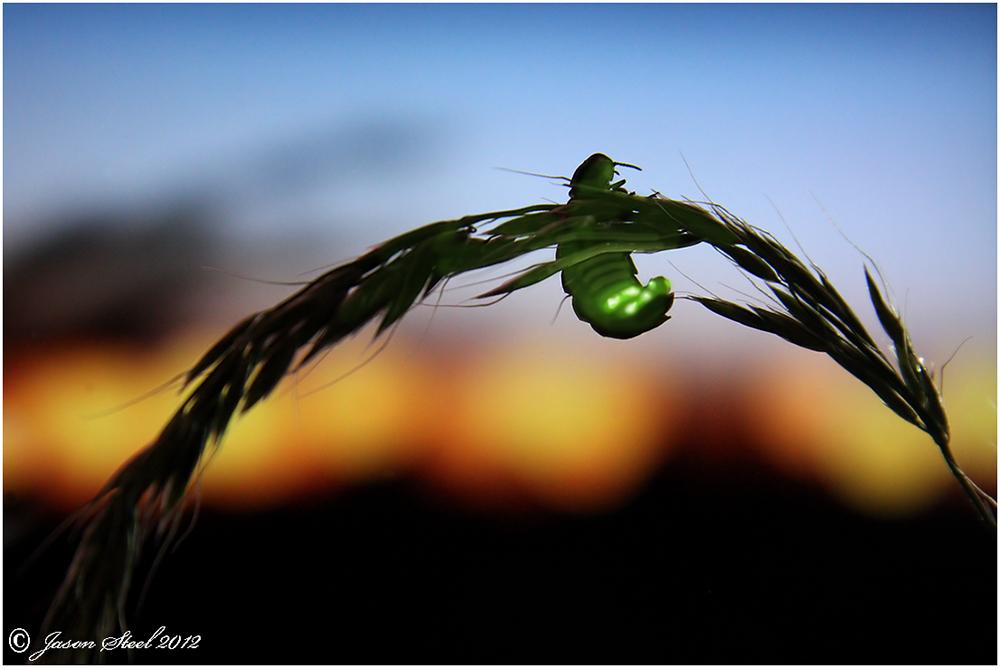
A female Glow Worm (Lampyris noctiluca)
Glow Worm - (Lampyris noctiluca)
The Glow Worm isn't a worm at all. It is in fact a beetle, usually about 15mm in length in adult form. The Glow Worm starts life as one of a 100 or so eggs that develop into larvae. When they transform into an adult the female retains a larvae form whilst the male turns into a flying beetle. During the mating season the female climbs to the top of tall grass stems or lays on the ground on her back and emits a bright green glow from the last three segments of her body. This glow is about as bright as a green LED you'd find on electrical appliances. The males fly around looking for females glowing in the dark to mate with. Males do also have a very feint glow to the rear of their abdomen but it's no where near as bright and visible as the female's. The same is true for Glow Worms in the larvae stage. Even the eggs can emit a very feint glow on occasion. Glow Worms can be found from May - August with warm dry nights in June and July being the best time to see them from 10pm onwards. They are usually found in fields and along the edges of quiet countryside roads away from the light pollution caused by towns and street lights where the green glow can be easily spotted by males looking for a mating partner. Glow Worms and Fireflies are facing possible extinction around the world due to light pollution, habitat loss and the use of pesticides. See article here: SciTechDaily
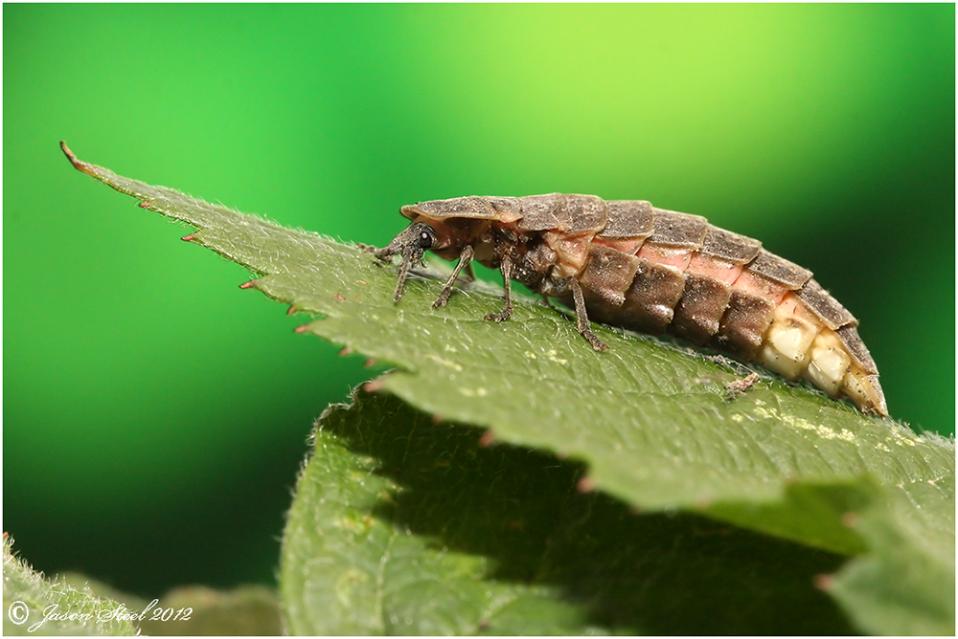
The glowing process of the female is a result of bioluminescence and the Glow Worm has total control over the glow emitted. It can be extinguished and rekindled at will. The Glow Worm produces a chemical called luciferin which when mixed with oxygen from the lungs of the Glow Worm results in the green glow effect.
The Glow Worm feeds mainly on small snails and has a neat trick up its sleeve to prevent the snail from retreating back into its shell. Before the Glow Worm attempts to eat the snail it administers an anaesthetic which renders the snail completely defenceless. It does this with a series of jabs using its tiny hooked mandibles that inject a small amount of this anaesthetic with each jab.
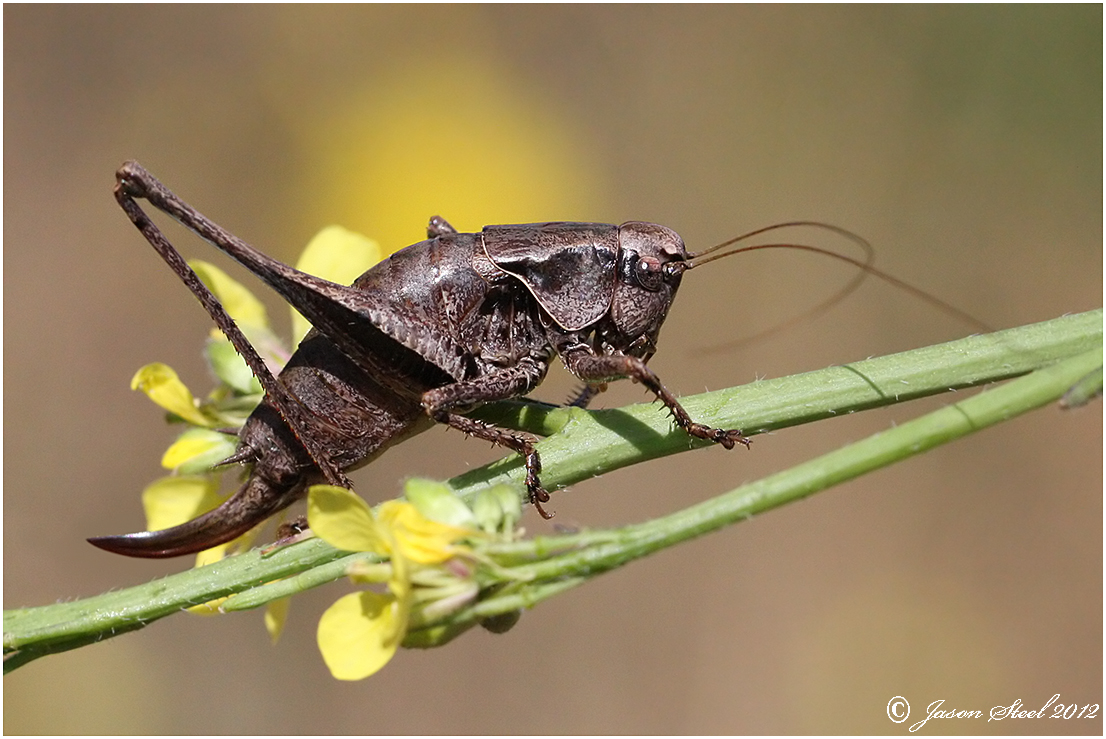
Adult female Dark Bush-Cricket, photographed in a grass chalk-land field in North Kent, 25/9/12.
Dark Bush-Cricket (Pholidoptera griseoaptera)
The Dark Bush Cricket is virtually wingless and grows to around 15 - 21mm. These crickets are stocky in build with hard bodies and an armoured appearance. The Dark Bush Cricket is common in England, especially in the south. As its name suggests it is usually dark brown or dark red with a yellow / green underbelly. It can be found in many types of habitat including wasteland, long grass, brambles, bushes, woodland and saltmarsh edges. Adults emerge in June-July and are around until the winter. They lay eggs in rotting wood and bark which take about 18 months to hatch. They are very active diurnal species and can be heard chirping all through the day and well into dusk. Males are very territorial and will often give an audible warning to other males before engaging in wresting with any intruders to their territory.
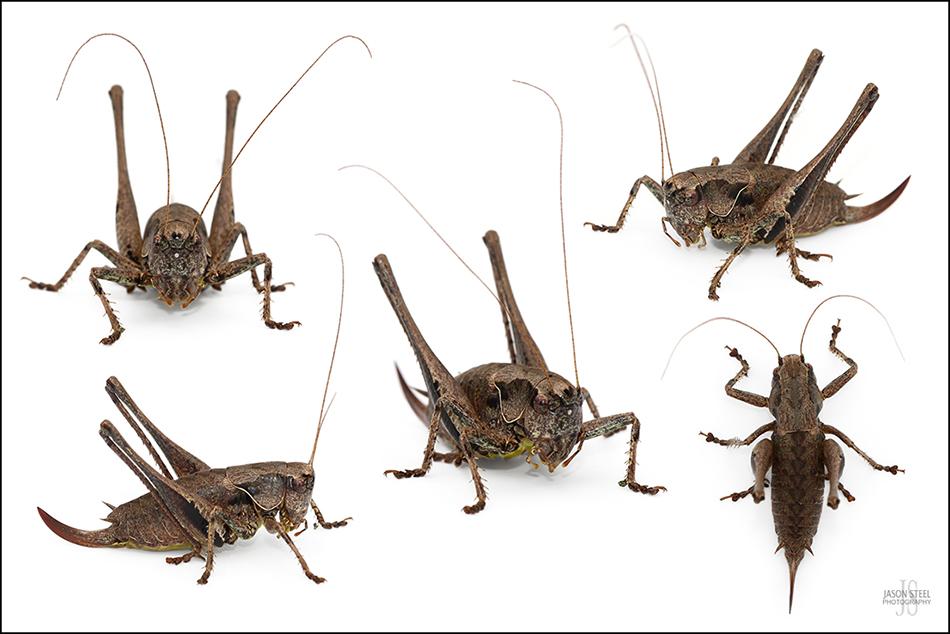
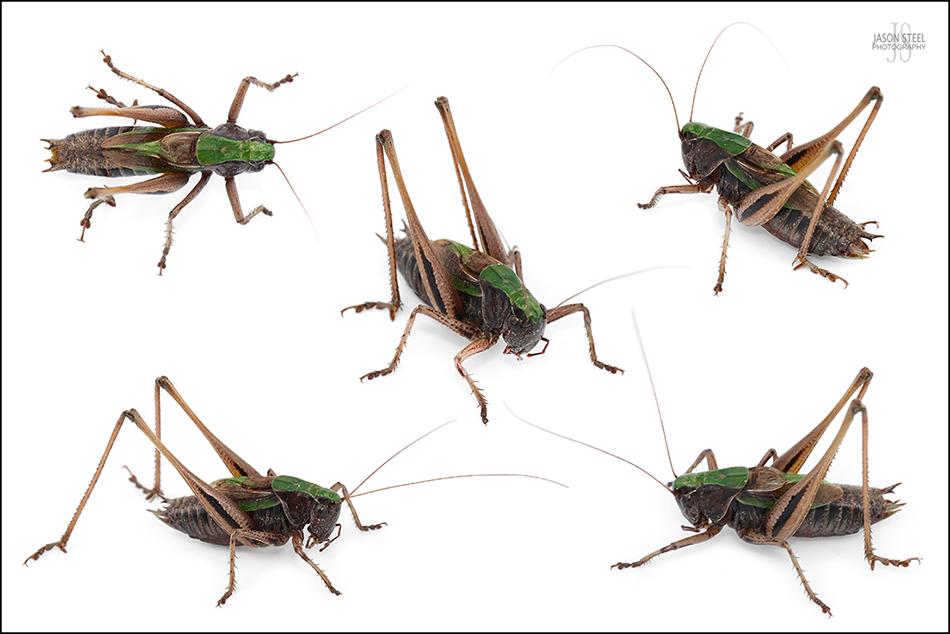
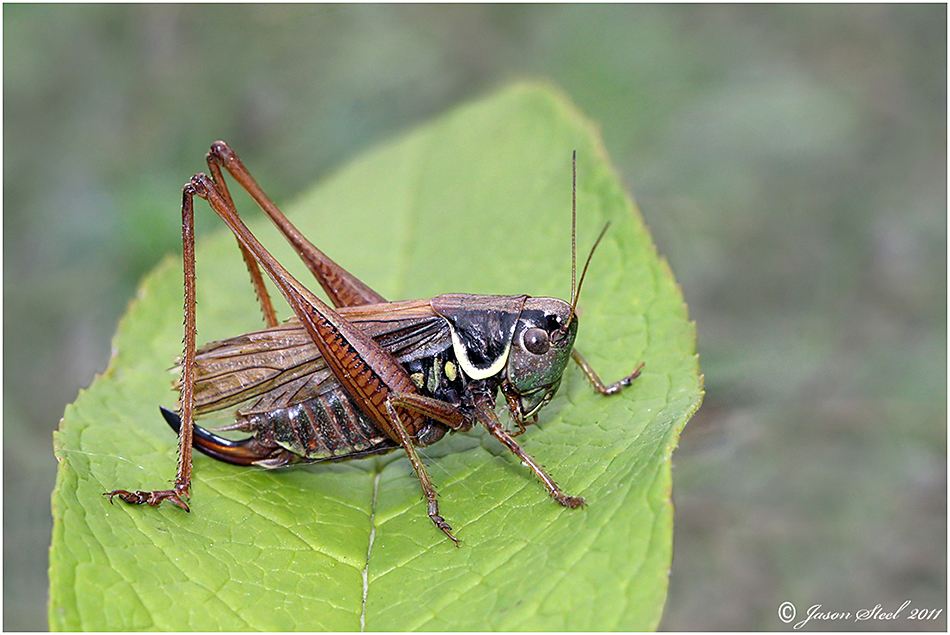
female Roesel's Bush Cricket
Roesel's Bush-Cricket (Metrioptera roeselii)
Growing to around 13mm - 26mm the Roesel's is one of 10 Bush Crickets found in Great Britain. They are found from June to October in rough grassland and damp meadows and are easily recognised by the yellow stripe or collar behind their head. Each type of Bush Cricket makes its own unique call by rubbing its wings together.
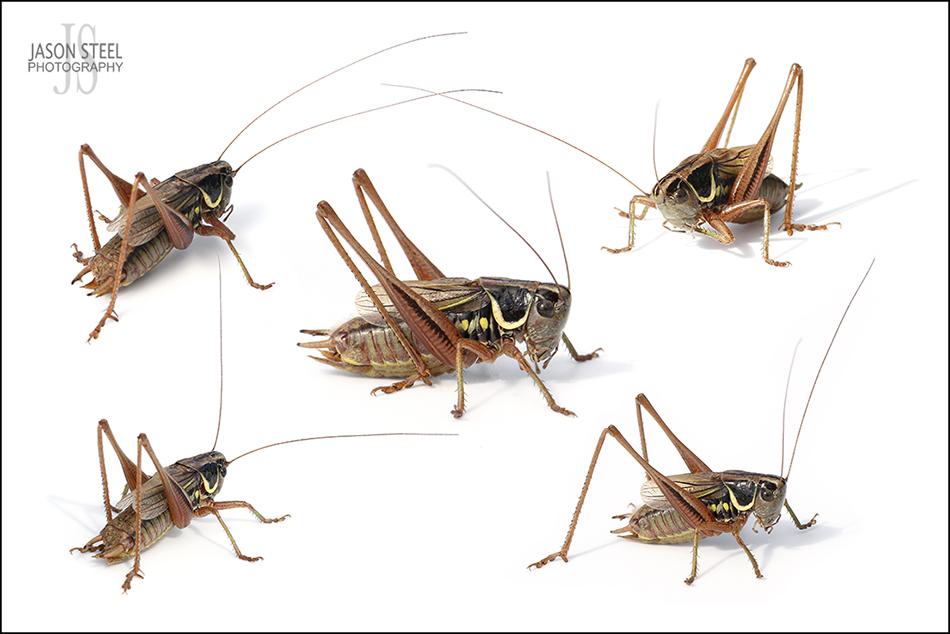
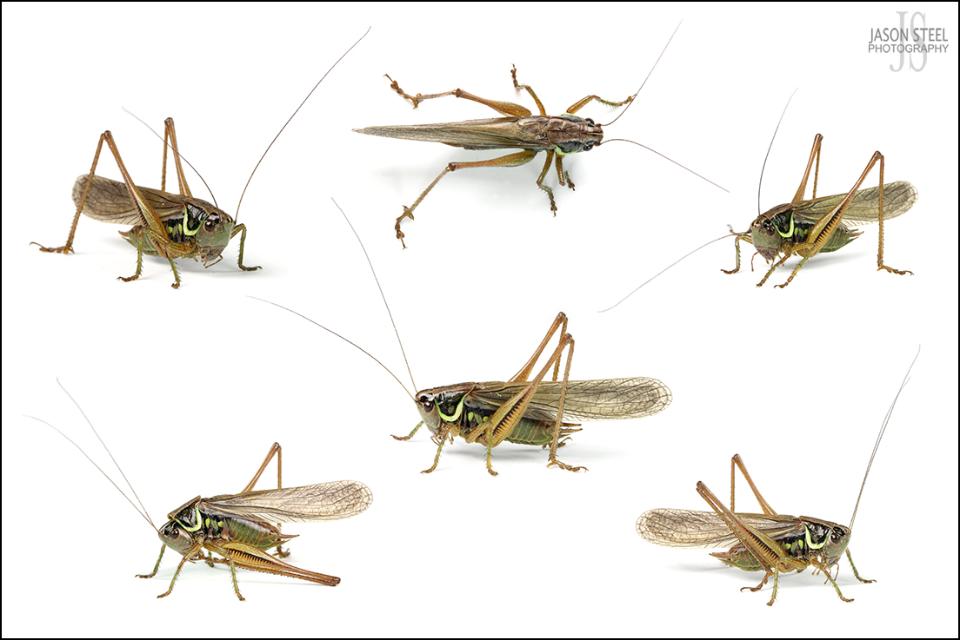
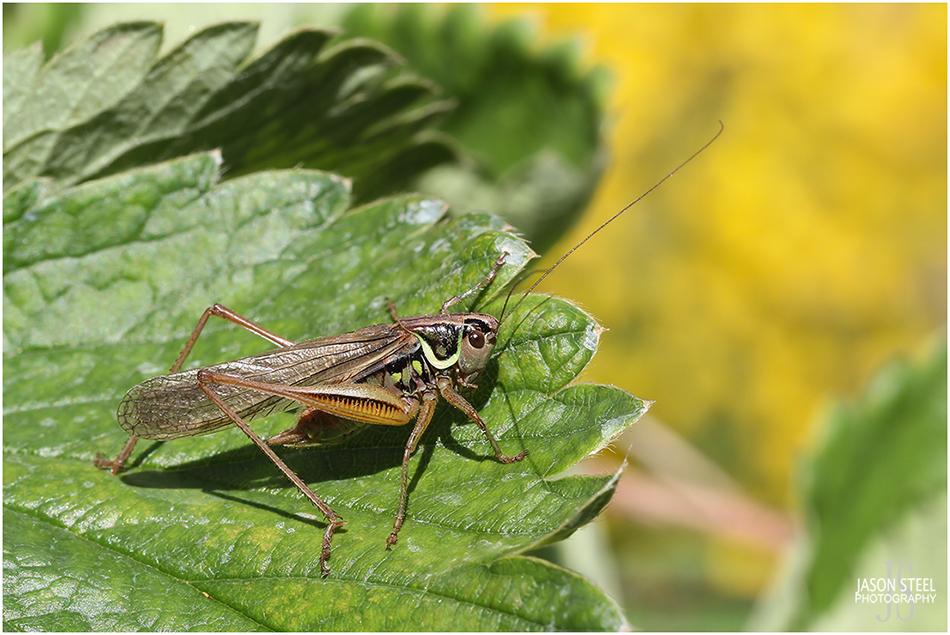
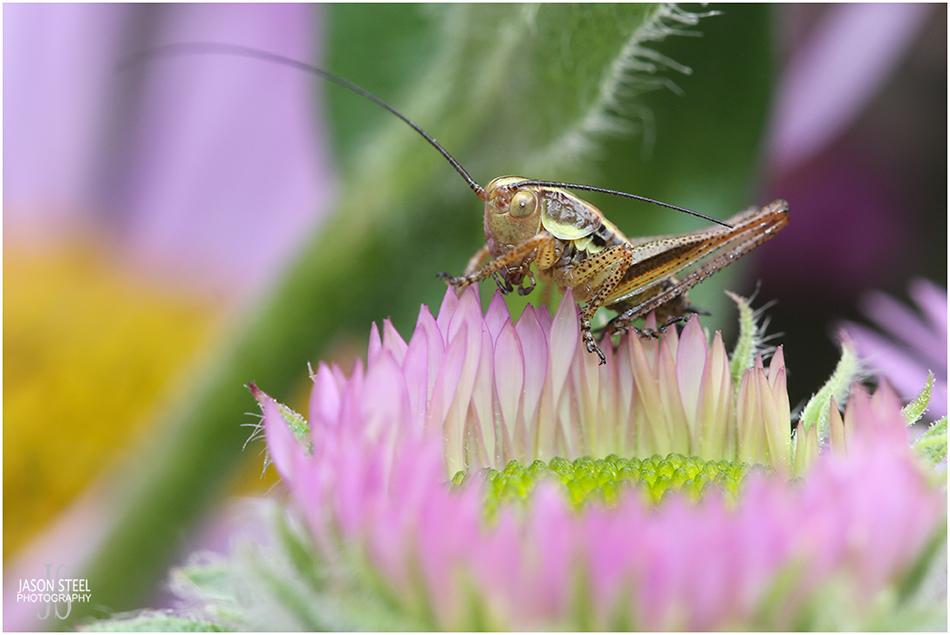
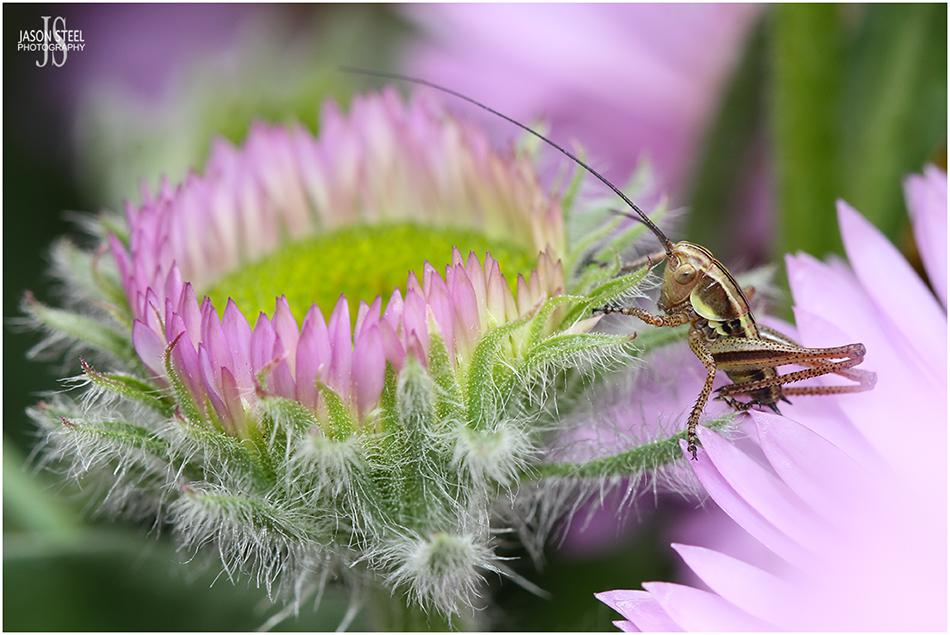
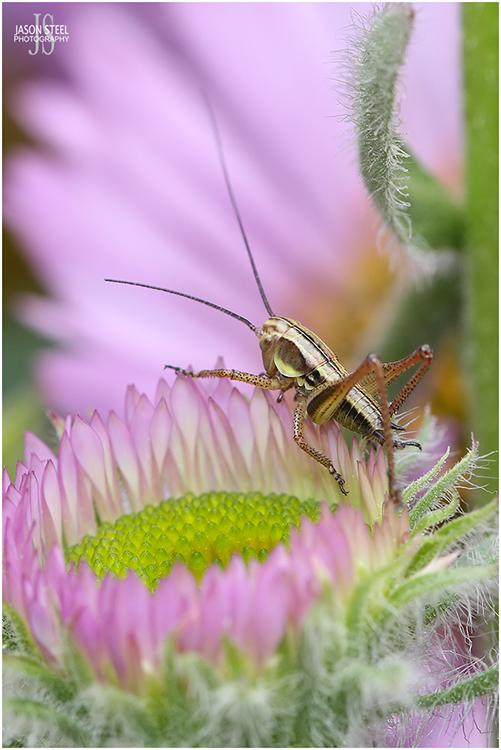

Bog Bush-Cricket
Another native bush cricket and growing to around 21mm. These are usually short-winged but there is a rare winged form. They can be found in green or brown but all have a bright green underside. They have long hind legs and long antennae. They are found across the UK but are more abundant in the south of England.
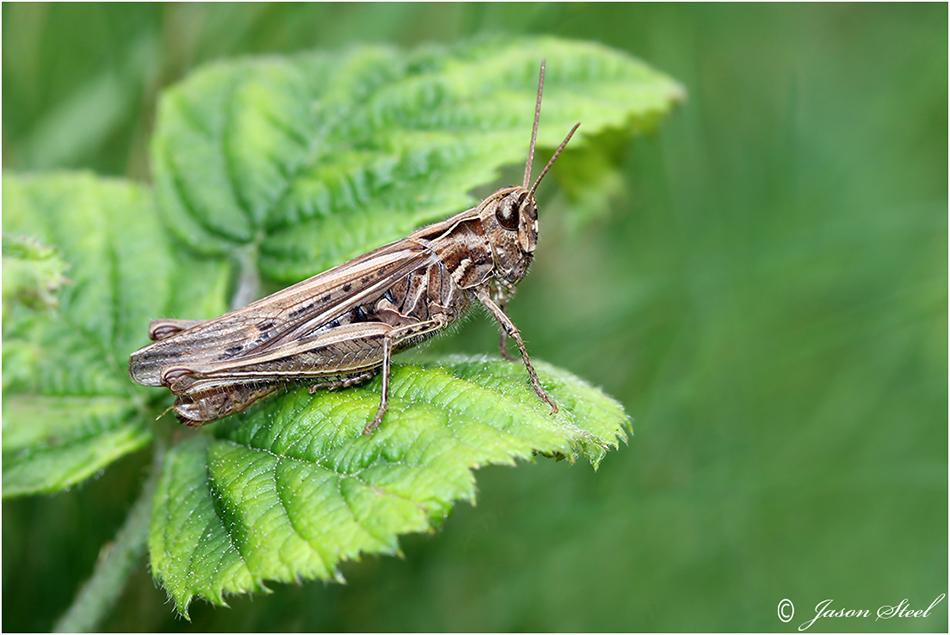
Grasshopper
During the summer it is almost impossible to walk through long grass without the familiar sight of Grasshoppers jumping away. Grasshoppers are from the same group of insects as crickets and locusts. They are found throughout the UK and are frequently encountered in gardens, especially if you have a wild area where the grass is allowed to grow. The most obvious feature of grasshoppers is their long rear legs, which enable them to jump well over 20 times their own body length. Although these powerful muscular legs give huge power for jumping they are also aided by a crescent-shaped organ found in the knee which is made from elastic fibres that store energy. This reserve of power is released as an explosion of energy when the Grasshopper needs to jump. Grasshoppers can be easily be distinguished from Crickets by two obvious features. Female crickets have a long ovipositor (egg-laying organ) at their rear which Grasshoppers do no possess. And Crickets have long antennae as opposed to the short antennae found on Grasshoppers. There are other differences too. Grasshoppers detect sound by small "ears" at the base of their abdomen. On Crickets these hearing organs are found on their front legs. Different Grasshopper species are sometimes easier to identify from their song rather than their appearance, and it is the males that sing far louder than the females.
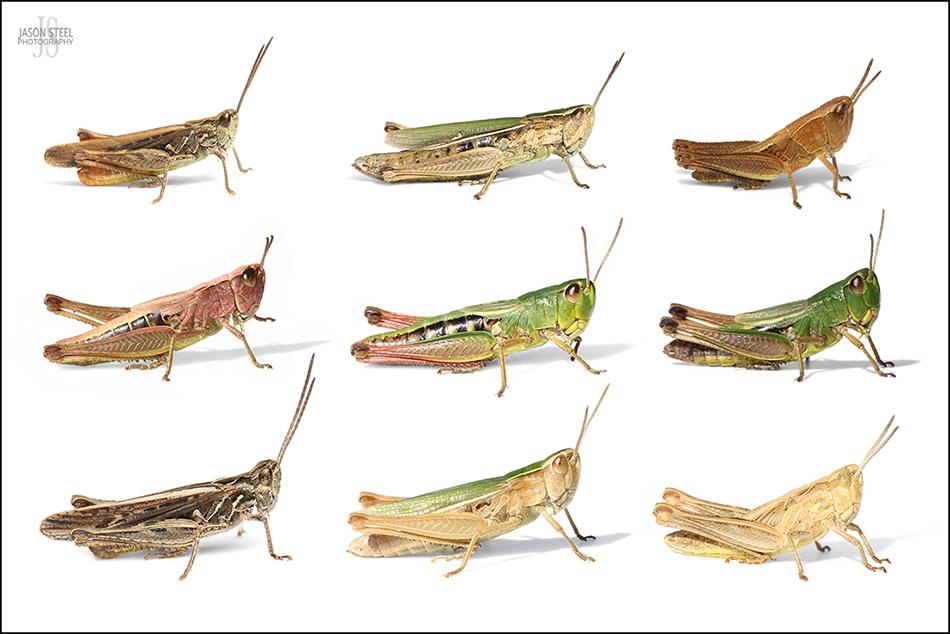
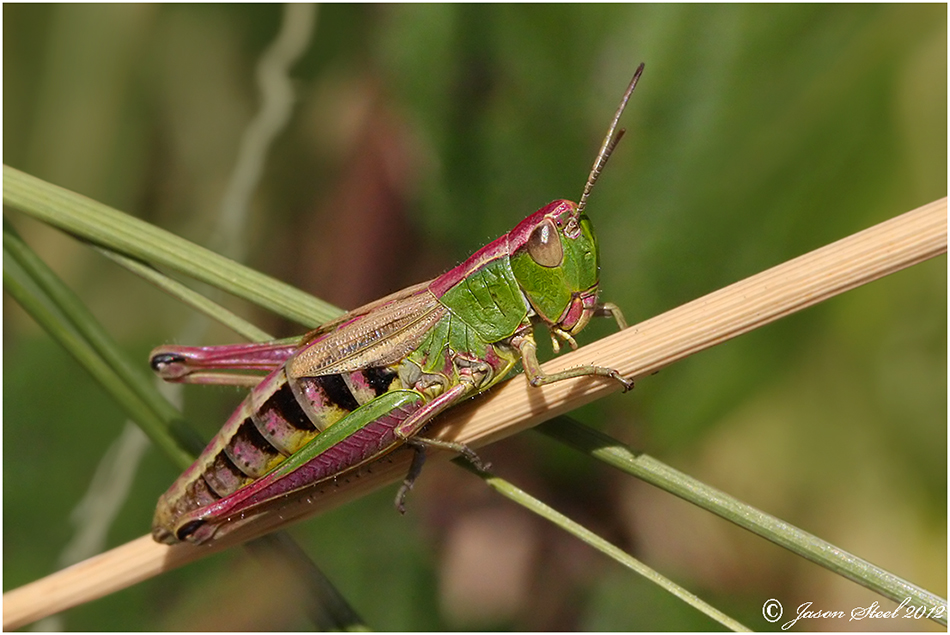
Meadow Grasshopper (Chorthippus parallelus)
The Meadow Grasshopper is the most common and widespread of UK grasshoppers and grows to a maximum length of around 22mm. This species is found across much of Europe as well as the USA and Asia. Although usually green or brown in colour sometimes genetic anomalies can occur particularly with the female. Meadow Grasshoppers can from time to time be found in an amazing array of colours including pink and purple. This is probably the most colourful example I've seen in the UK. Females are longer with short wing cases whilst males are shorter with longer wing cases. Both are usually flightless but occasionally in larger populations some grow longer wings and are able to fly. Those capable of flight can travel much greater distances and reach other colonies or new grazing areas. Eggs are laid just below the soil where they remain until they hatch the following spring.
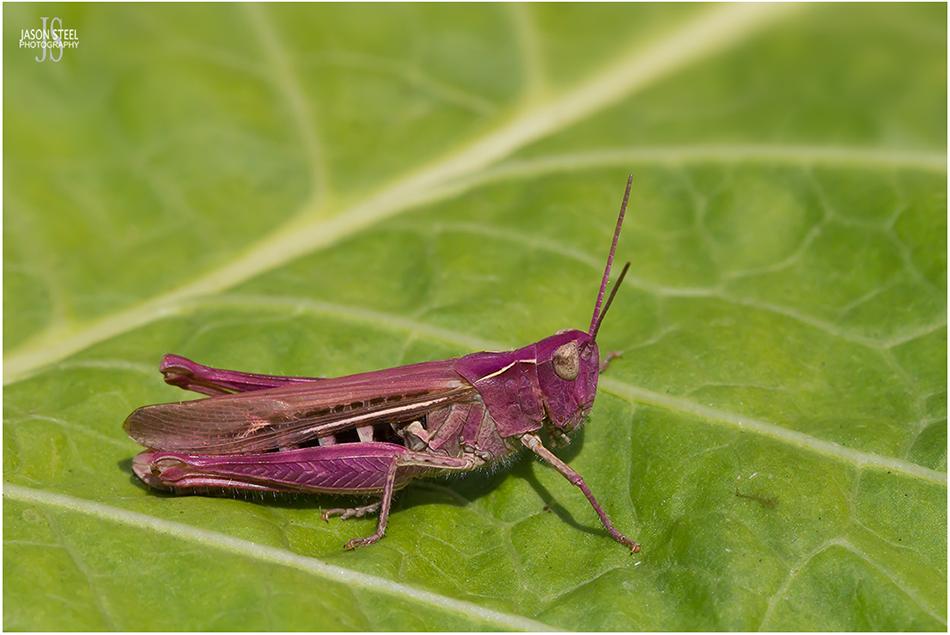
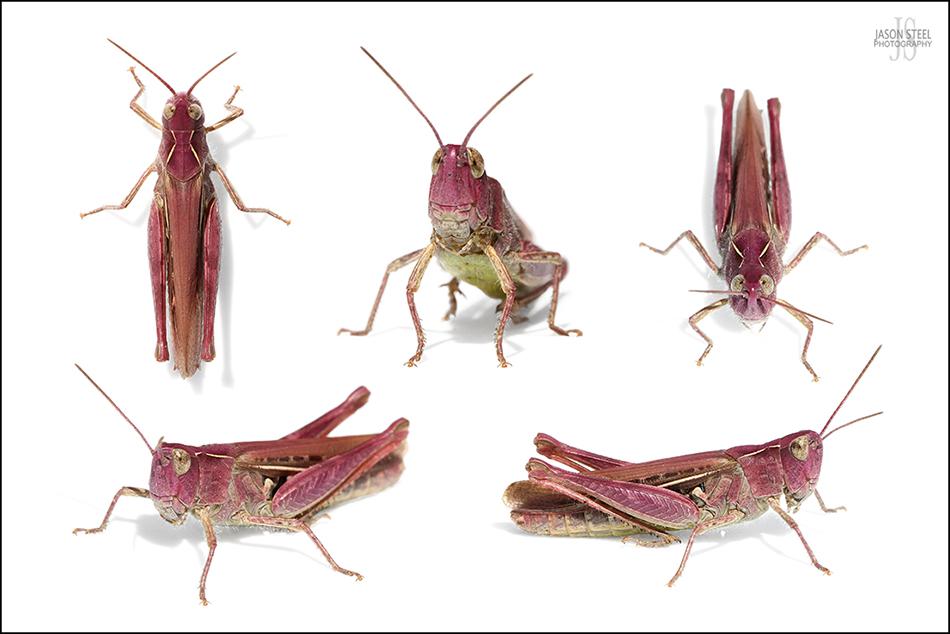
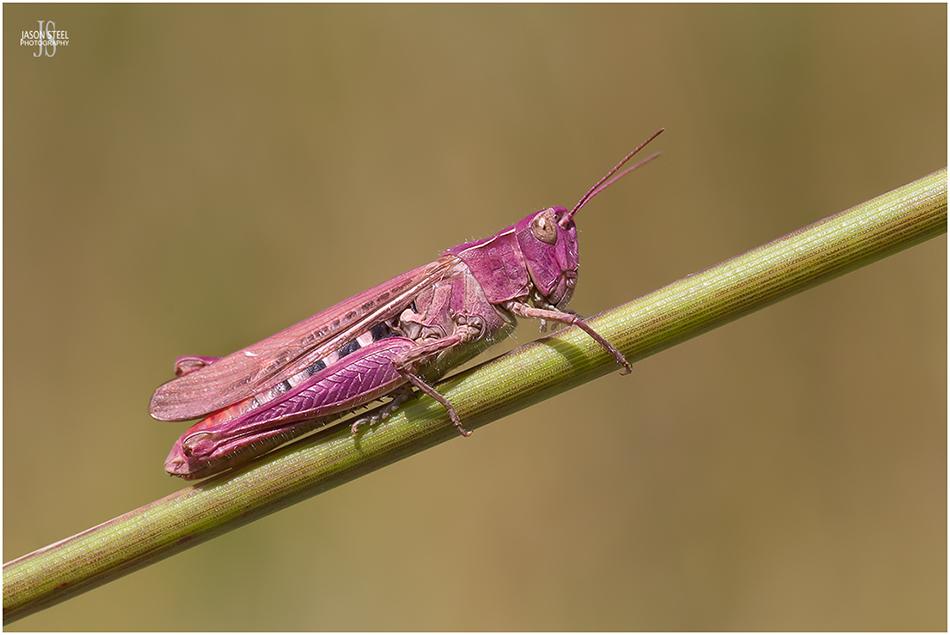
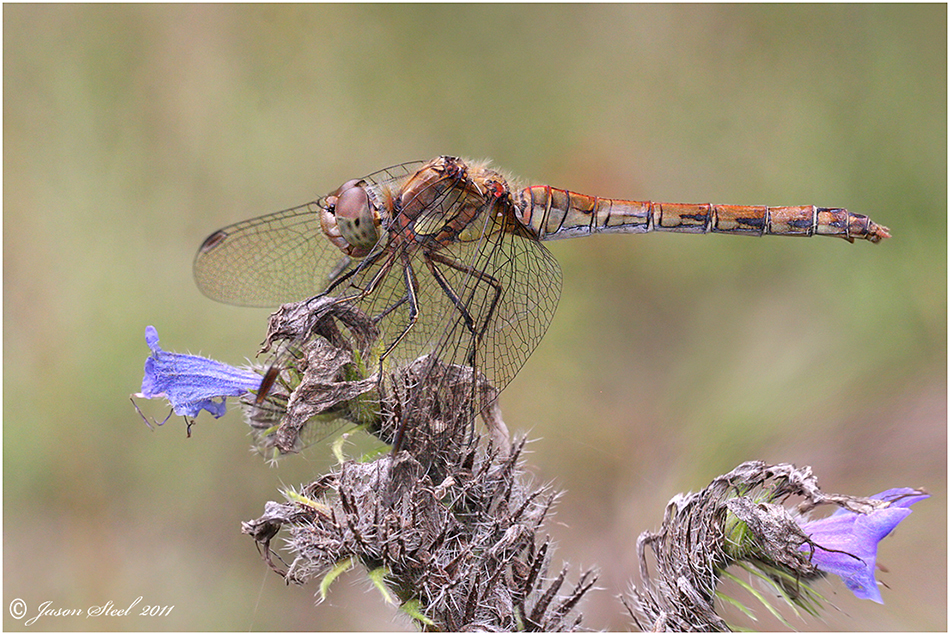
Common Darter Dragonfly (Sympetrum striolatum)
A medium sized dragonfly growing to a length of about 45mm. They are often the last dragonflies to be seen in the UK and can often be found well into November. They are widespread across much of the UK and are also often found quite some distance from water. They will feed mainly on other flying insects that they catch with their sudden bursts of speed. The Common Darter can range in colour from bright red, reddish brown, to brownish yellow. The short, squat larvae grow to around 15-18mm in length and can regularly be found in garden ponds and other small bodies of water, including stagnant or brackish water.
LINK 1 Identifying British Dragonflies See Pond Life page for photos of larvae
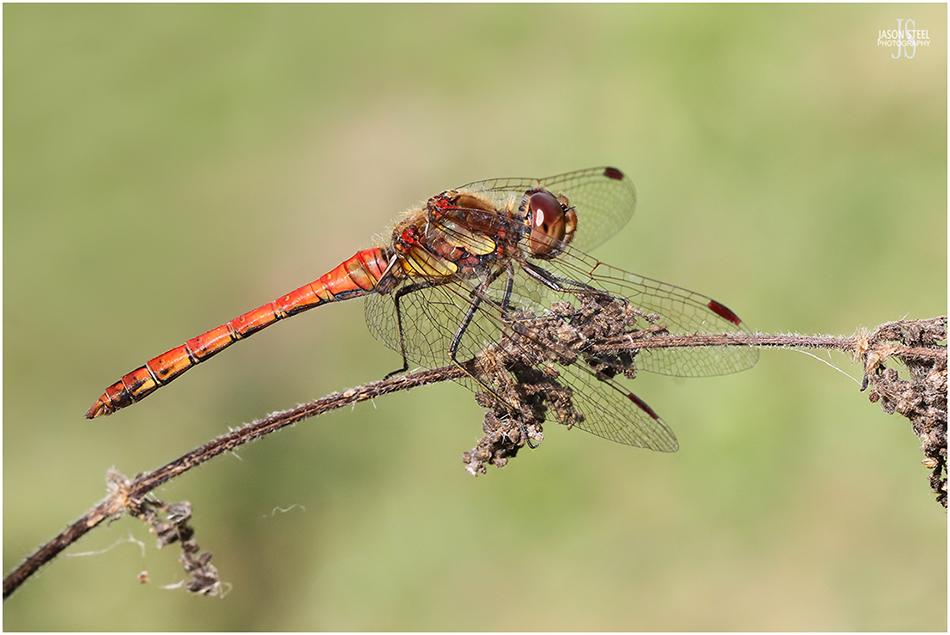
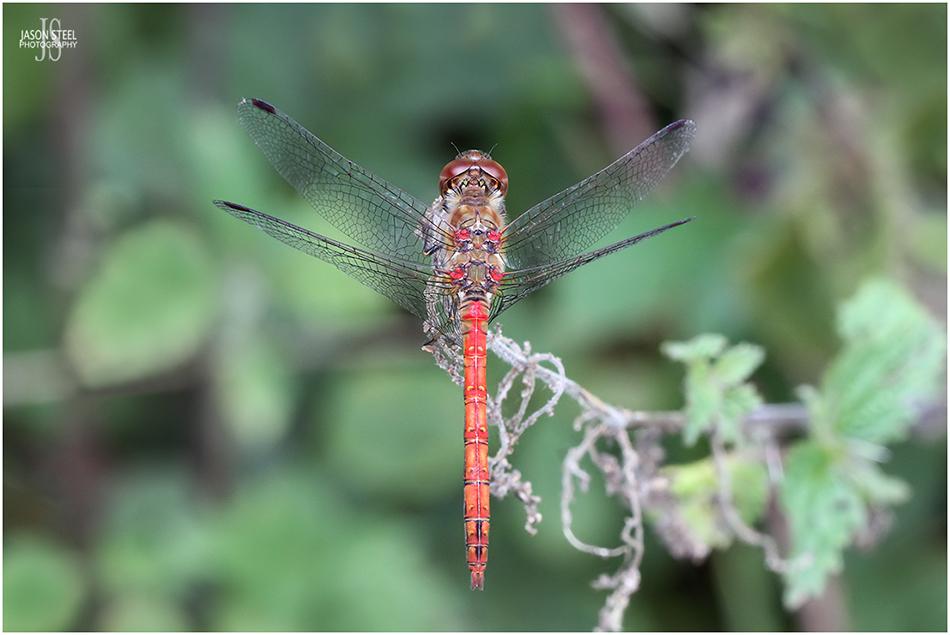
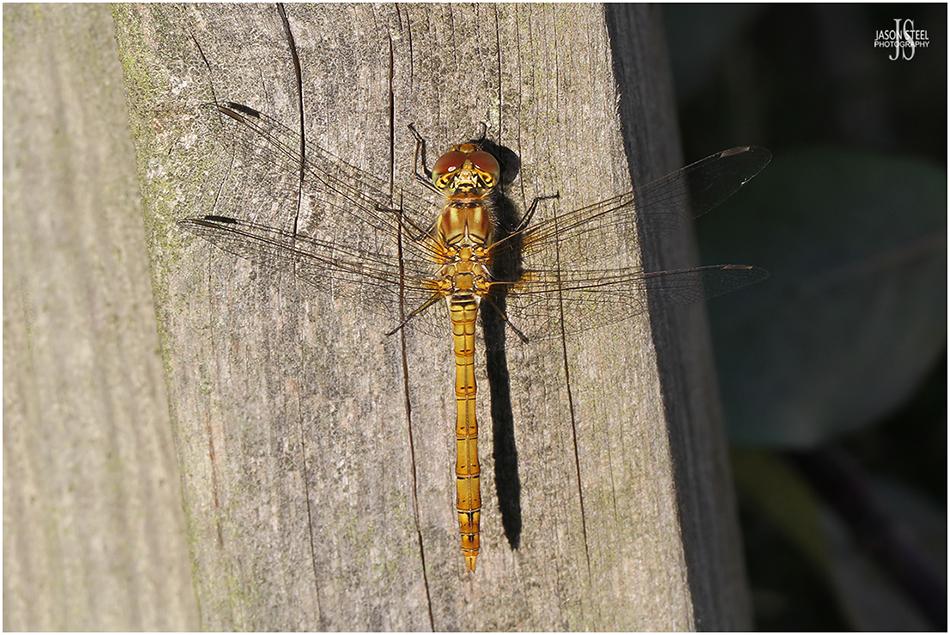
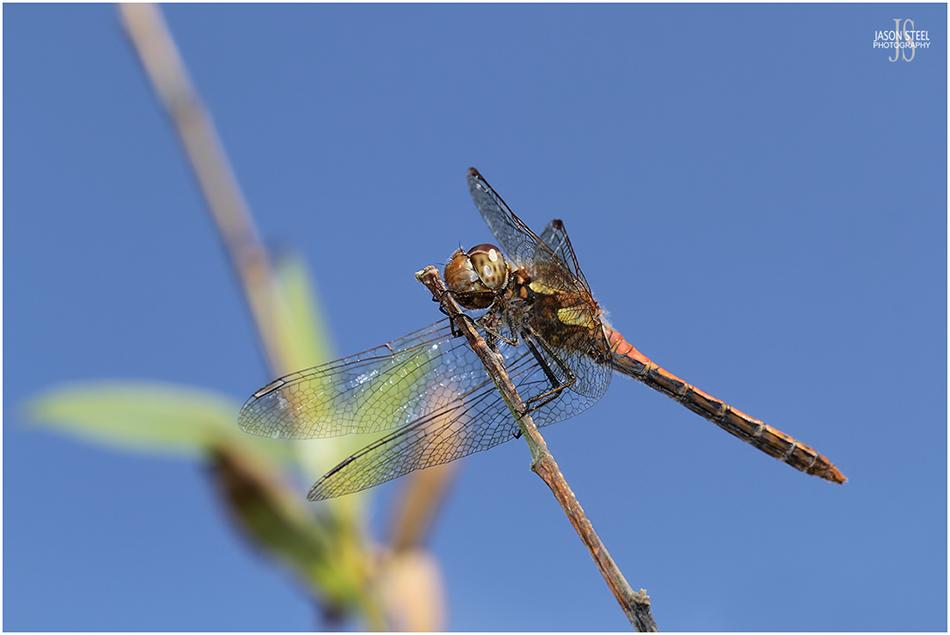
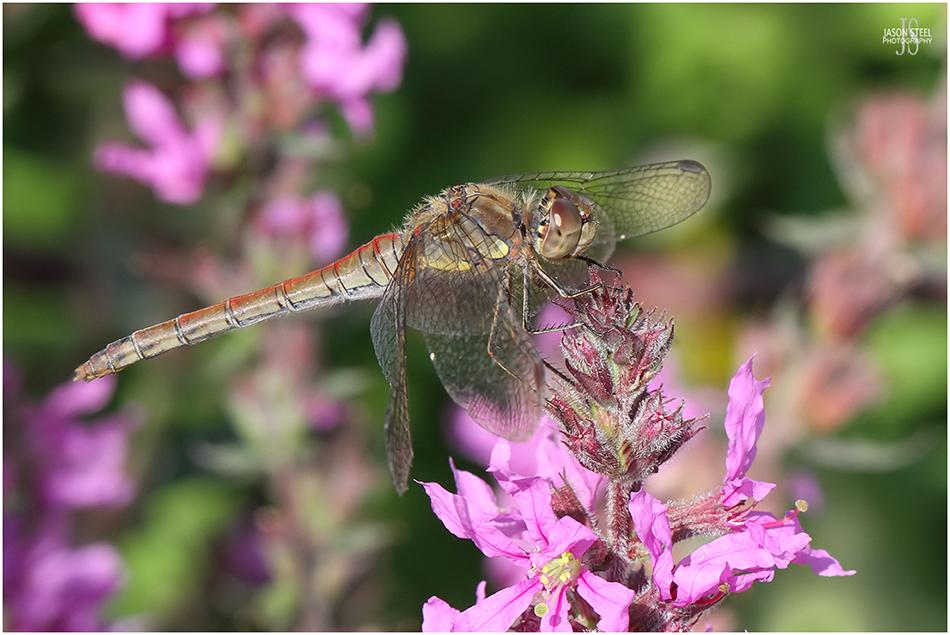
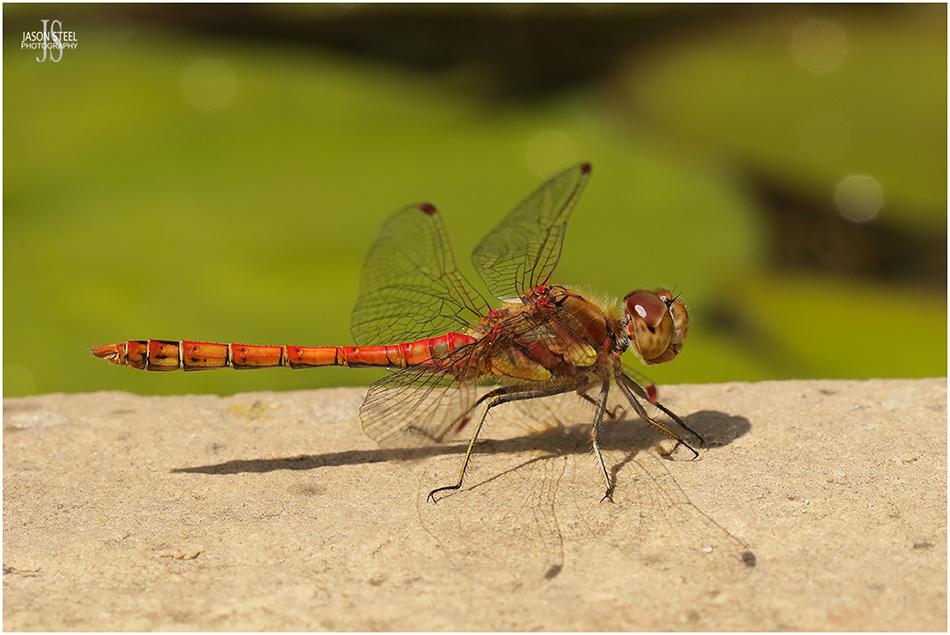
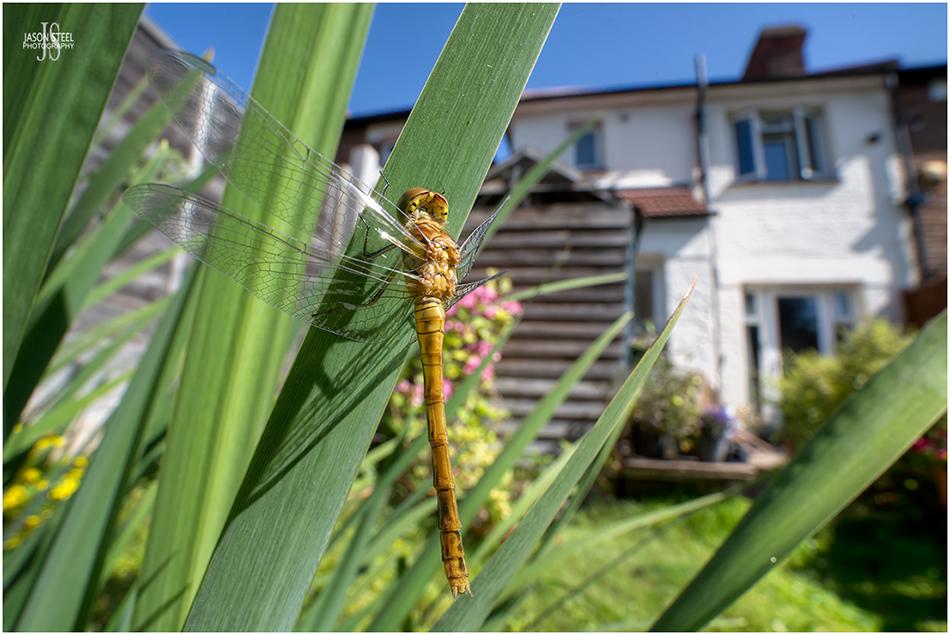
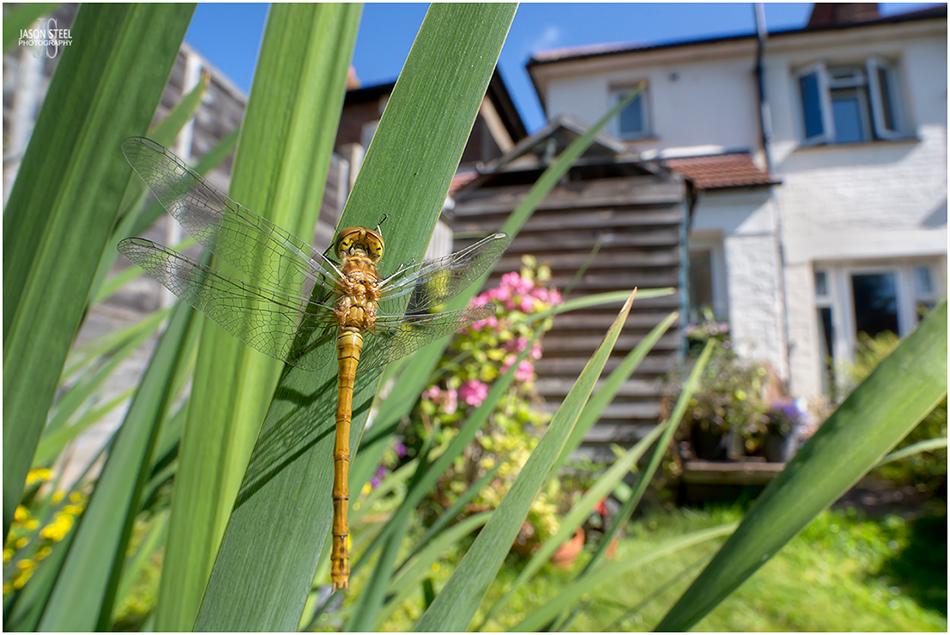
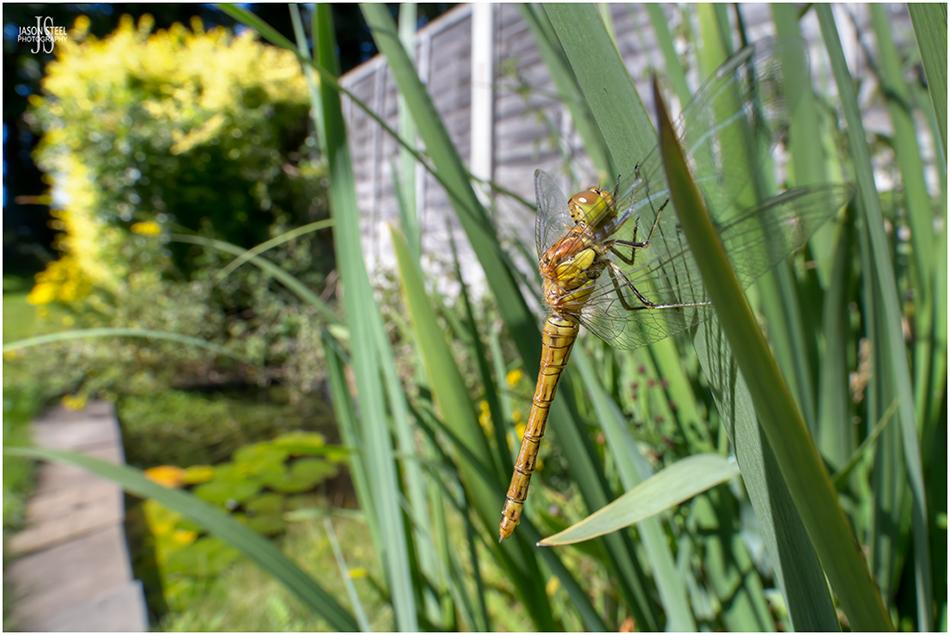
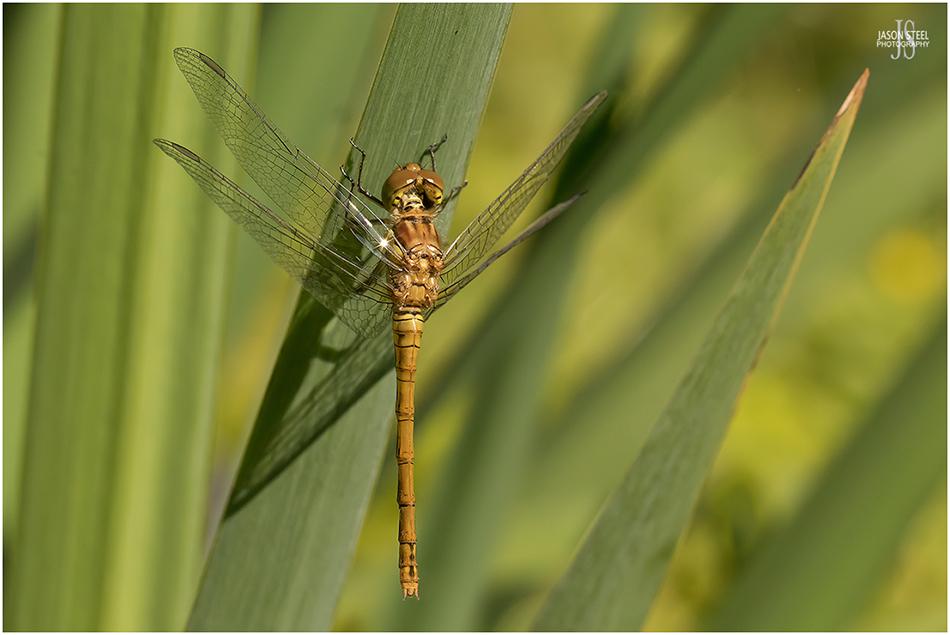
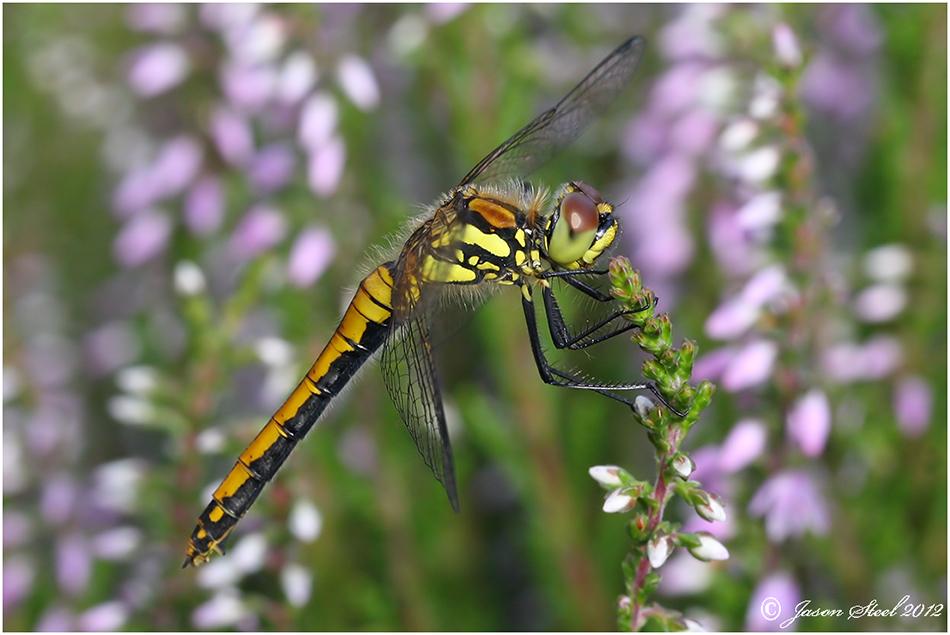
Female Black Darter Dragonfly, photographed in Christchurch, Dorset, 9th August 2012
Black Darter Dragonfly
A small heathland and moorland dragonfly usually growing to a length of 29-34mm and commonly spotted in late summer across the UK. These are Britain's only black dragonfly. The males turn almost completely black with age but the females pictured above usually have bright yellow markings on the upper and sides of the abdomen which become browner with age. Both sexes have completely black legs.
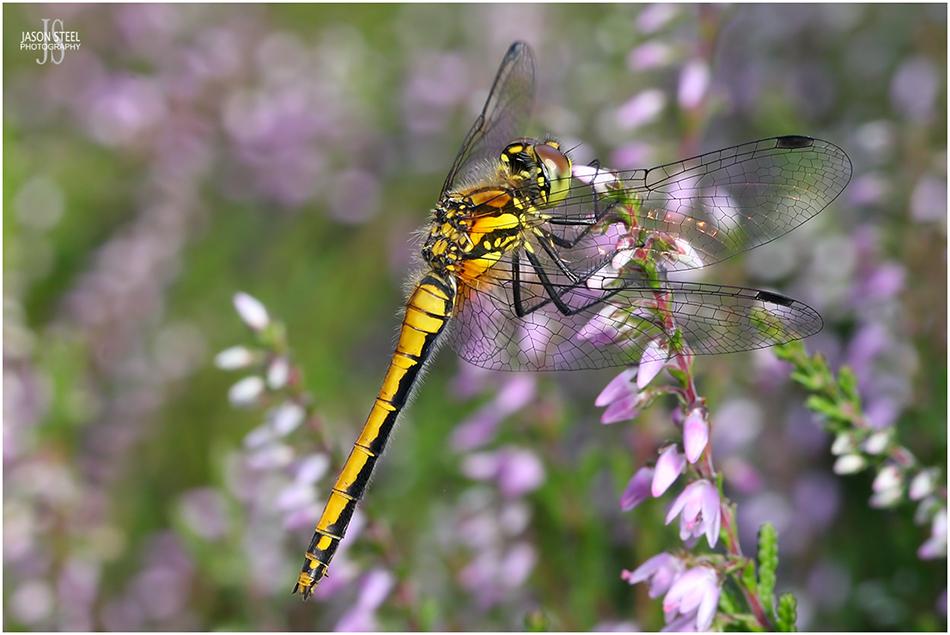
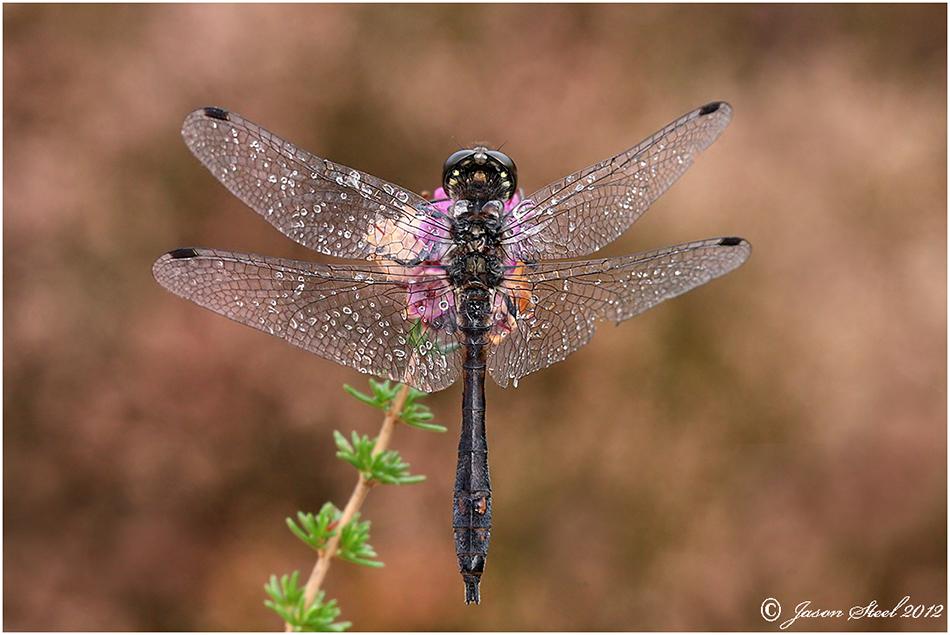
Male Black Darter Dragonfly
This male Black Darter Dragonfly basks in the sun to dry its wings after being caught in a short rain shower. Its wings vibrate rapidly to warm the Dragonfly up and help the drying process.
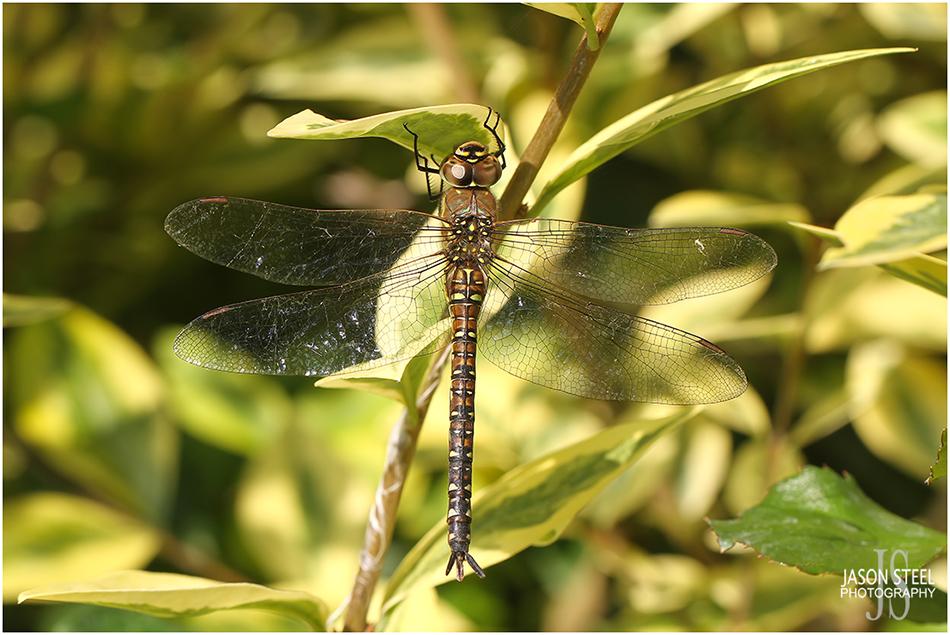
Female Migrant Hawker warming its wings at the start of the day.
Migrant Hawker Dragonfly (Aeshna mixta)
A medium / large dragonfly with a wingspan of around 80mm and a body-length of 65mm. This species is common in Southern England and takes to the wing from late July to early November. The females are brown with yellow marking and the males tend to be brown / black with blue markings. Usually seen flying over freshwater lakes, rivers and streams. They are also found around garden ponds. The larvae take from 1 - 2.5 years to develop in the water, and adult dragonflies are short-lived and usually only last for around two months. Hawkers are the largest dragonflies in the UK and most powerful of fliers. They catch their prey mid-air and can hover of fly backwards with amazing acrobatic skills. Unlike many other species of Dragonfly Migrant Hawkers are not particularly territorial and it's not unusual to see groups of these Dragonflies hunting over the same body of water.
Migrant Hawkers can easily be confused with other Hawker species, particularly the Common Hawker (Aeshna juncea). Common Hawkers, whose alternate and better suited name is the Moorland Hawker, are rarely found far from moors and bogs. One distinguishing feature of the Migrant Hawker is the strong yellow nail mark on the S2 segment of the abdomen. Migrant Hawkers also have short yellow ante-humerals / shoulder marks. There's an excellent guide to distinguishing Hawker species here.
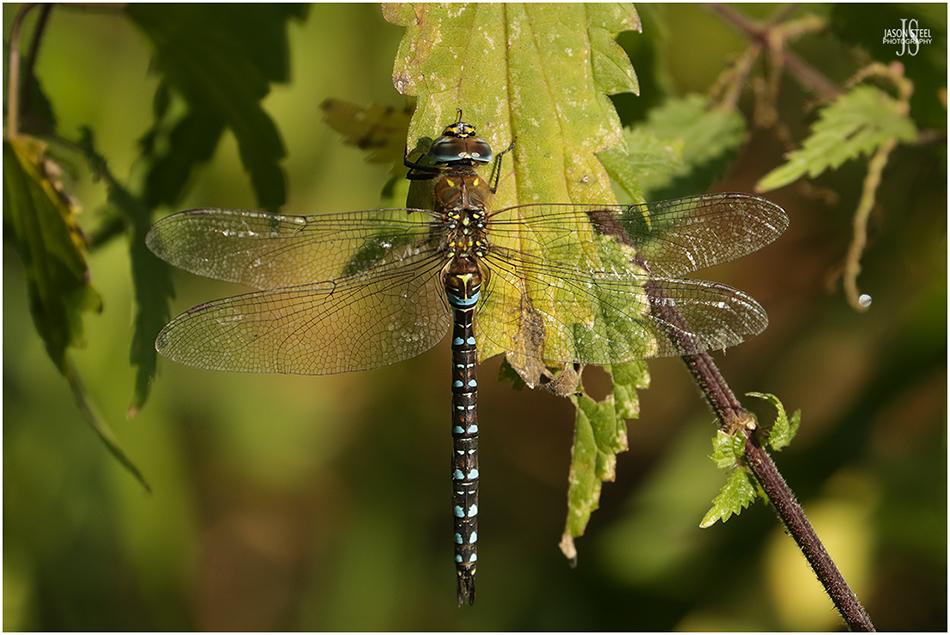
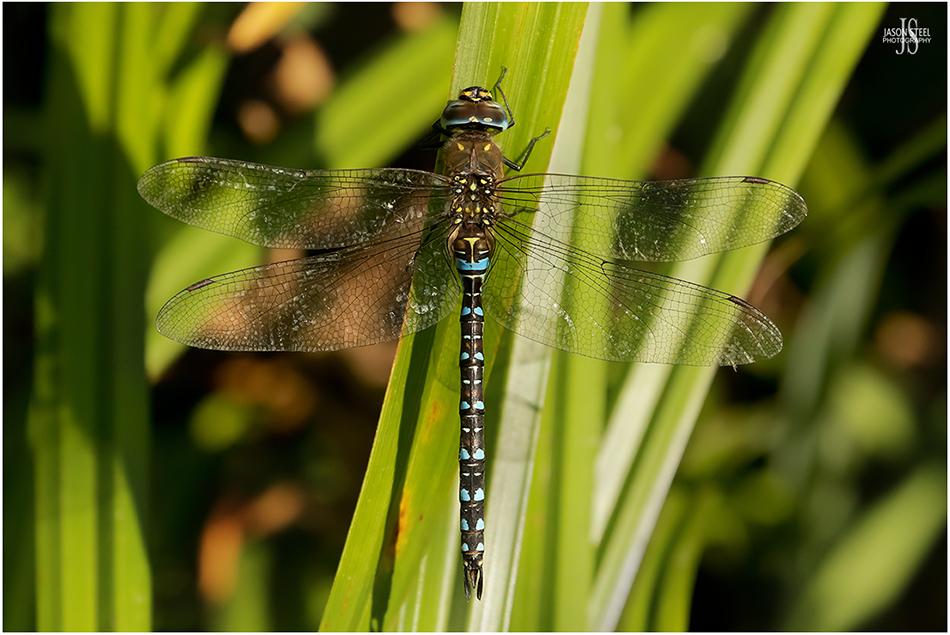
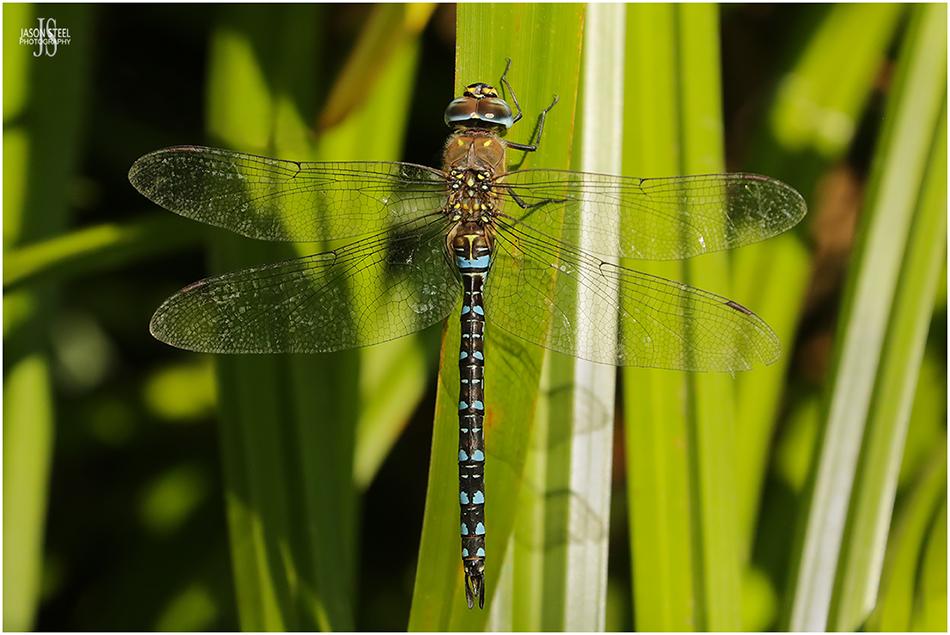
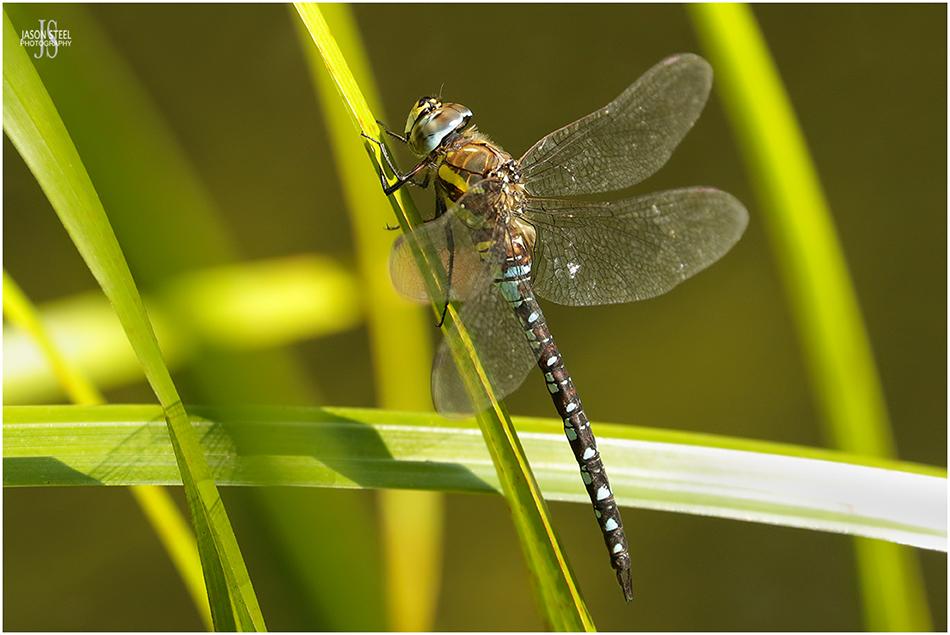
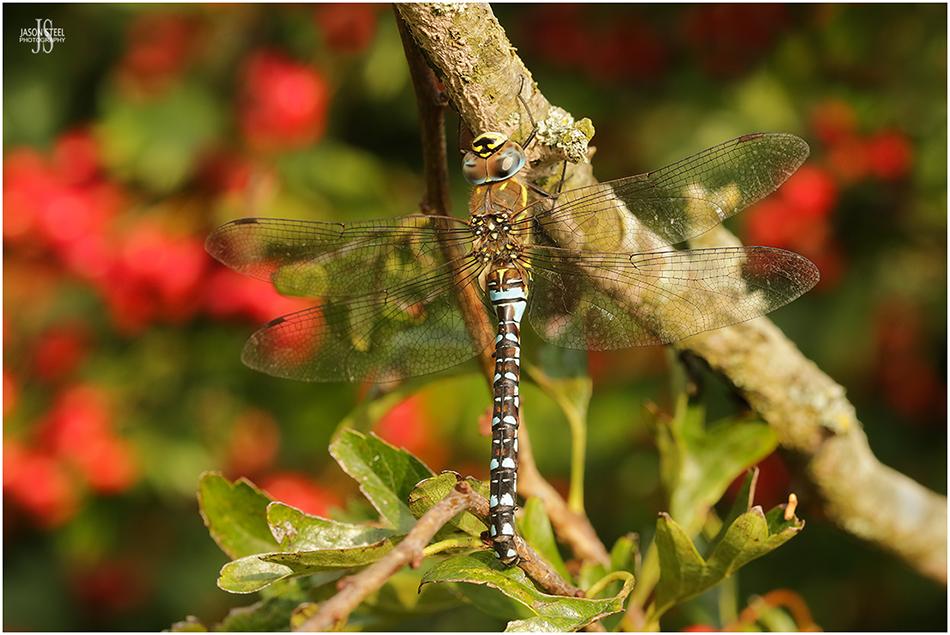
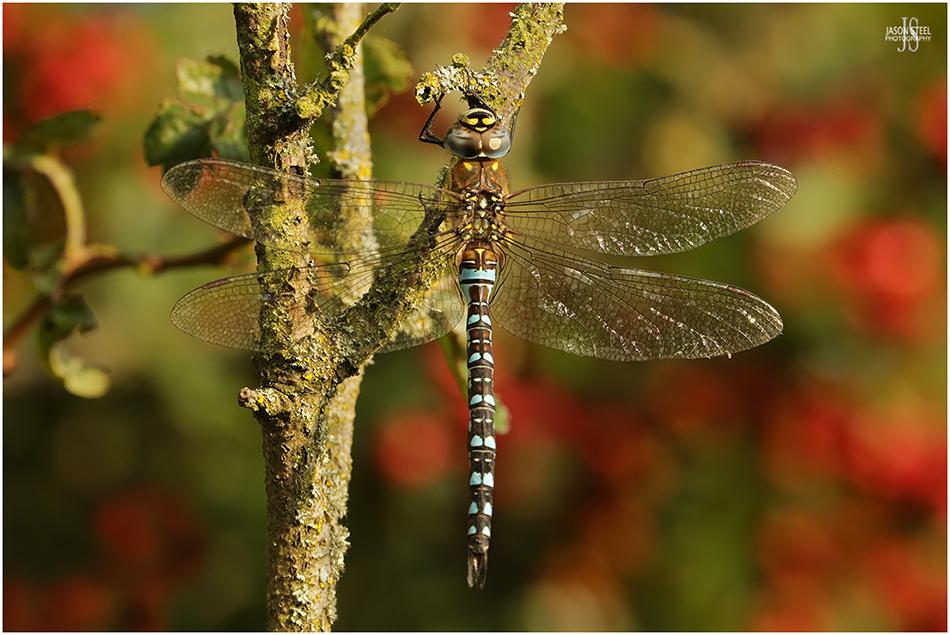
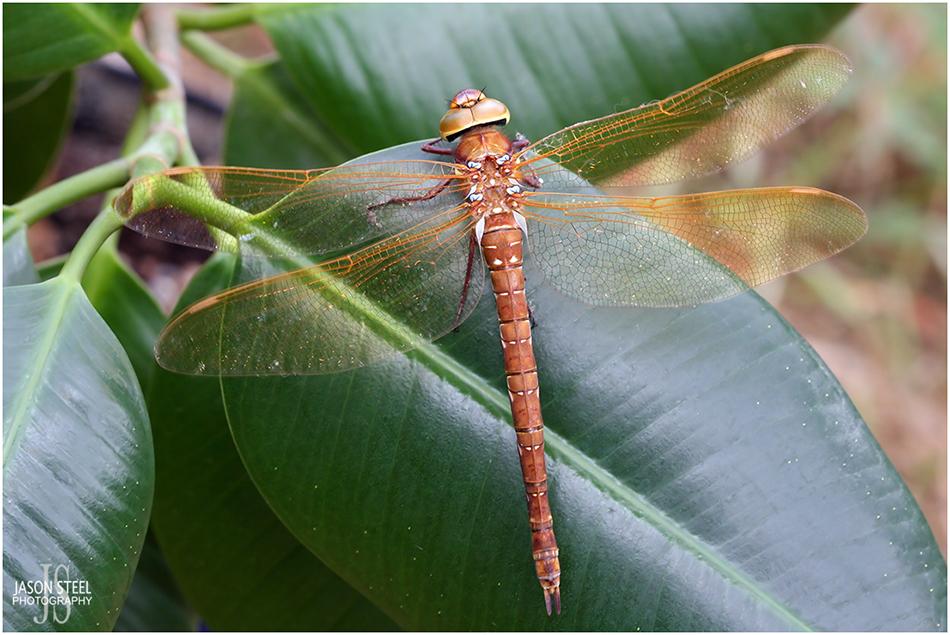
Female Brown Hawker Dragonfly.
Brown Hawker Dragonfly (Aeshna grandis)
A large dragonfly with a wingspan of 80mm to 102mm and a body-length of 70-77mm. his species is common and widespread in England and Wales but is scarce in the very west of both countries. It takes to the wing from July to September but can on occasion be seen from June to October. Both sexes have a brown abdomen with yellow stripes on the side. The golden brown wings makes this an easy species to identify. The Brown Hawker is powerful in flight and tends to glide and soar above ponds and smaller bodies of water. Males can be identified by a constricted waist.
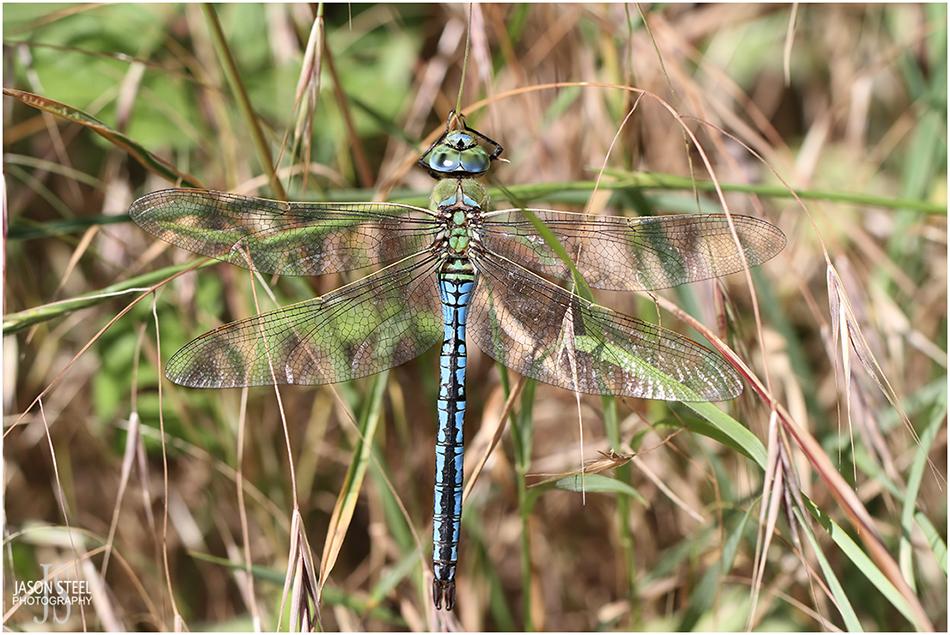
Male Emperor Dragonfly.
Emperor Dragonfly (Anax imperator)
Britain's bulkiest dragonfly with an average wingspan of around 106mm and occasionally 120mm. They have an average body-length of 78mm. This species is common in Southern England and Southern Wales and takes to the wing from June to August but can on occasion be seen from May to September. The females are green or blue with dark central line and the males tend to be blue with a dark central line. Usually seen flying over large ponds with plenty of vegetation, canals and slow moving rivers. Emperor Dragonflies often fly with their abdomen bent slightly downwards. They will often hover above the water before darting at great speed tin pursuit of their prey. Larvae grow to 56mm with brown colouration and huge eyes.
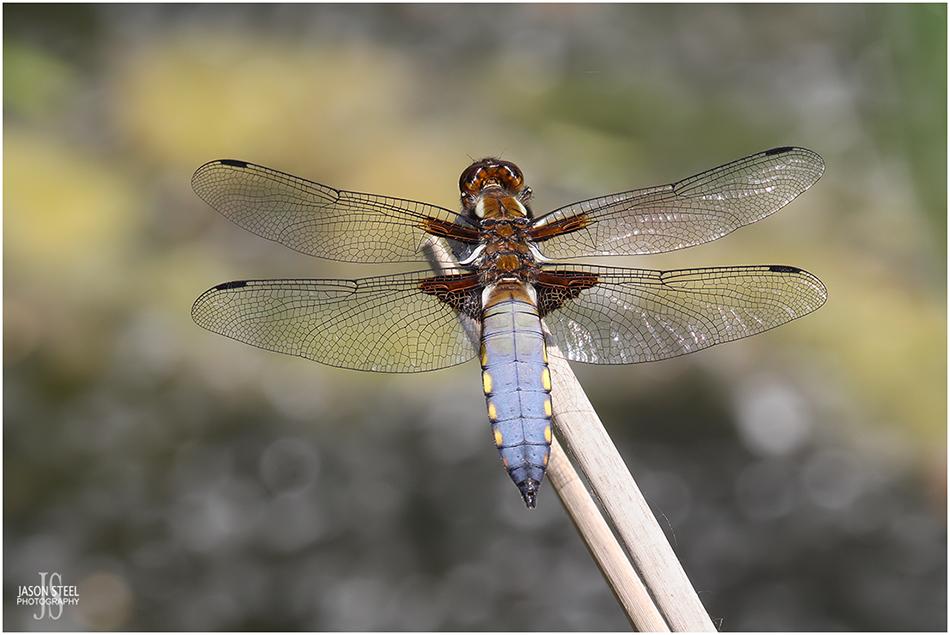
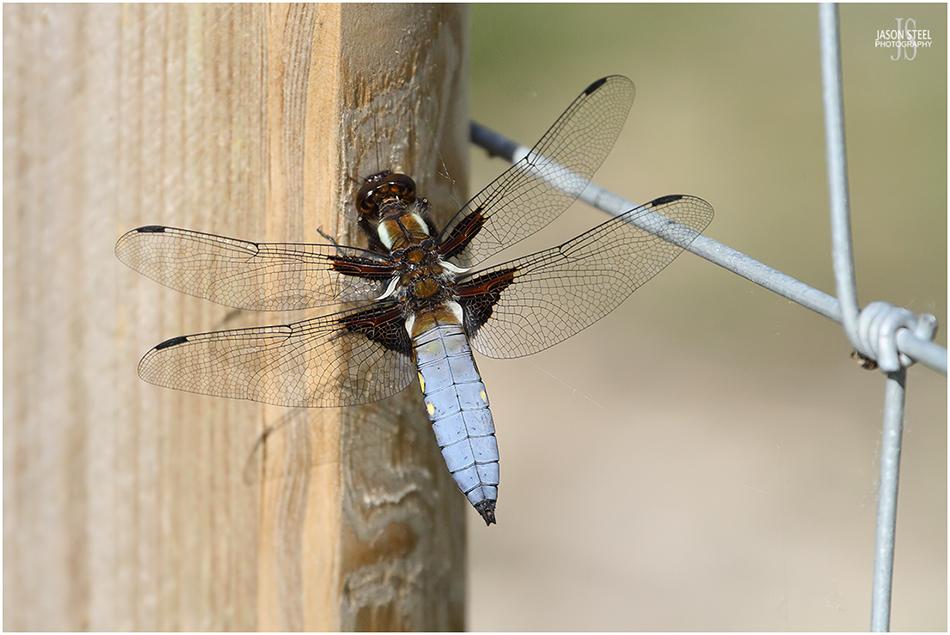
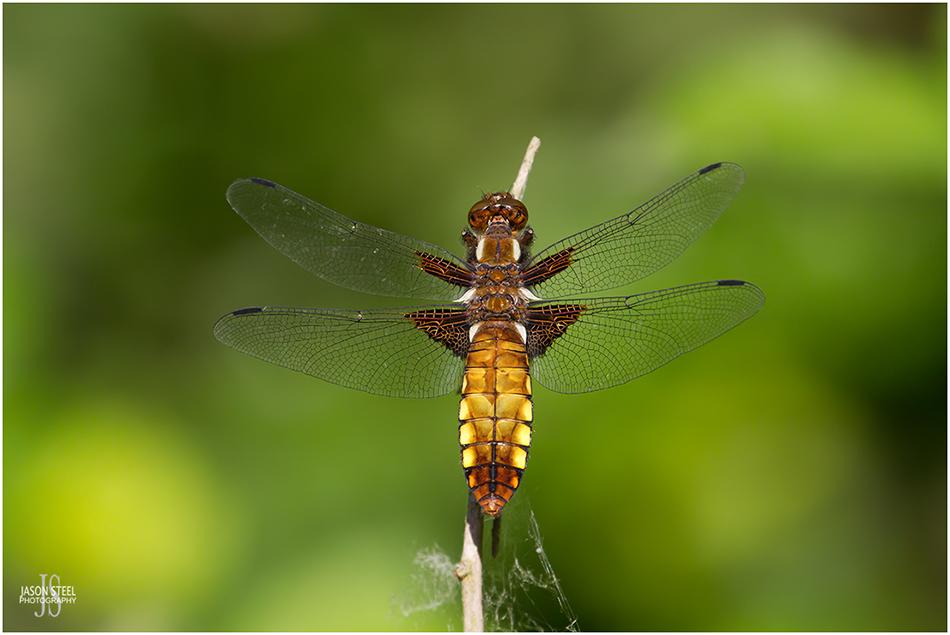
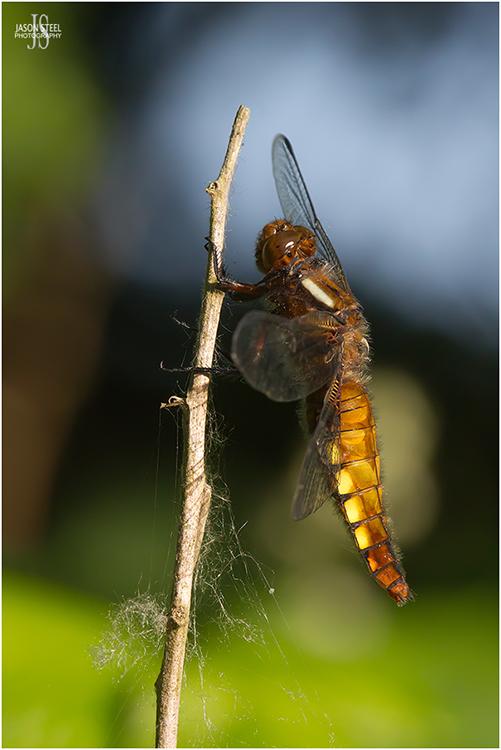
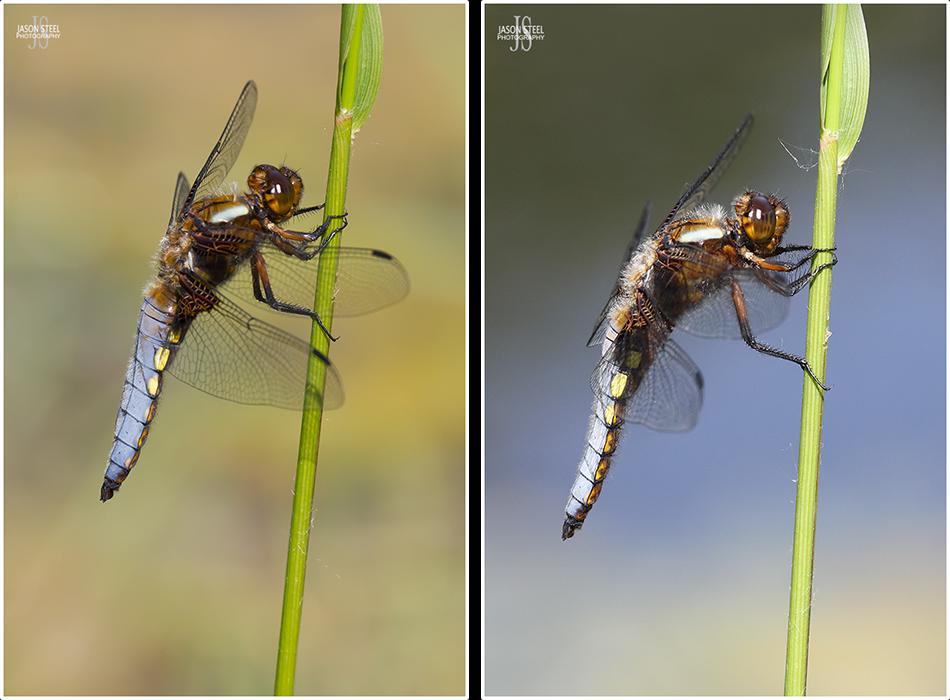
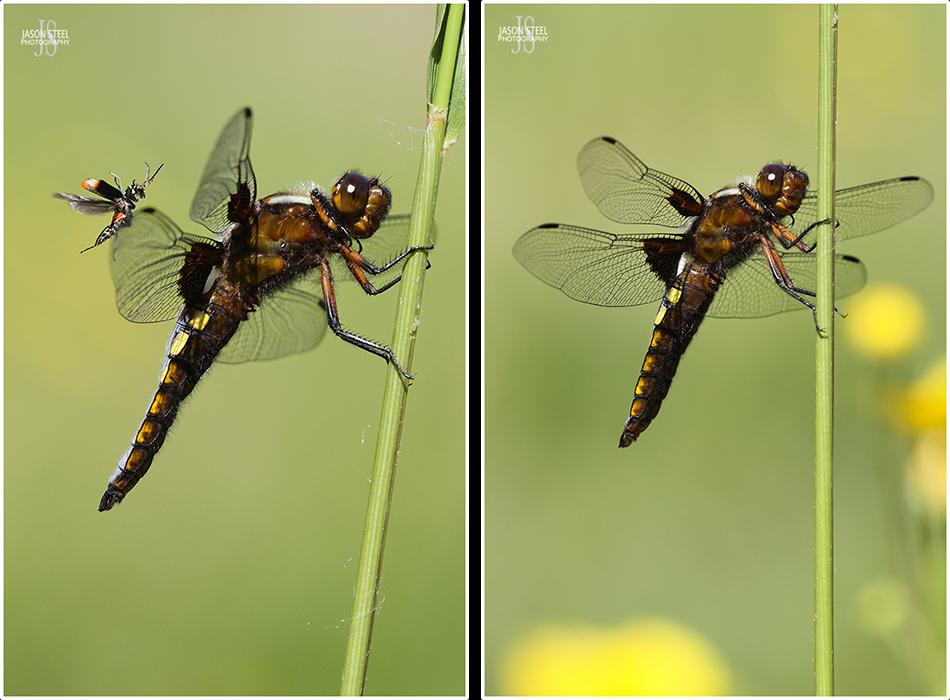
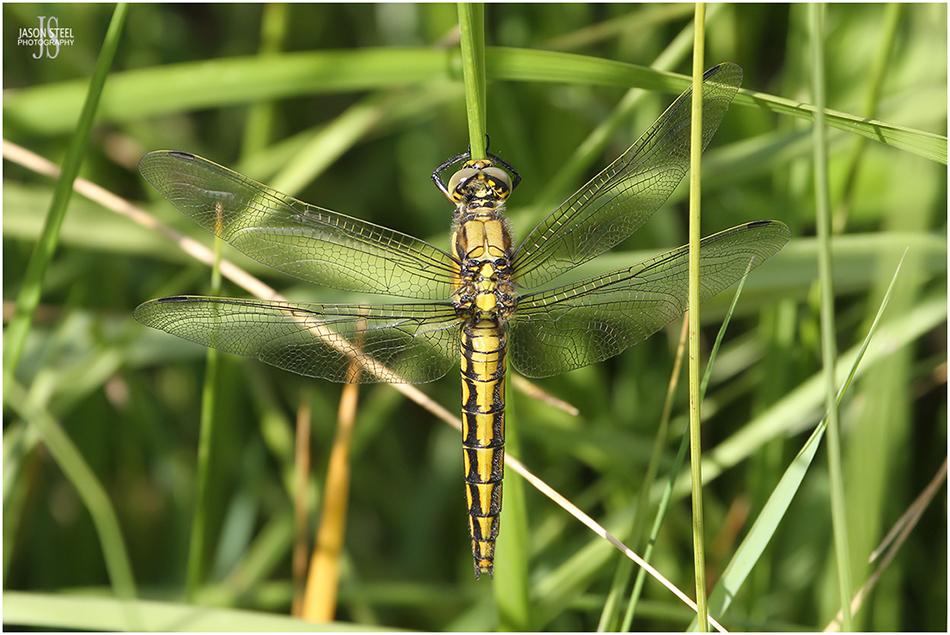
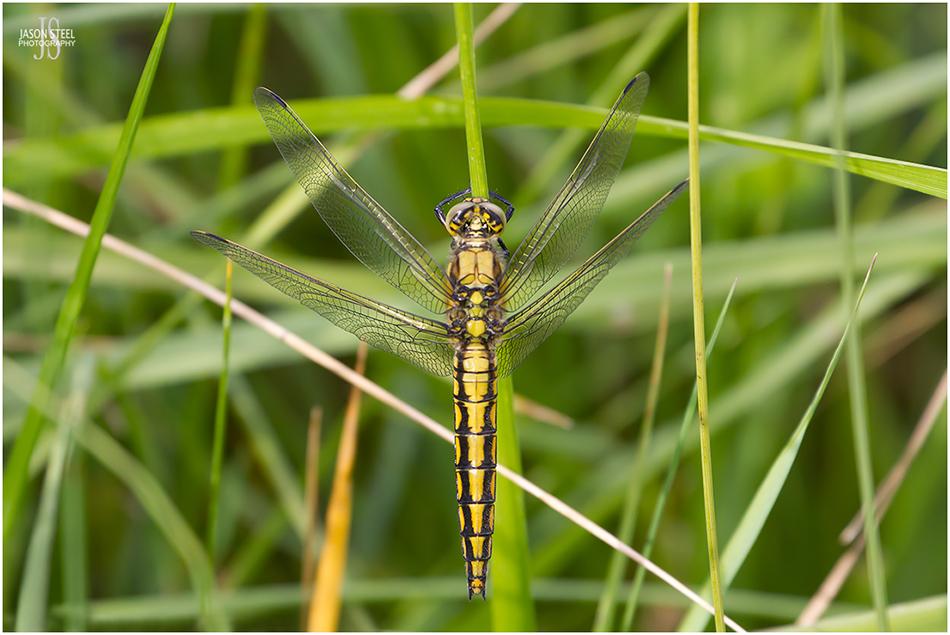
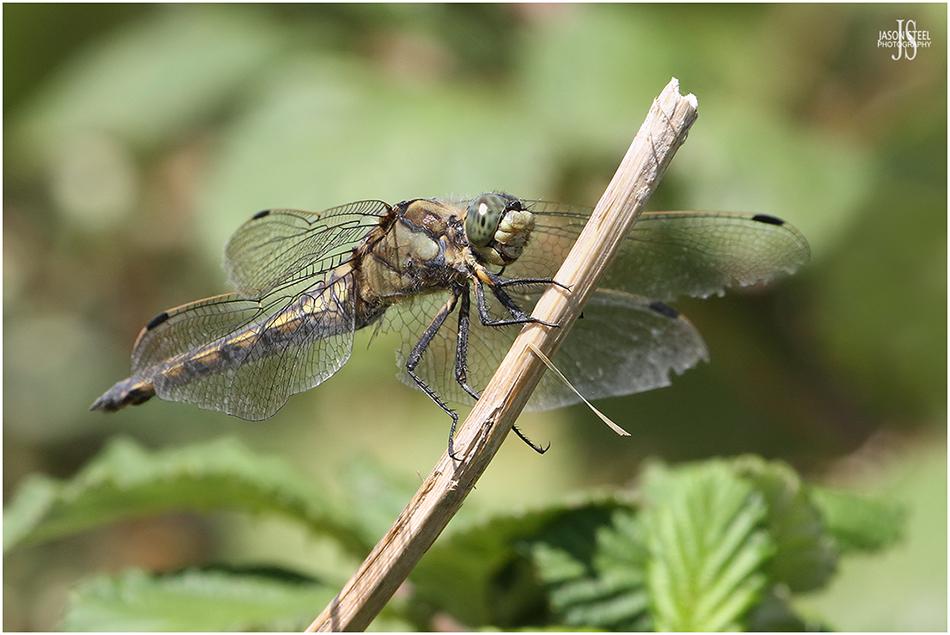
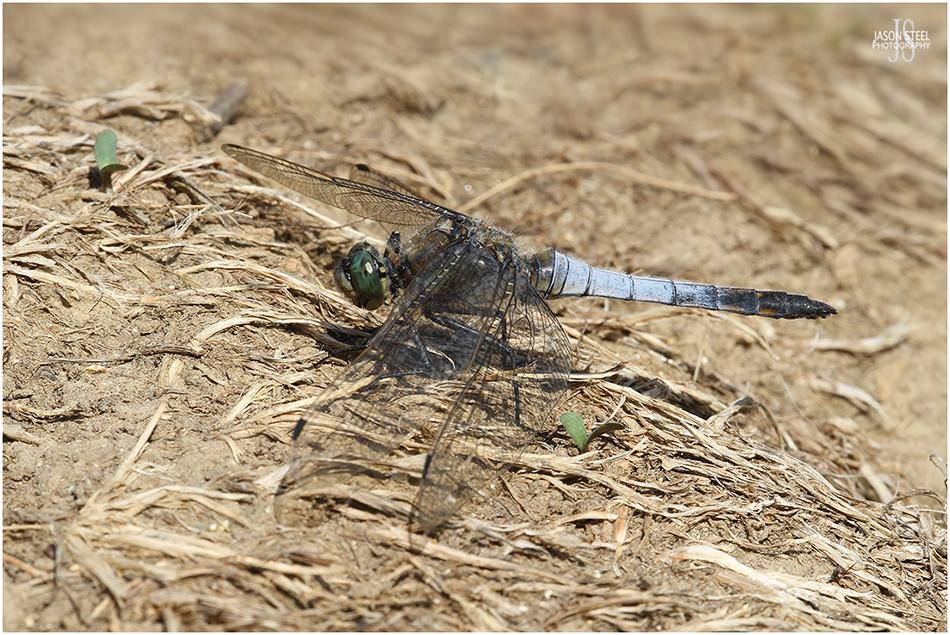
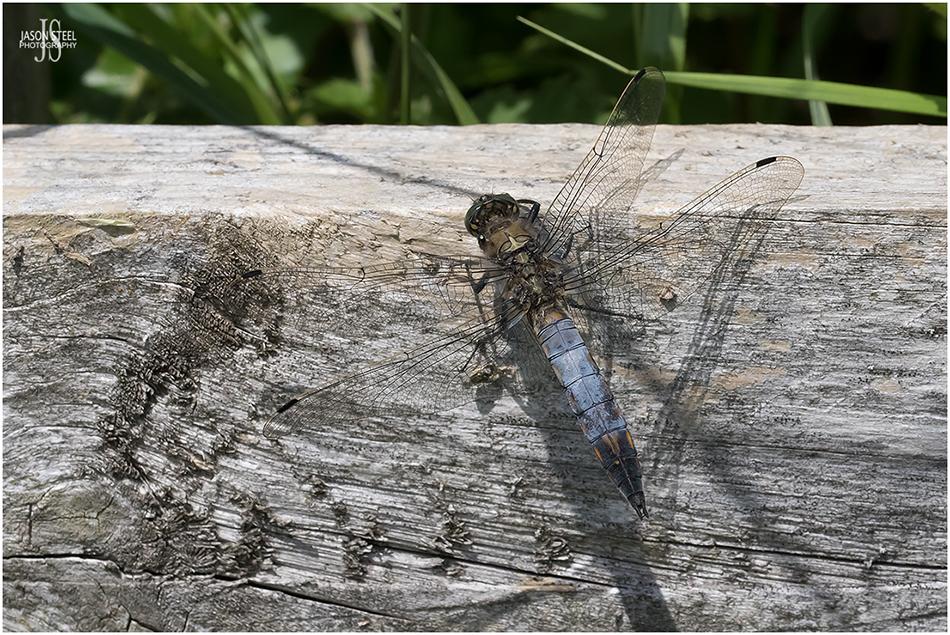
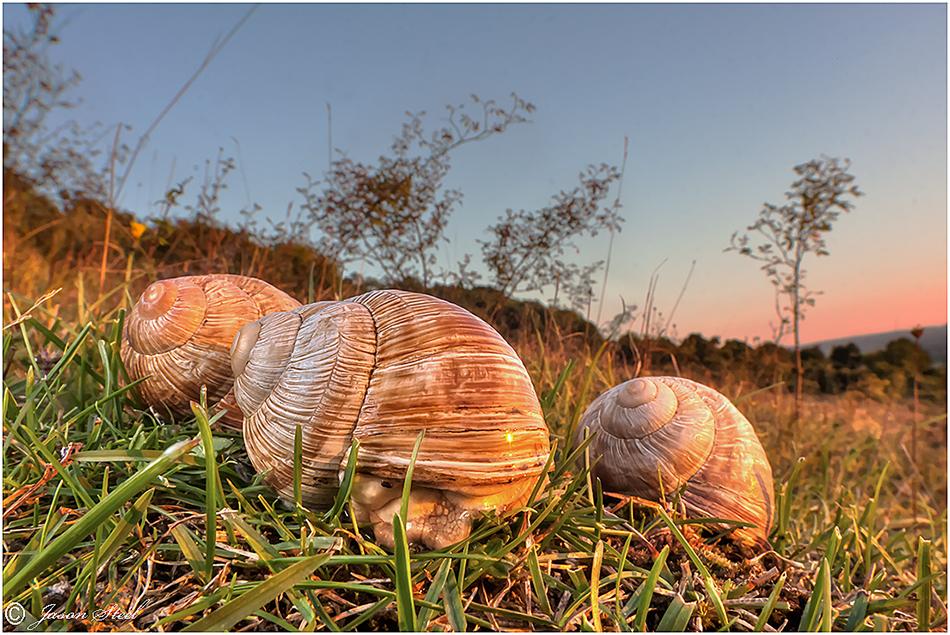
Roman Snails (Helix Pomatia)
Also known as the Burgundy Snail, the Edible Snail or the Escargot. These are Britain's largest land snails reaching shell sizes up to 45-50mm in diameter. They are found on lime rich soil and in chalk downland areas. The Roman Snail is indigenous to Central and Southeast Europe, but due to human intervention can now be found across Europe, Asia and the Americas. It is thought to have been introduced to the UK as a source of food when the Romans settled in this country. This species has suffered serious decline due to foragers & poachers as well as habitat loss. The numbers were reduced so significantly, not just in the UK but across much of Europe, that these snails could once only be found in three main areas in the UK: The North Downs, Chilterns & Mendips of England. Because of this Roman Snails have been afforded some degree of legal protection across much of Europe and full legal protection by UK law since 2008: Natural England - Roman Snails pdf
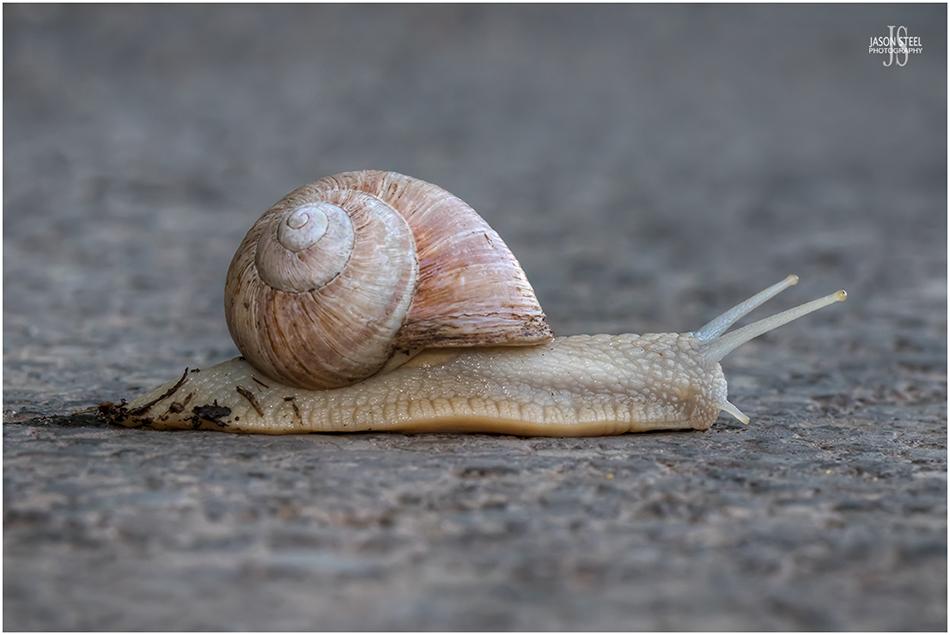
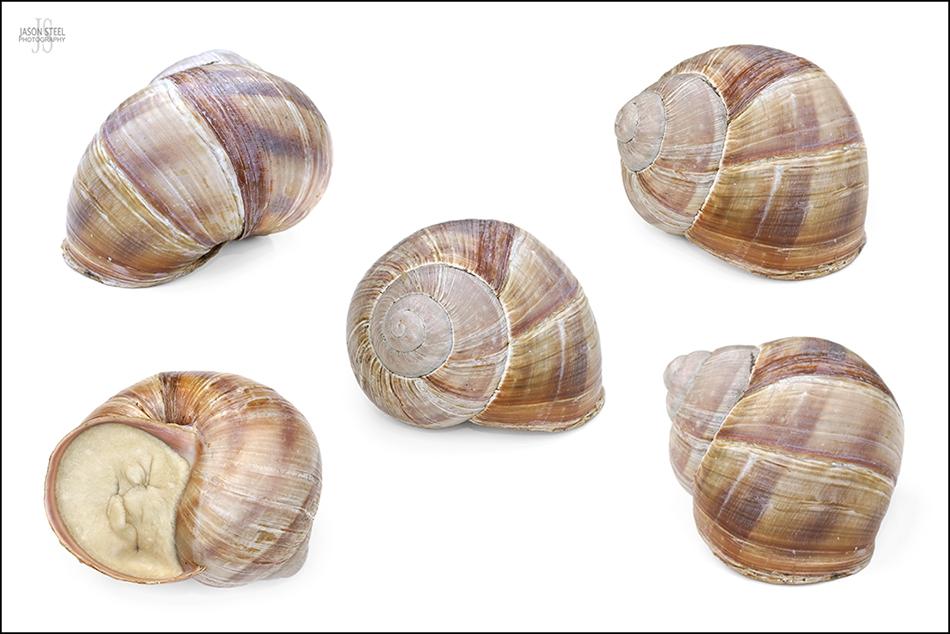
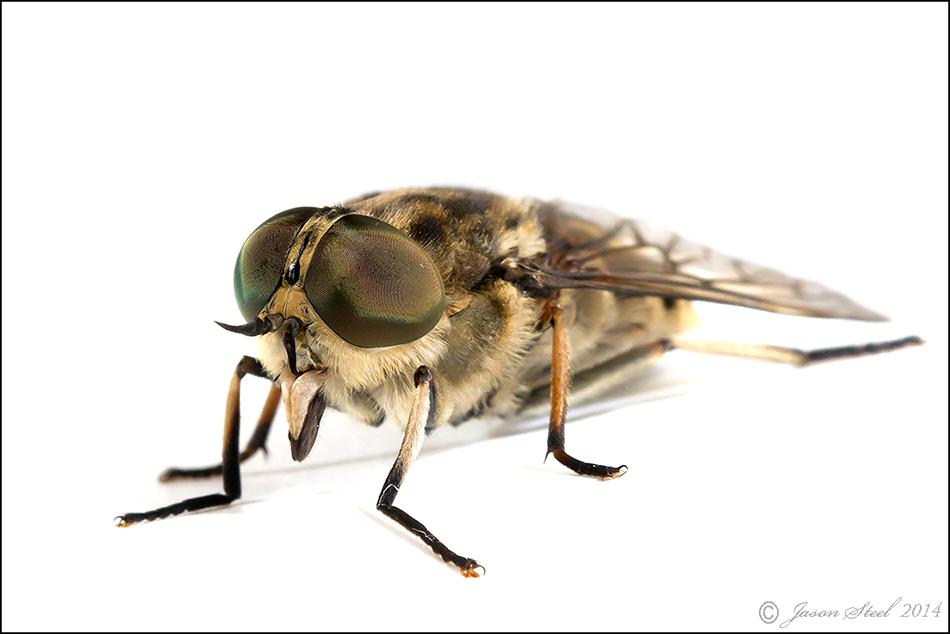
There are around 30 different species of Horsefly in the UK, and they vary in size from around 10mm to 25+mm in length. Whilst the male Horsefly usually feeds on a diet of nectar and pollen, the female also requires a good supply of mammalian blood, for the development of her eggs. This blood is usually supplied via an unwilling horse or cattle donor, but some species have developed a taste for human blood.
Some species will also feed on reptiles, amphibians, birds and even carrion. Horseflies do not possess the fine needle-like piercing mouthparts of mosquitoes that often allows them to feed undetected. Instead their large beaks tear a hole in the flesh of their host resulting in an instantly painful bite. After opening up a wound in their victim the female horsefly then drinks from the pool of blood it creates.
Whilst most bites, although very painful, will have no long term effects on the host, some bites result in considerable swelling to the area of both humans and horses. Bacterial infections and diseases are also spread as a result of bites from Horseflies. Some victims have even had such a severe anaphylactic reaction that they were hospitalised following the bite. On very rare occasions some humans have even died as a result.
Male and female Horseflies can be distinguished by their eyes. The eyes of male specimens are situated very close to each other, whilst there is an obvious gap between the eyes of the female Horsefly, as can be seen with the specimen pictured above.
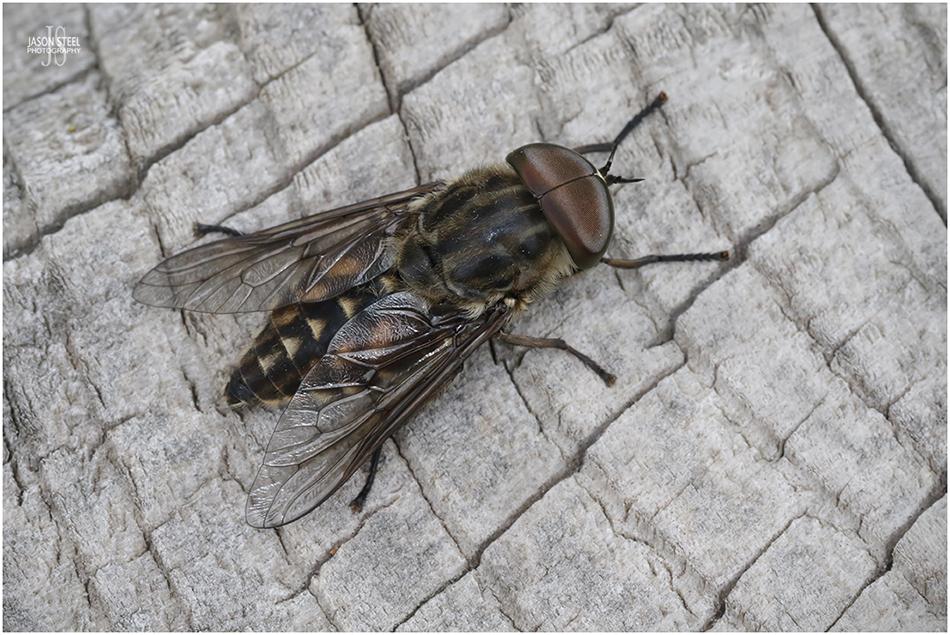
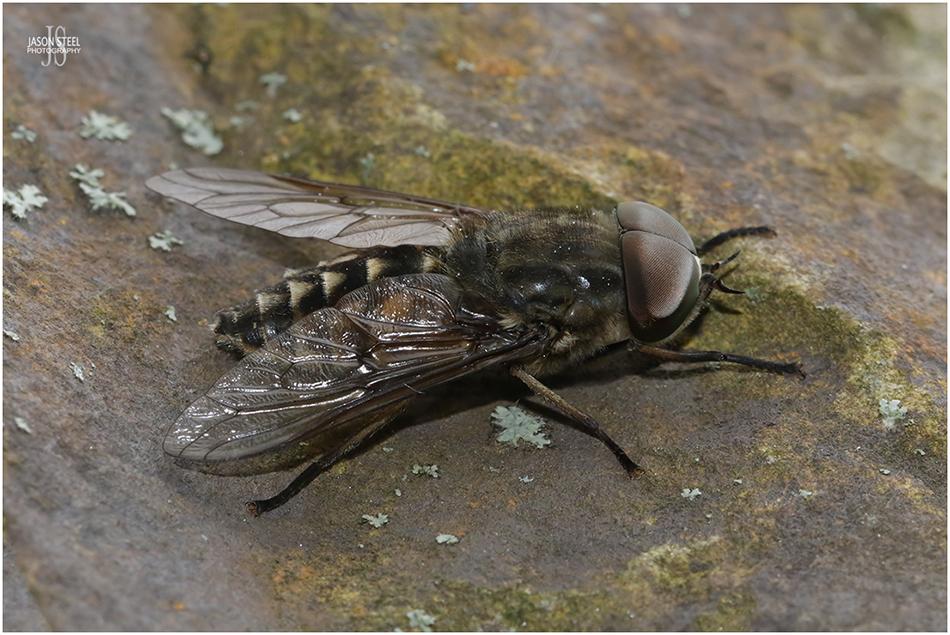
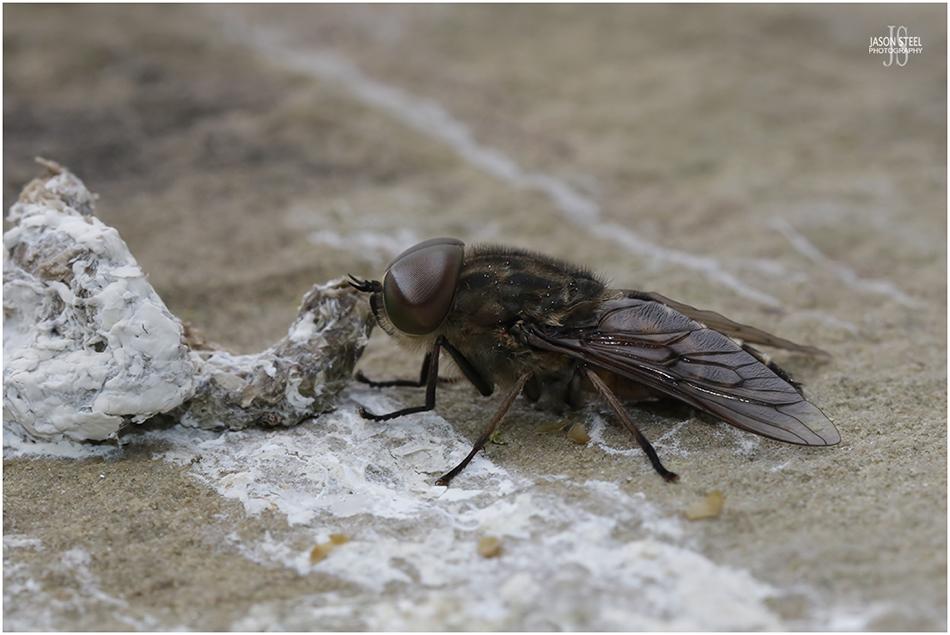
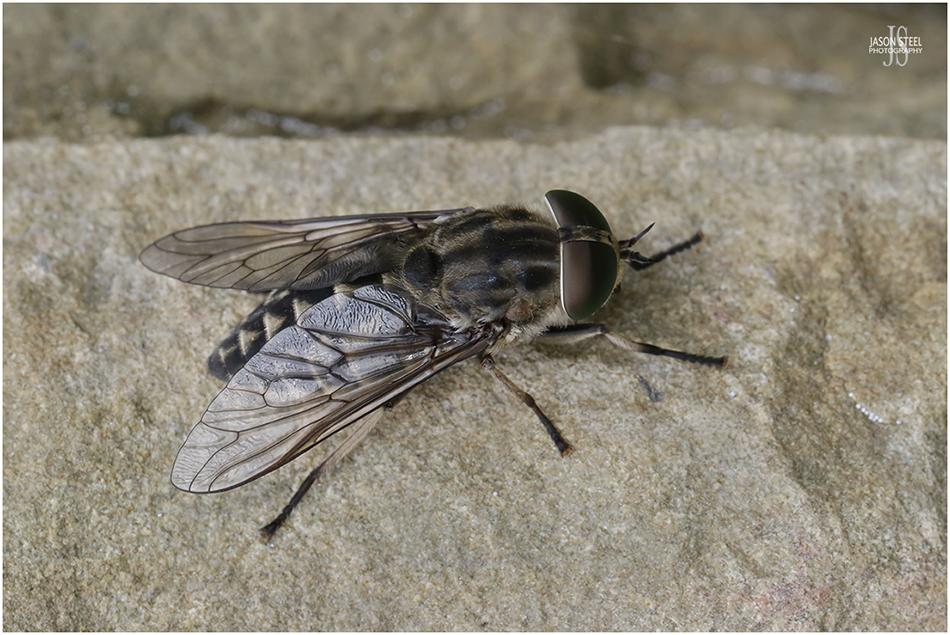
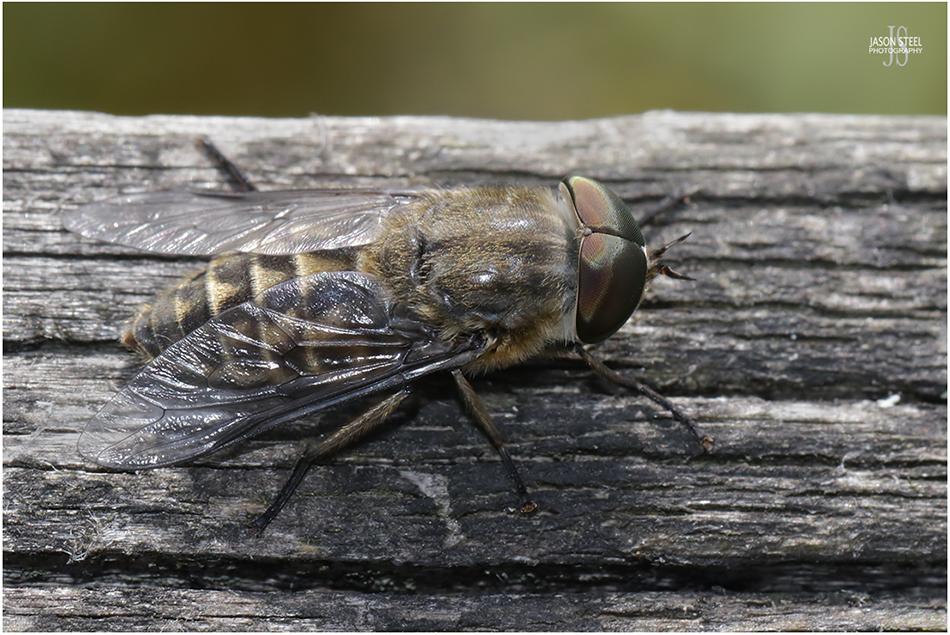
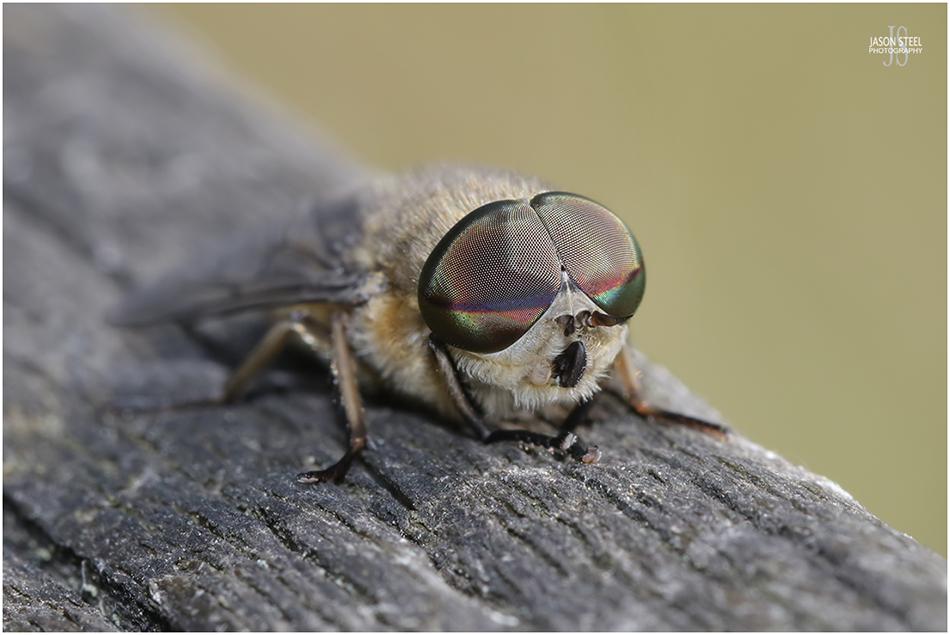
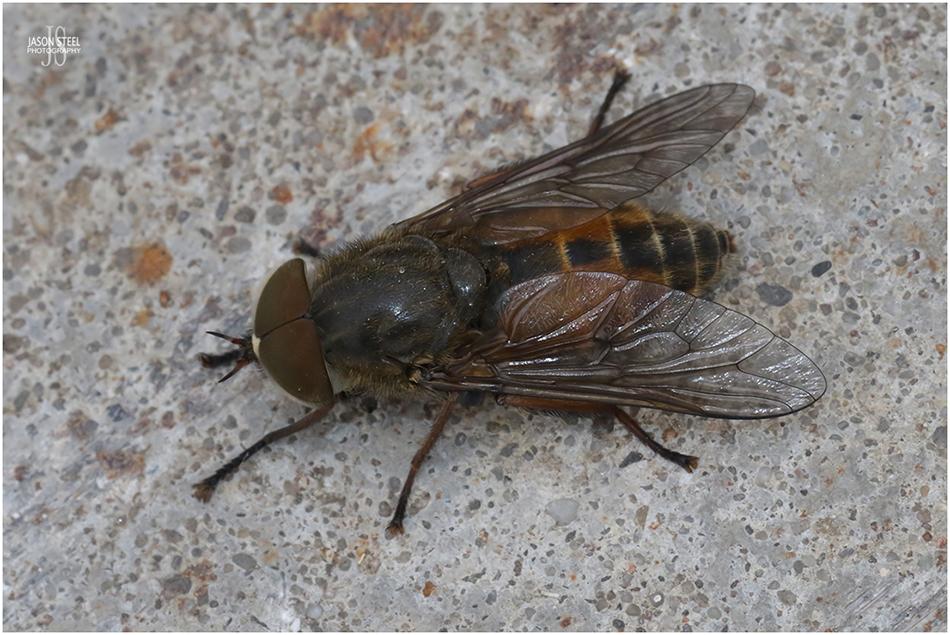
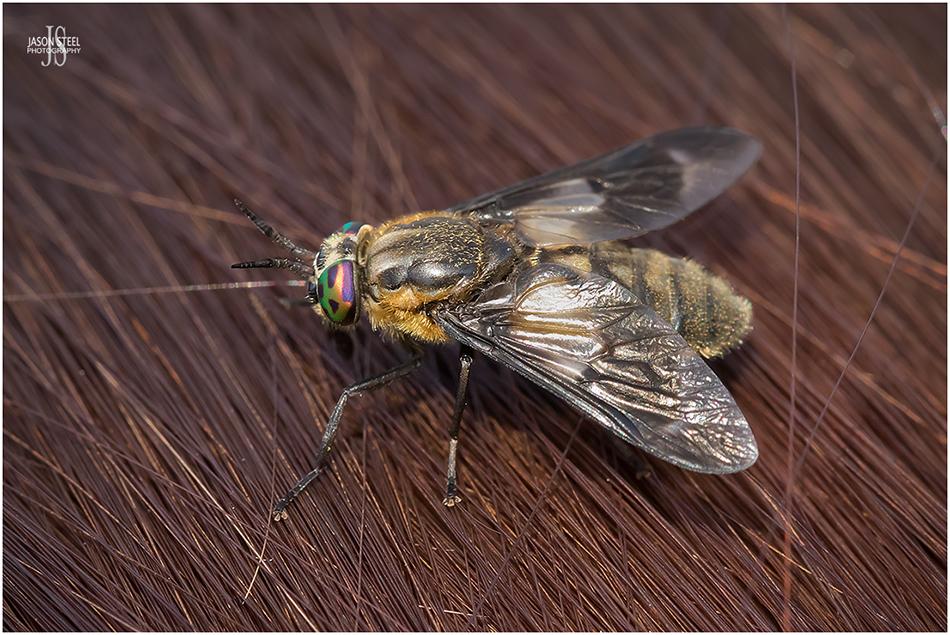
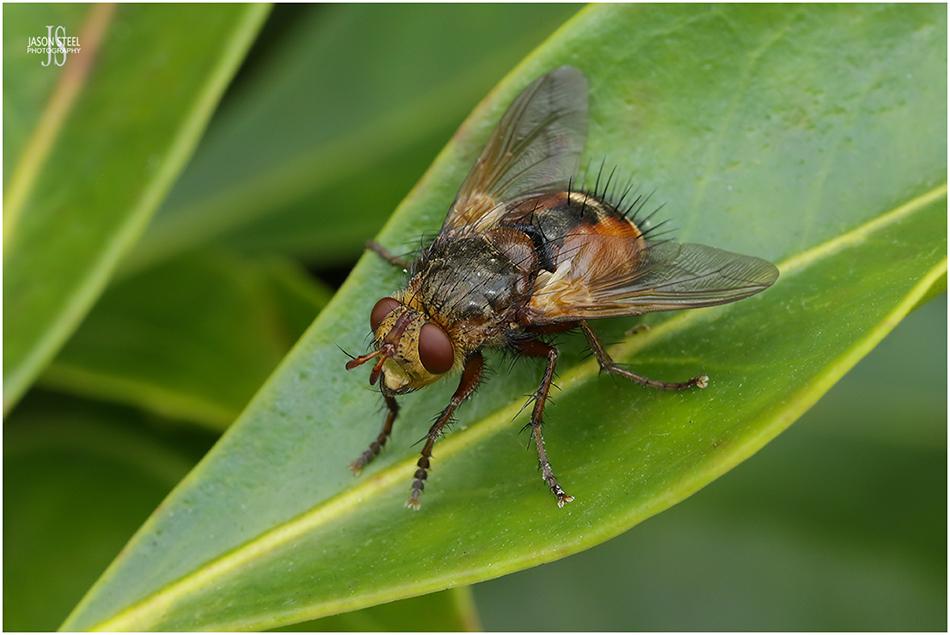
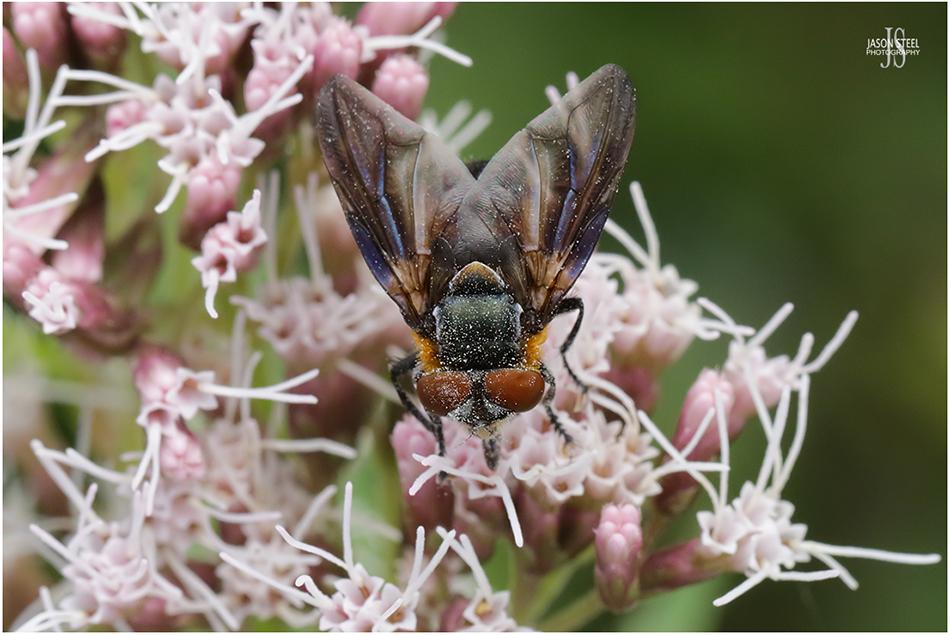
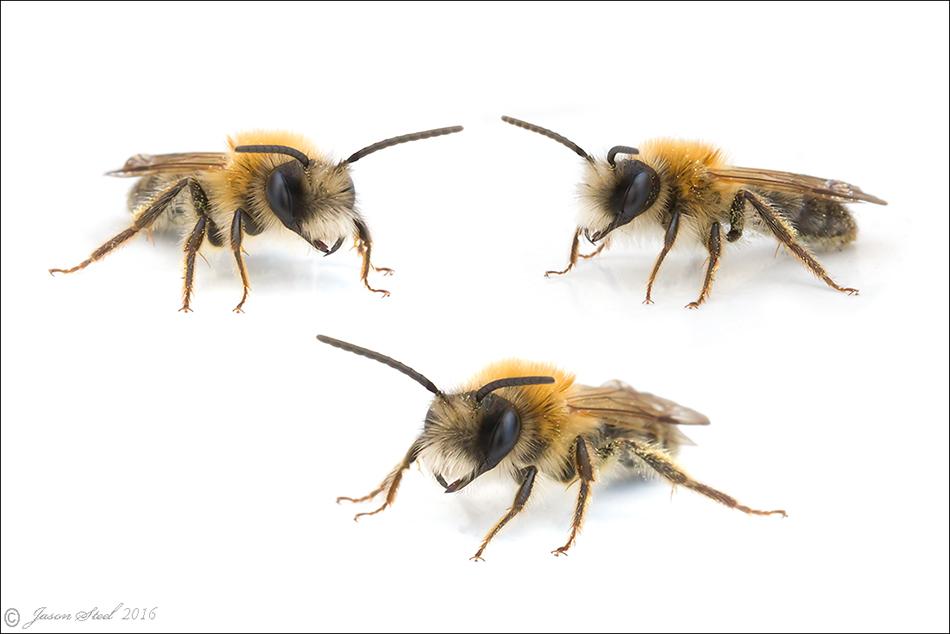
Mining Bees (Andrena species)
Andrena is a large group of over 100 species of European Bees - the Mining Bees. These species of bee range in size from 4mm - 16mm in length. Mining Bees are solitary bees that live in burrows under the ground, usually in sandy soils. The species pictured above is the Andrena nitida. They are between 8-11mm in length and are usually seen in April or May but some sightings do occur in June. They are particulally fond of Buttercups!
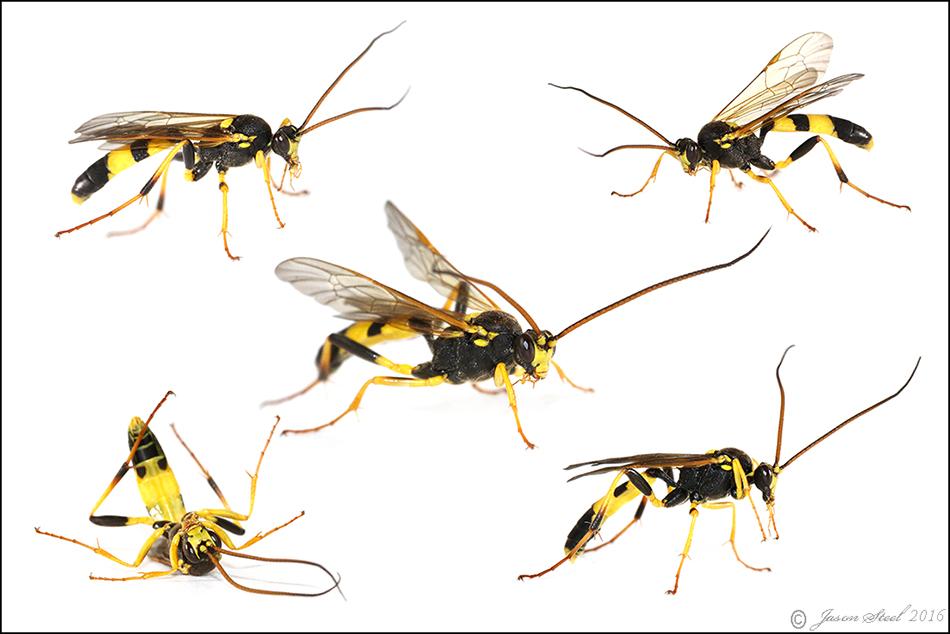
Ichneumon Wasp (Amblyteles armatorius)
Ichneumon Wasps
There are around 2500 species of Ichneumon Wasp in the UK alone. Whilst a few species are quite distinctive and easy to identify, most species are so similar in appearance that they can only be identified down to genus level by an expert under close inspection with a microscope, or even by dissection. They grow to a length of around 15-22mm excluding the antennae. These wasps are regularly seen during the summer, particularly in June, in hedgerows, woodland edges and clearings, gardens and roadside verges, as well as areas of dense vegetation such as brambles. They feed on nectar and pollen as adults. Most Ichneumonids are parasitic wasps which lay their eggs in, or near, their invertebrate hosts, such as caterpillars and insect larvae. Once the larvae hatch they will feed upon their host from the inside until it eventually dies.
Useful link for identifying Ichneumon Wasps
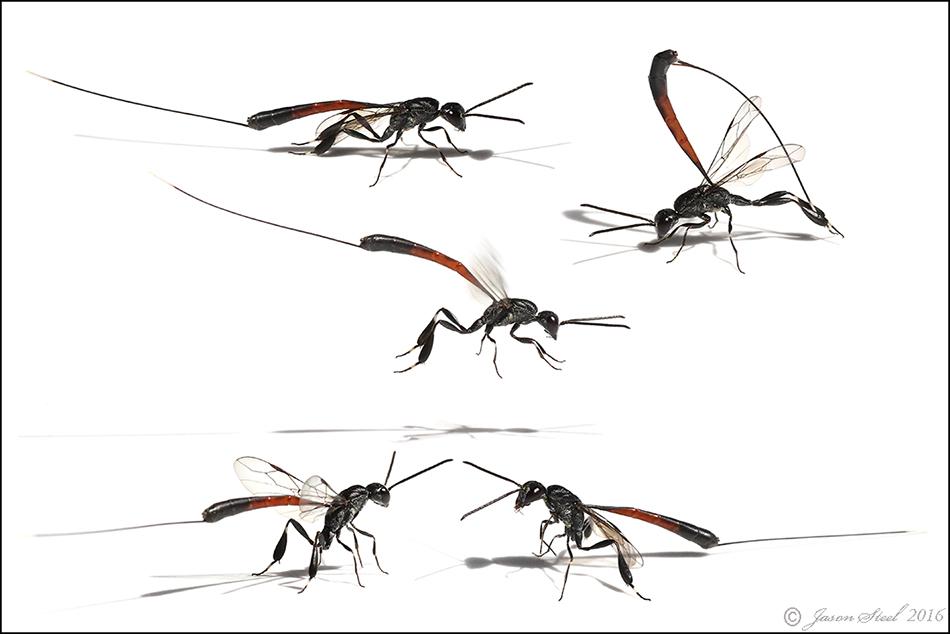
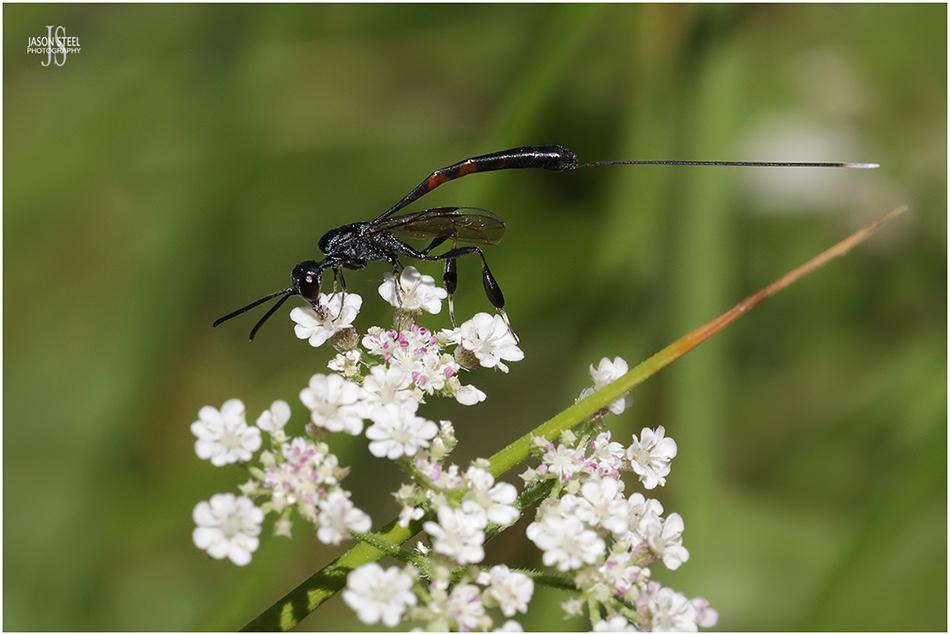
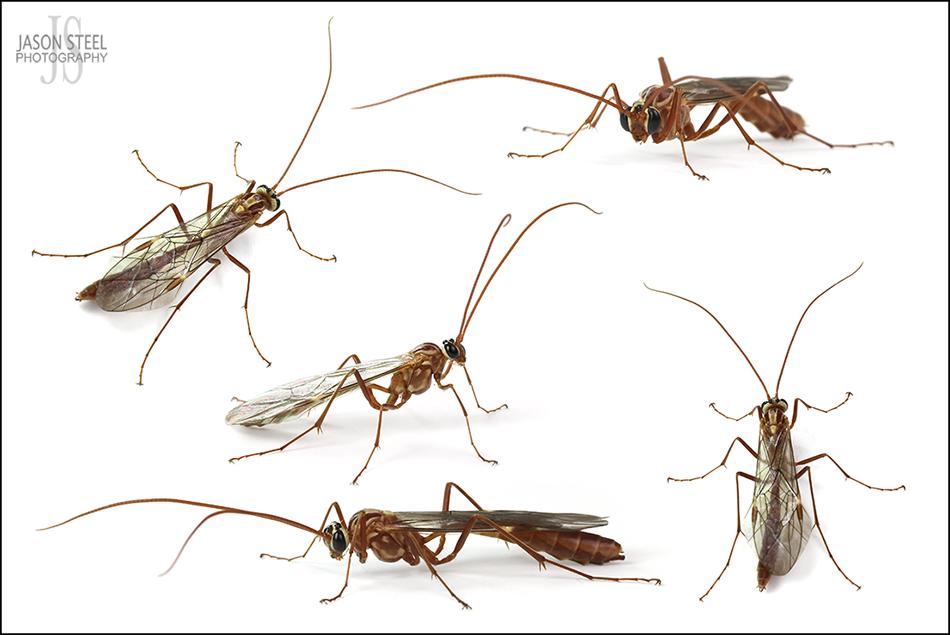
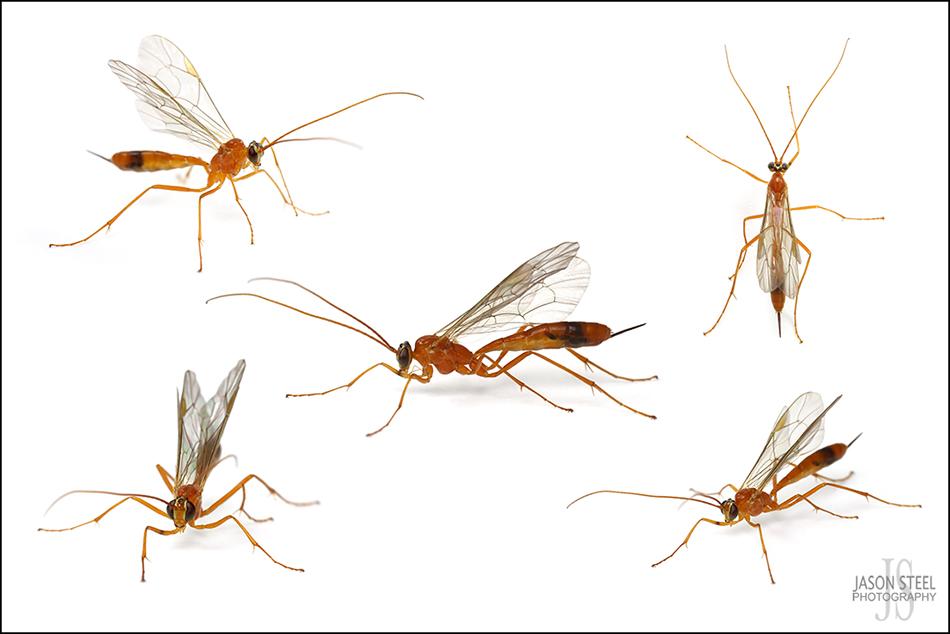
Yellow Ophion Ichneumon Wasp (Ophion luteus)
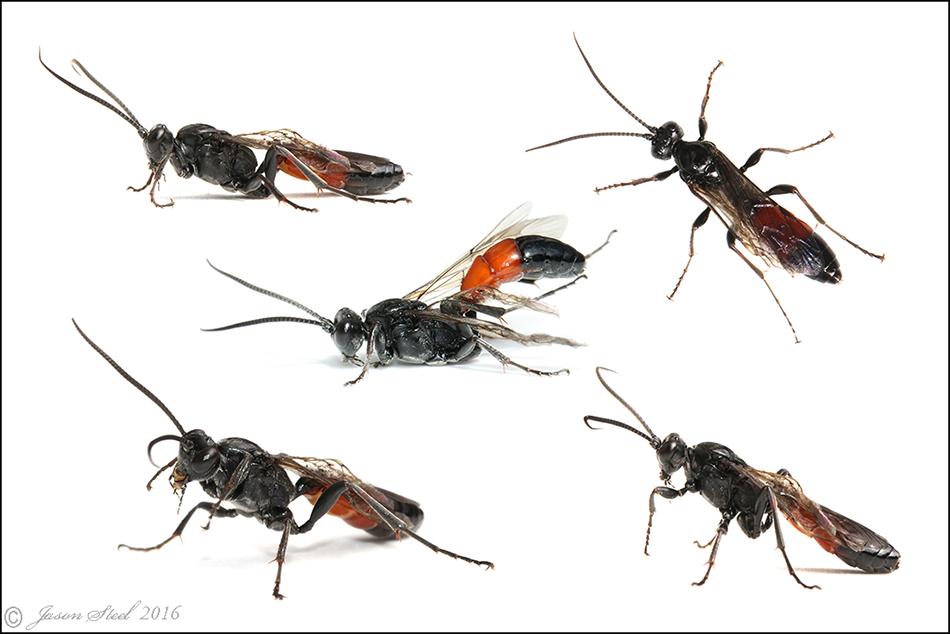
Another Ichneumon Wasp. Some species of Ichneumon Wasp are sexually dimorphic, meaning that both sexes are quite different in appearance. With some species the males can be yellow and black whilst the females can be orange / red and black.
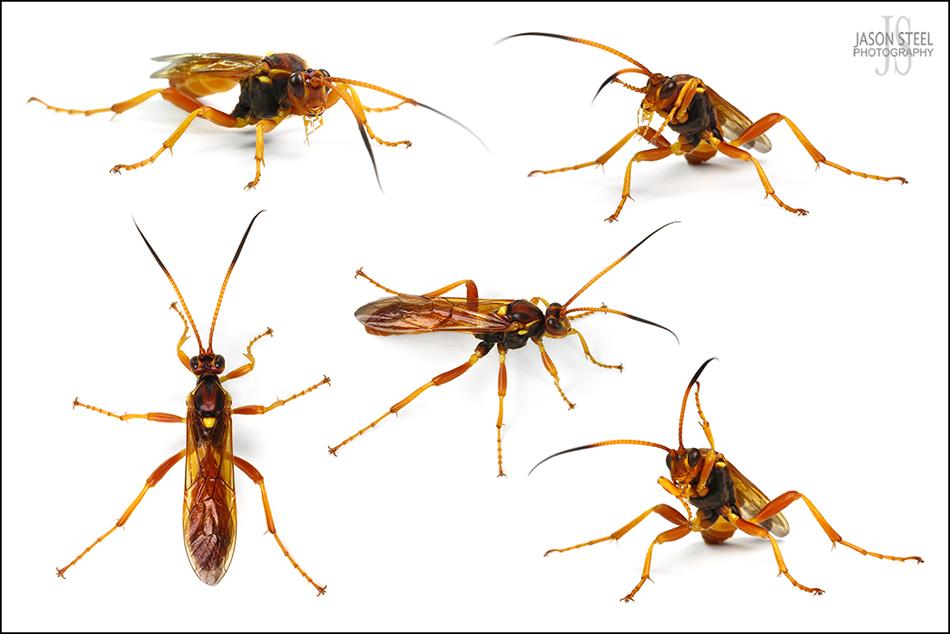
female Callojoppa cirrogaster
Ichneumon Wasp (Callojoppa cirrogaster)
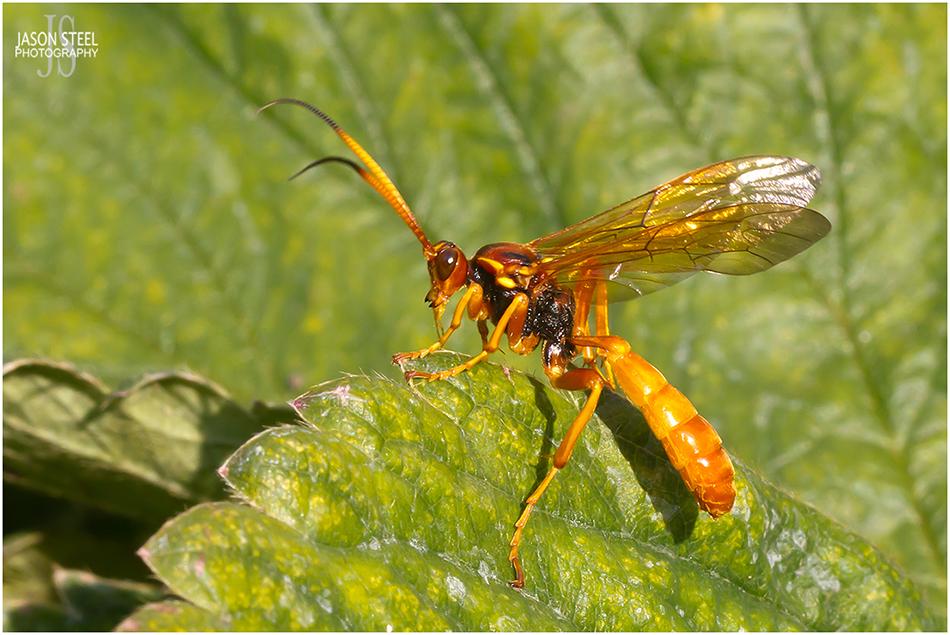
female Callojoppa cirrogaster
This specimen had a body-length of over 25mm not including the antennae. It was a very fast and powerful flier and was seen in my garden in SE London at the end of July 2018.
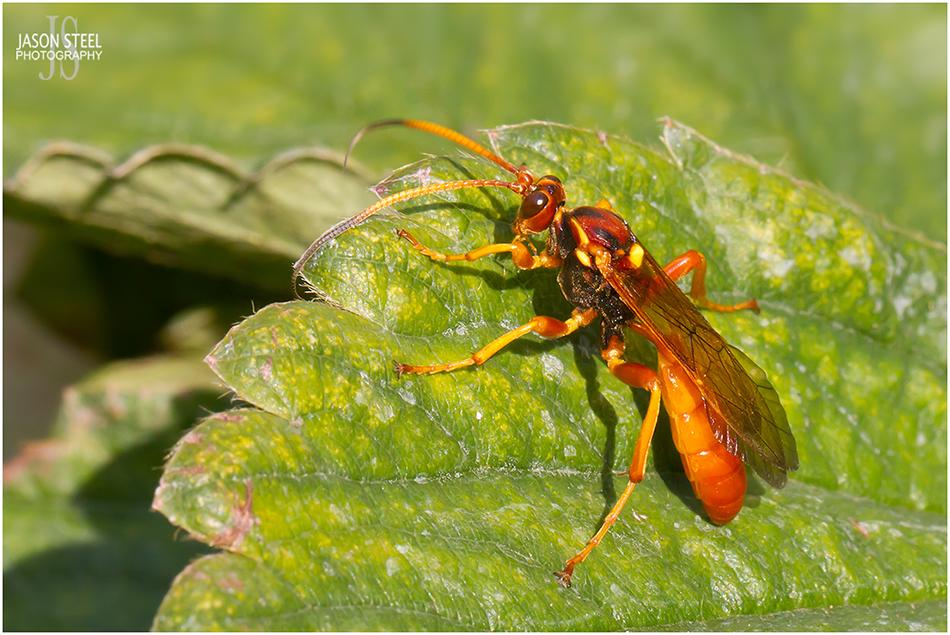
female Callojoppa cirrogaster
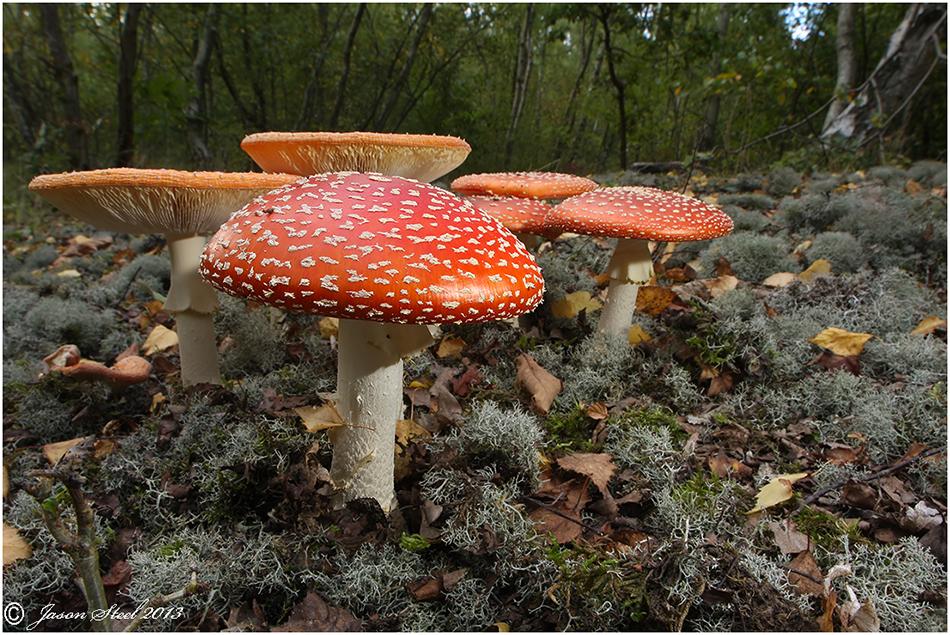
Fly Agaric / Fly Amanita (Amanita muscaria)
A commonly encountered and easily recognisable fungi found across Britain. Although potentially poisonous these mushrooms are often consumed by man for their hallucinogenic properties. However this could be very dangerous if attempted without prior expert knowledge of how to carefully prepare the mushrooms before consumption.
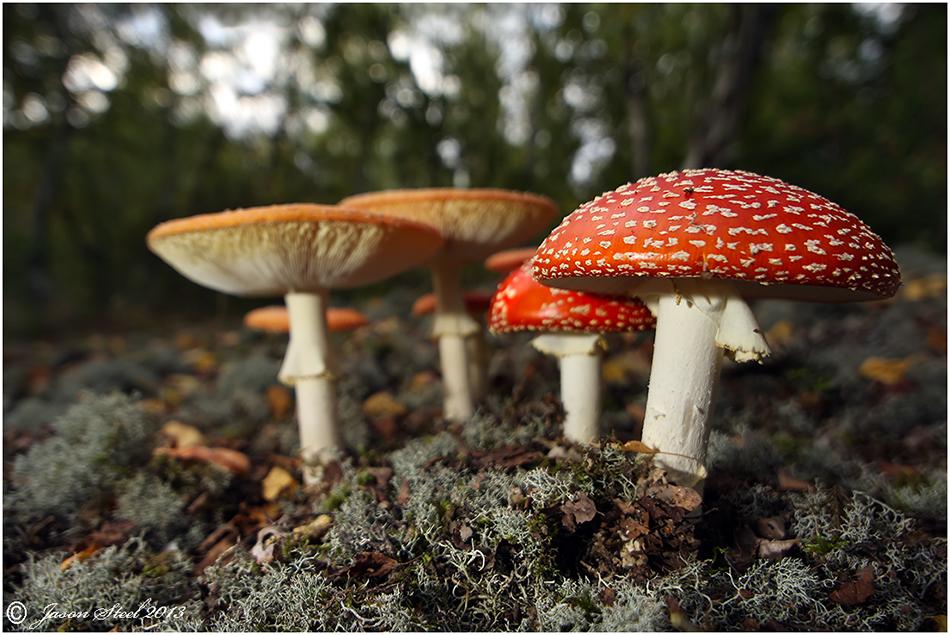
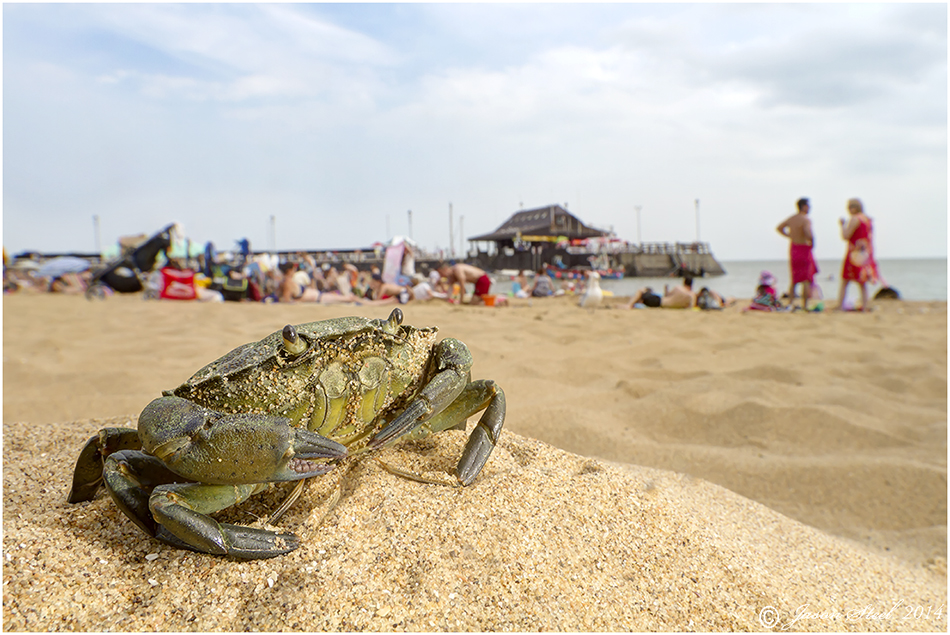
Shore Crab / aka European Green Crab (Carcinus maenas)
The Shore Crab is predominantly a shore or shallow water sea crab but can be found in water as deep as 60 metres. It is the most commonly found crab on the shore of British and Irish coasts. The carapace (shell) usually grows to 60 - 80mm (sometimes larger 90-100mm) across and the crab has well developed and powerful pincers. Colours can vary enormously and include magenta, brown, orange, white, and green. In the UK 95% of adult Shore Crabs are orange/brown with just 5% being found in bright green like the specimen photographed above. Colour can be influenced by age, habitat, breeding season and when the crab last shed its skin.These crabs are one of the world's most invasive species and can pose a threat to new ecosystems where they will feed on almost anything that they can catch. They are also commonly seen fighting amongst themselves and during these fights it is not unusual for pincers to be broken off and lost. Smaller pincers often grow back to replace missing ones.
LINK 1 LINK 2 LINK 3 LINK 4 LINK 5
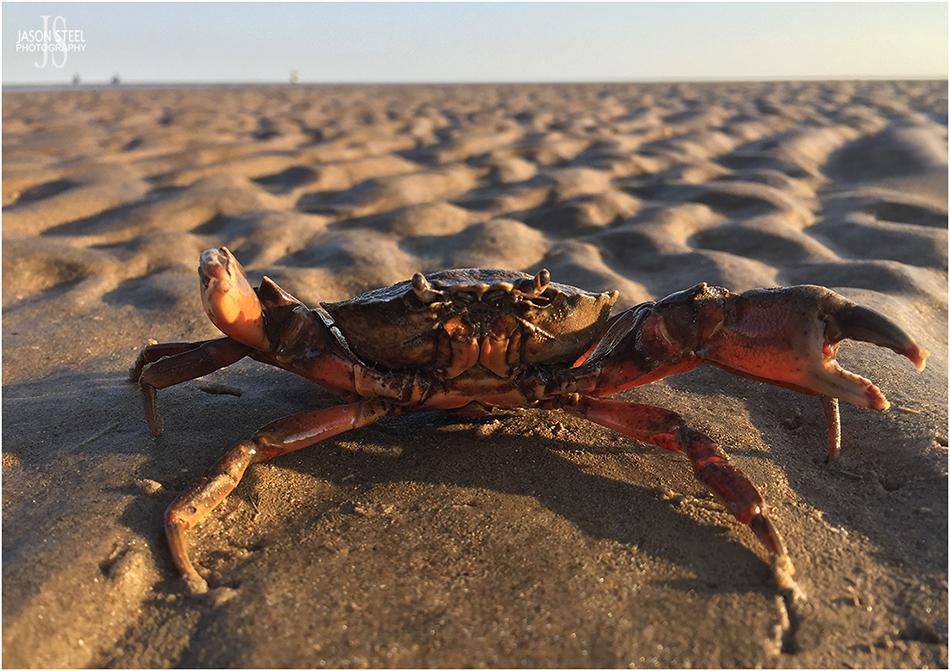
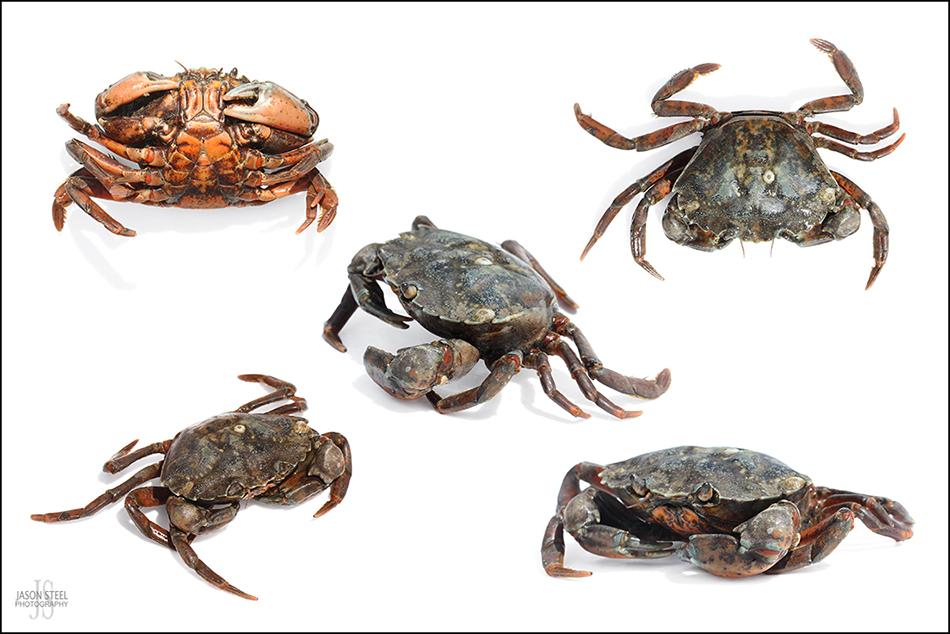
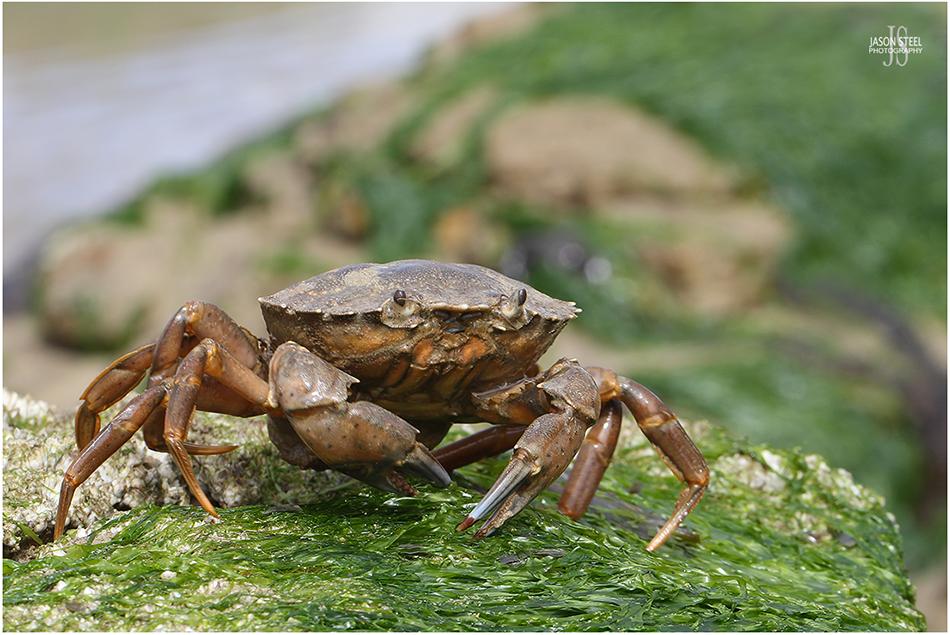
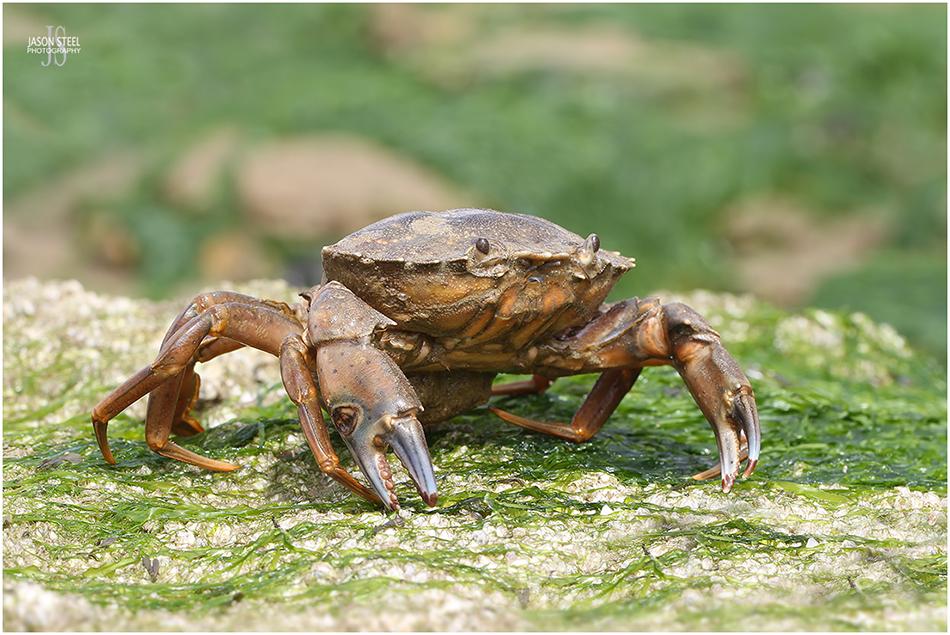
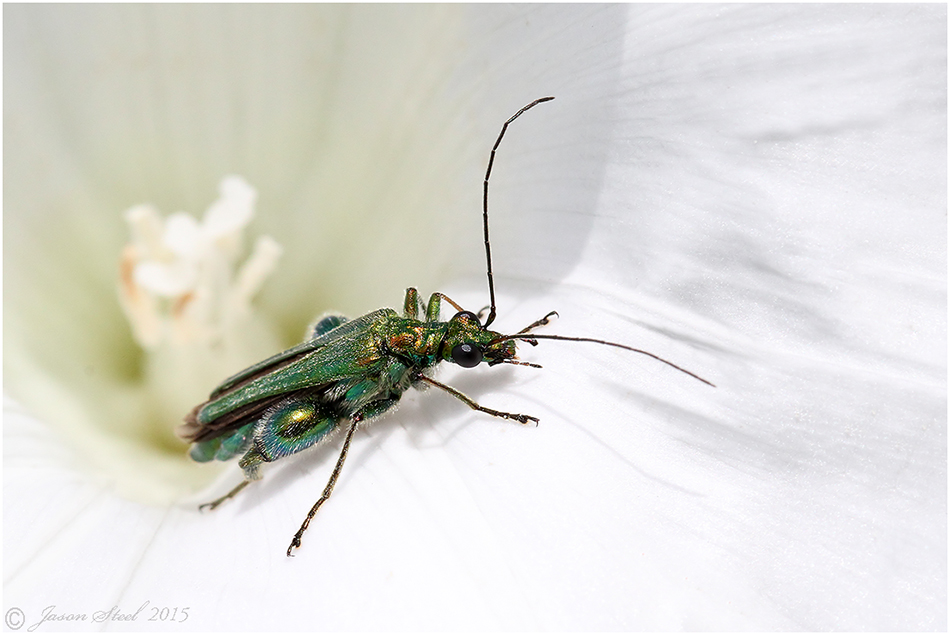
Swollen-Thighed Flower Beetle / Thick-Thighed Flower Beetle (Oedemera nobilis)
The Swollen-Thighed Beetle gets its name from the larges bulges on the thighs of the male beetles. The females do no have these bulges. They are also known as Fat-Legged Beetles, False Oil Beetles or Flower Beetles. Feeding on pollen this 10mm beetle can be found in flower meadows and gardens across southern England and Wales and much of Europe. One distinguishing feature is the noticeable gap between the wing cases on the back of the beetle. Swollen-Thighed Beetles are often seen as in this case on the Bindweed flower where their bright green colour makes them very obvious against the bright white trumpet flower. The green body often has parts on the back with a coppery sheen under certain light. These beetles do not harm plants so they are considered as a gardener's friend.
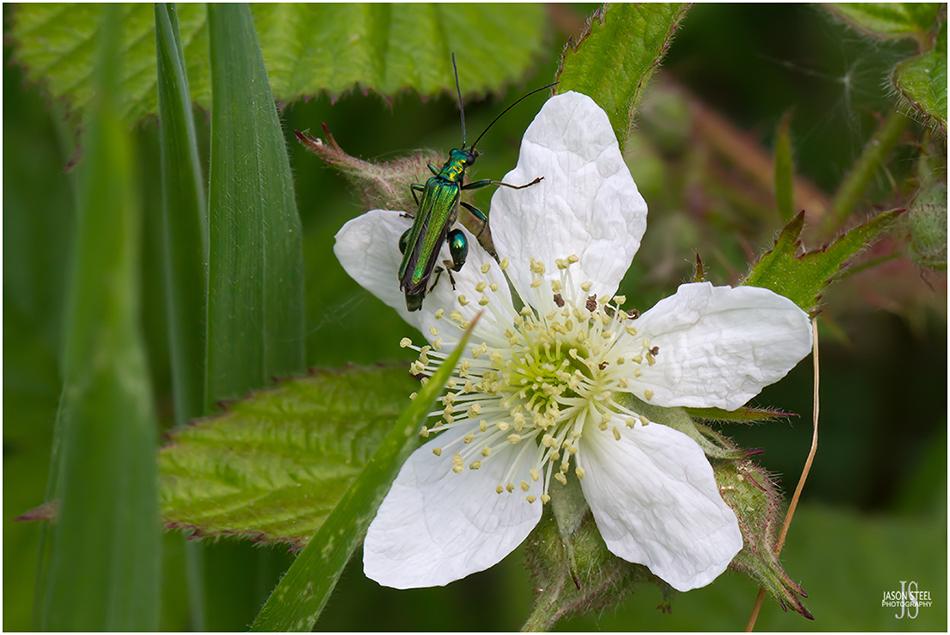
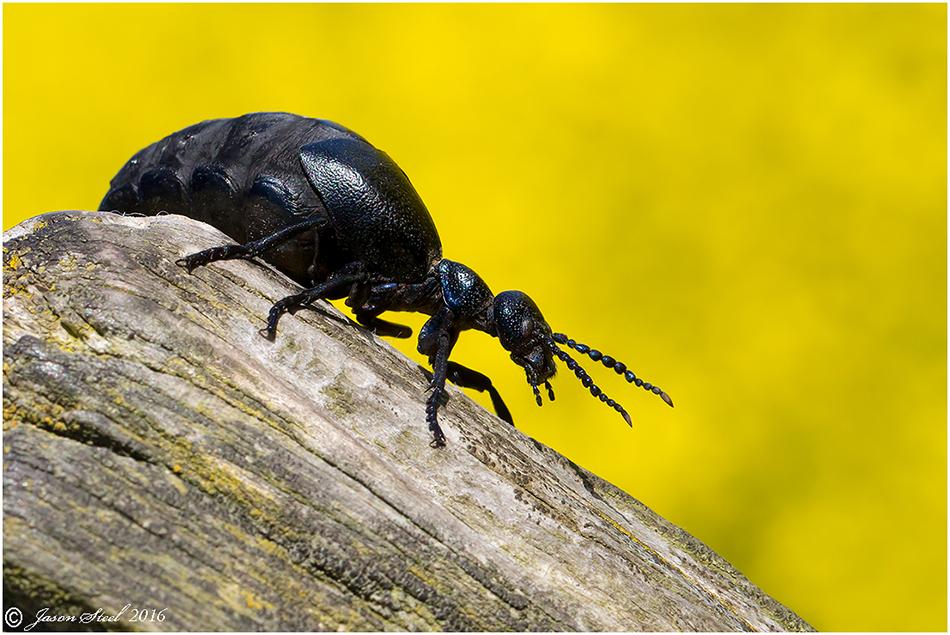
Female Black Oil Beetle, at the edge of a field of Rapeseed at Minnis Bay, Kent, 1st May 2016
Black Oil Beetle (Meloe proscarabaeus)
There are 11 species of Oil Beetle found within the UK, 8 of which are from the genus Meloe. All are now BAP Priority Species and in serious decline. Until recently several species were believed to be extinct but some of these species have since been re-discovered. They are still absent from many counties and in Kent Oil Beetles are now considered extremely rare with few recent sightings. This Black Oil Beetle is one of two specimens I found on the South coast of Kent in 2016. I have since found them at this site on each subsequent visit.
This is a large and harmless species of Beetle, growing to a total length of 30, and sometimes even close to 40mm when heavily gravid. Telling the different Oil Beetle species apart can be very difficult without good clear photos, and the two most frequently encountered species, the Black Oil Beetle, Meloe proscarabaeus, and the Violet Oil Beetle, Meloe violaceus, are particularly similar. Both species are black in colour but some may appear as metallic violet or turquoise. The two species can be distinguished by a close inspection of the base of the thorax. The base of the thorax on the Black Oil Beetle has a straight edge. However the lower edge of the base of the thorax on the Violet oil Beetle has an indent. Beneath this indent is a tiny sharp tooth that's very difficult to spot without very close-up photos. Both species have a heavily punctured head and thorax but the punctures on Meloe violaceus are much finer when compared to the courser punctures of Meloe proscarabaeus.
Females Oil Beetles are usually larger and when gravid the female is considerably larger with a very swollen abdomen containing hundreds of eggs. Males also have a very distinct kink in their antennae which the females lack. When the adult beetles first emerge they are very blue in colour and their abdomen is considerably smaller than seen in these photos. In fact the abdomen usually doesn't extend past the wing-cases at this stage. LINK 1 LINK 2
Distinguishing Black Oil Beetles from Violet Oil Beetles Distinguishing Black Oil Beetles from Violet Oil Beetles 2
LINK 1 LINK 2 LINK 3 LINK 4 LINK 5
As well as the 8 species of Oil Beetle, from the genus Meloe, there are also three other species of Oil Beetle in the UK. Sitaris muralis, Which is a very distinctive black and orange Oil Beetle, that parasites the nests of Anthophora bees. This Oil Beetle is so rare in the UK it is currently only known at one site in Hampshire. The 10th Oil Beetle is Lytta vesicatoria, which is bright metallic green in colour, and is sometimes referred to as the Spanish Fly. This Oil Beetle is also extremely rare in the UK and is only found on the Isle of Wight.
And number 11, our final Oil Beetle, is Stenoria analis, the Ivy Bee Blister Beetle, which is orange and black in colour, and within the UK has currently only been recorded in the Channel Islands. This species is native to Western Europe and North Africa. Stenoria analis is a cleptoparasite of the Ivy Bee, Colletes hederae, but it is believed that this Oil Beetle must also use other hosts as the beetle is found sometimes outside the range of the Ivy Bee.
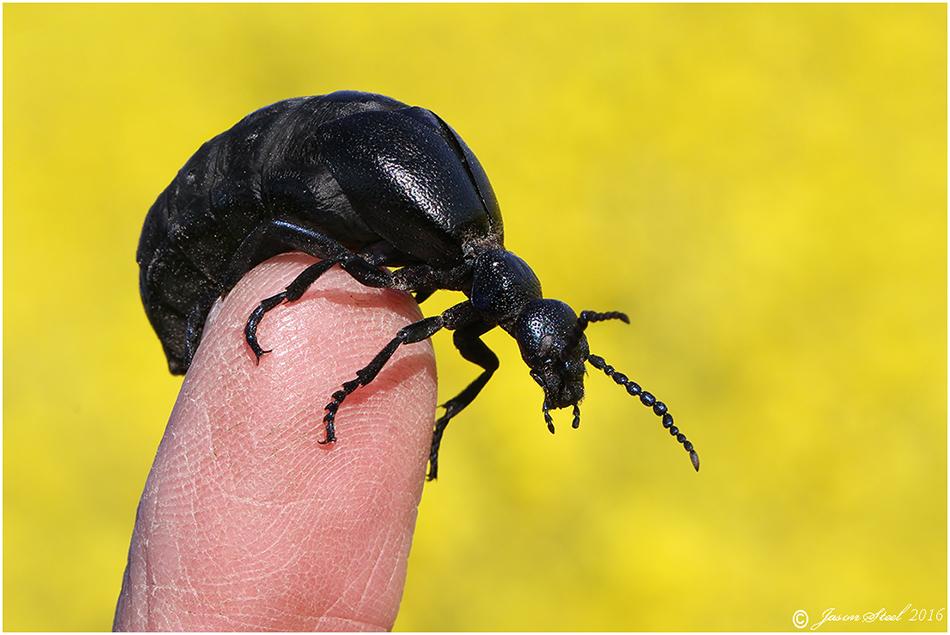
Oil Beetles get their name from their ability to produce a very bitter tasting fluid from their knee joints when disturbed. This deters many would-be predators. After mating the female Oil Beetle lays her eggs in a small burrow in the soil. This can be around 1000 eggs. Upon hatching, the larvae, known as triungulins, quickly climb up vegetation and make their way to the top of flowers. Here they wait for visiting Solitary Bees gathering nectar. The triungulins are dependant on finding a suitable bee quickly and when one lands on their flower they use their hooked feet to grab hold of the bee. The bee then unwillingly carries the tiny beetle larvae back to its nest. Once inside the bee's nest the triungulins then start to feed on the bee's eggs, pollen and nectar supplies. Here they will remain until they pupate and emerge the following year as adult Oil Beetles. With the decline in wildflower-rich habitats and subsequently the decline of Solitary Bees, the Oil Beetles have been seriously effected as they cannot complete their life-cycle.
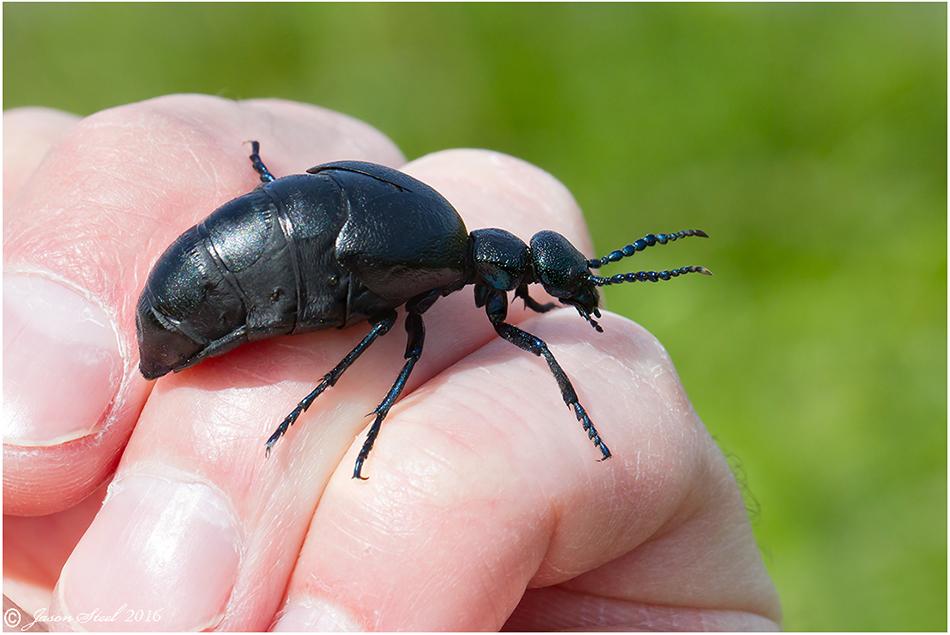
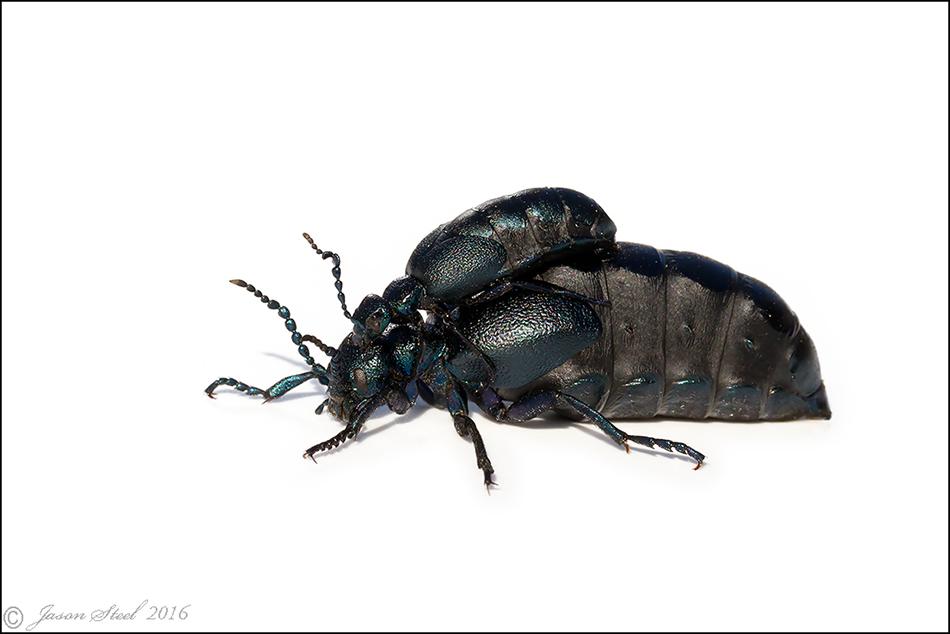
This mating couple clearly shows the huge difference in size between the male and female Black Oil Beetles.
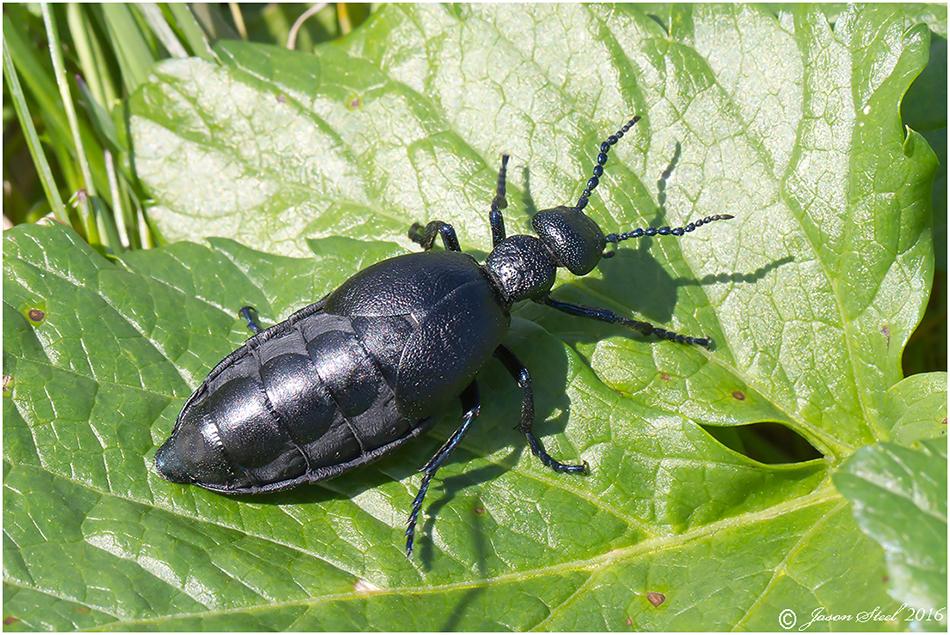
Like most Oil Beetles Black Oil Beetles are diurnal and can usually be seen on sunny days, in spring and early summer, in meadows, coastal grasslands and clearings and verges of woodland. Here they feed on both leaves and flowers of several wild plants including buttercups and dandelions. Meloe rugosus and Meloe mediterraneus are the exception as they are nocturnal and active throughout the winter.
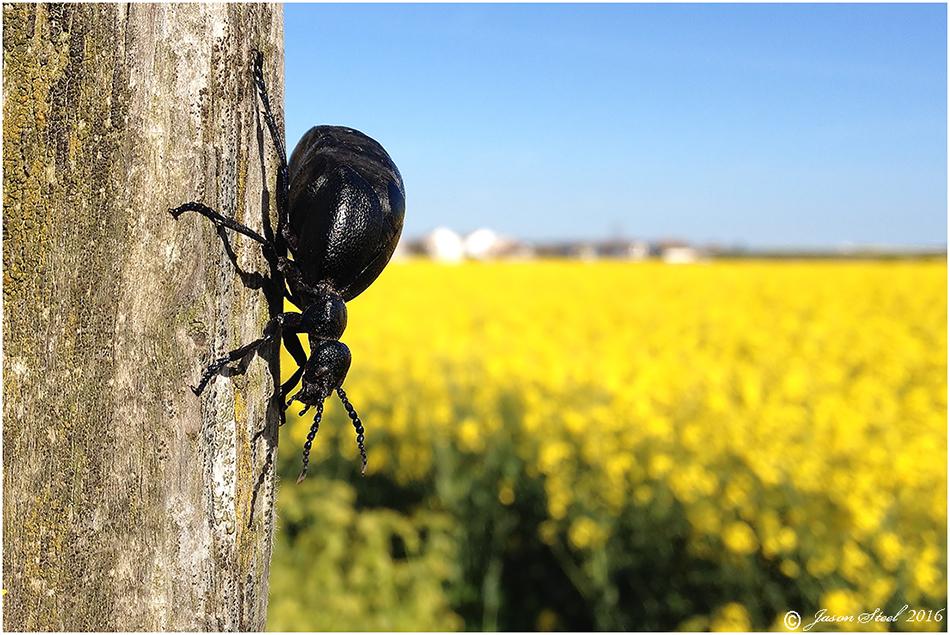
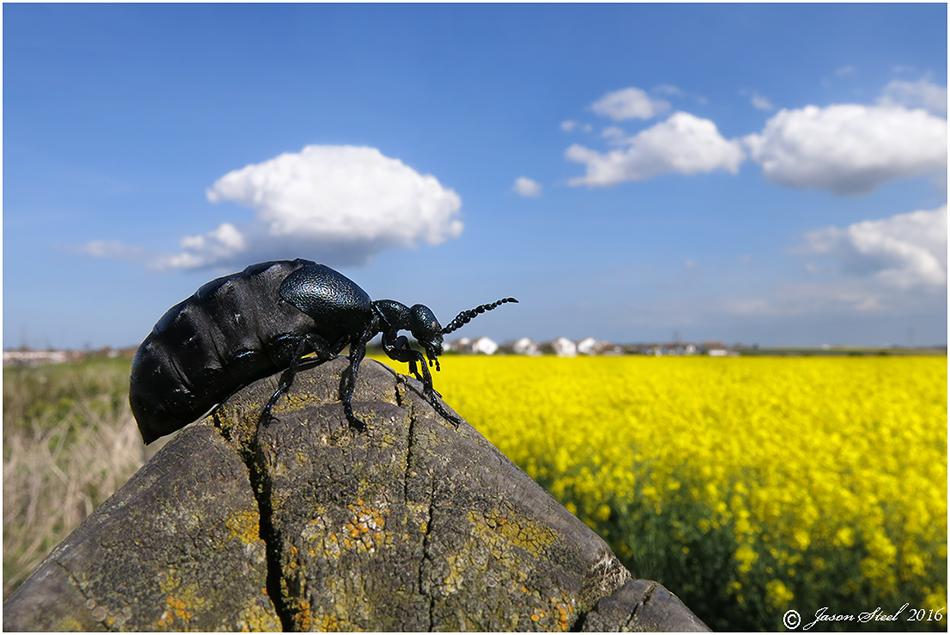
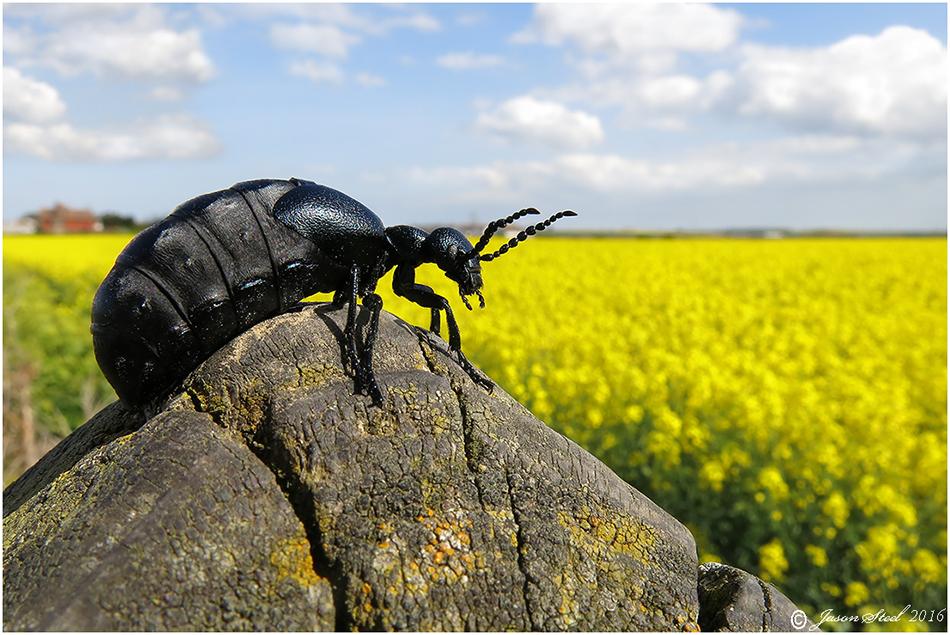
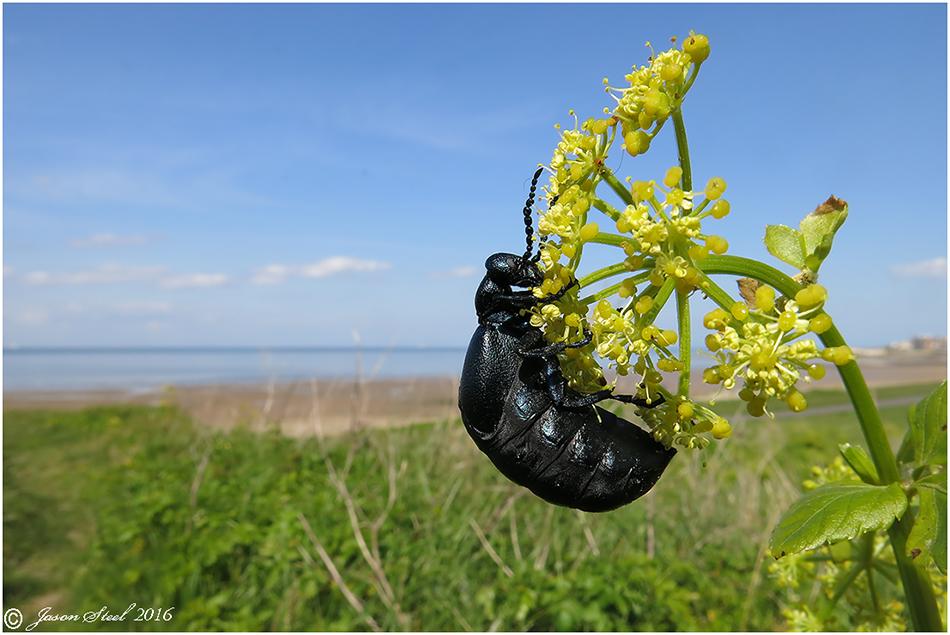
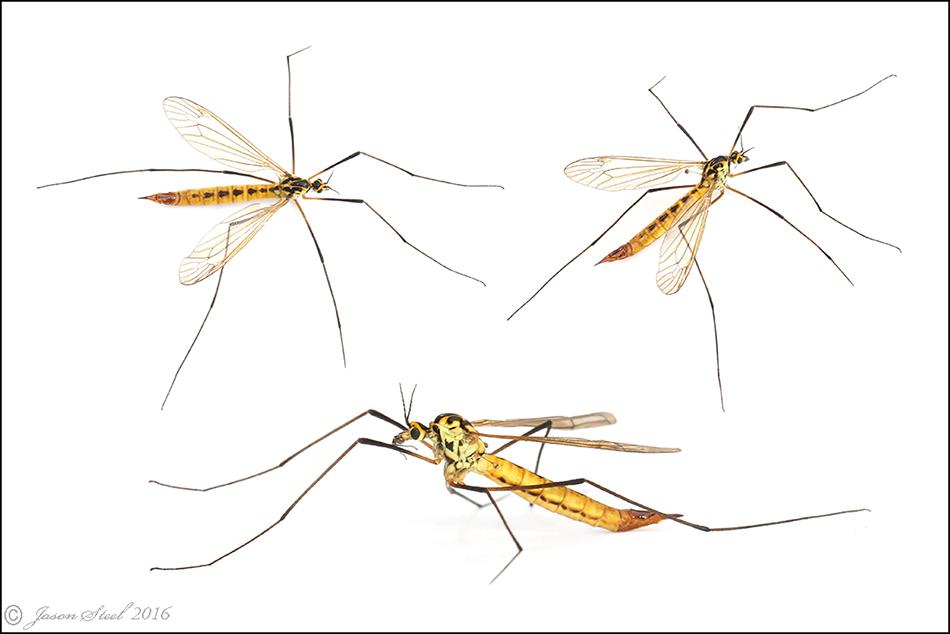
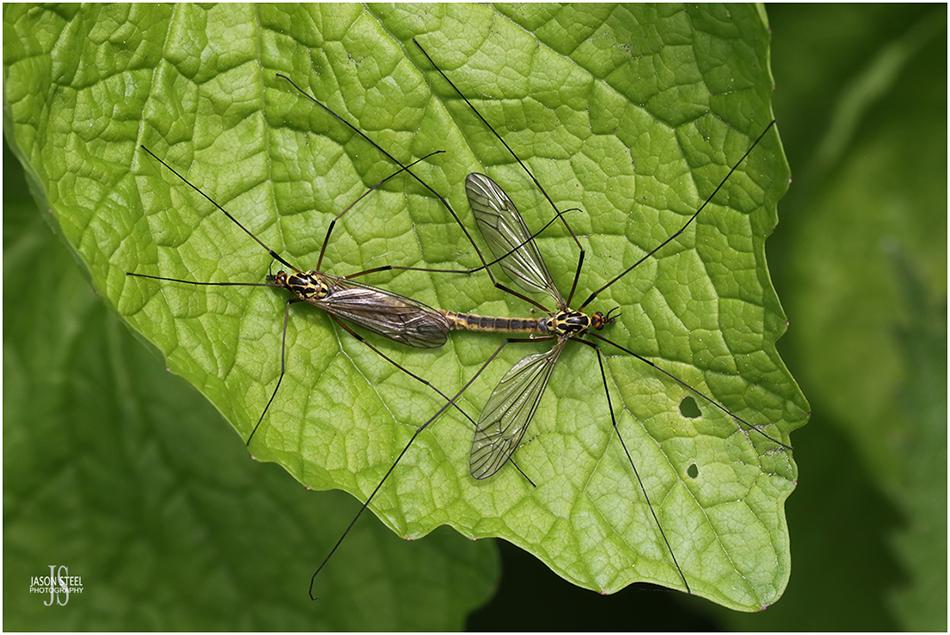
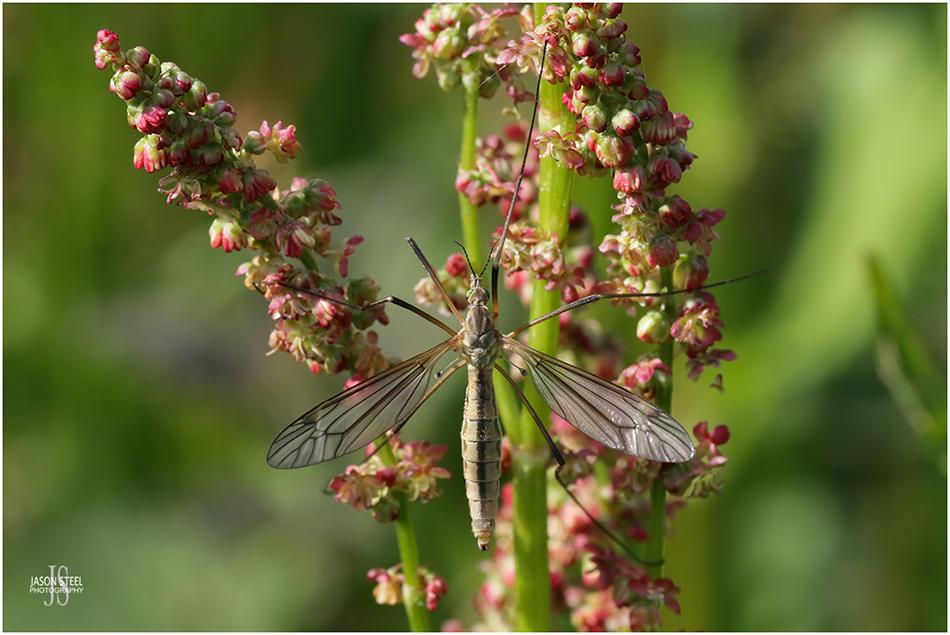
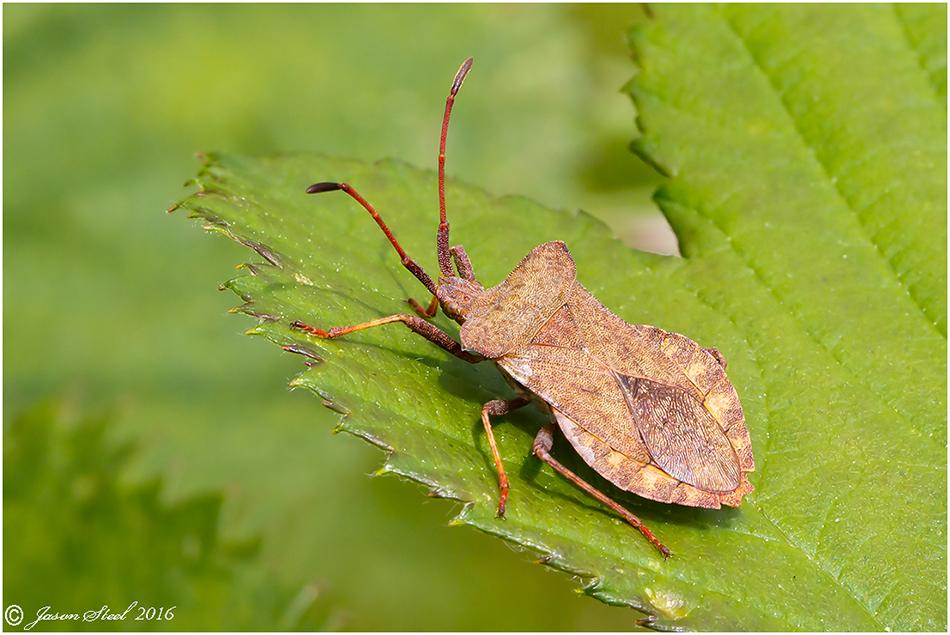
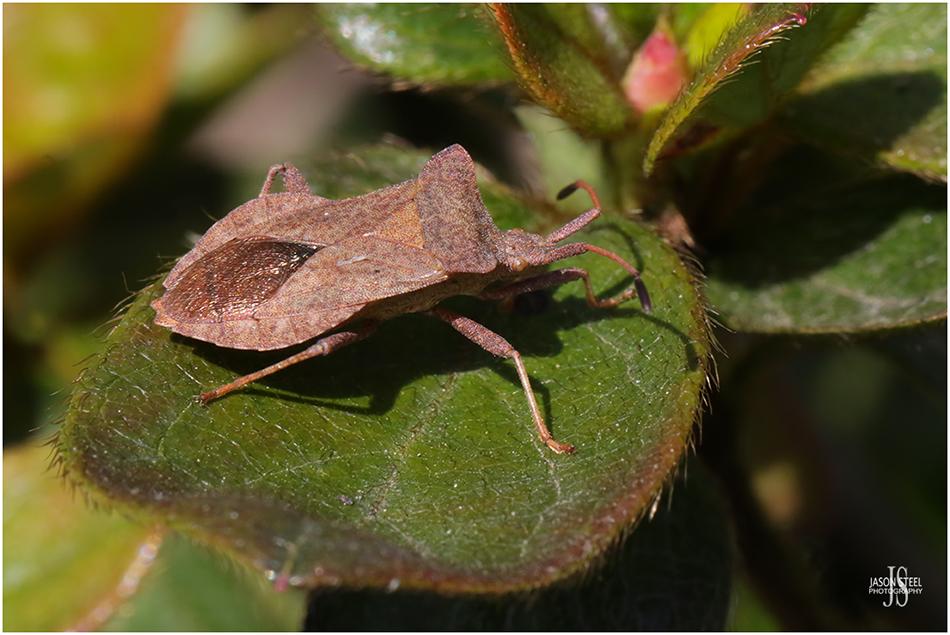
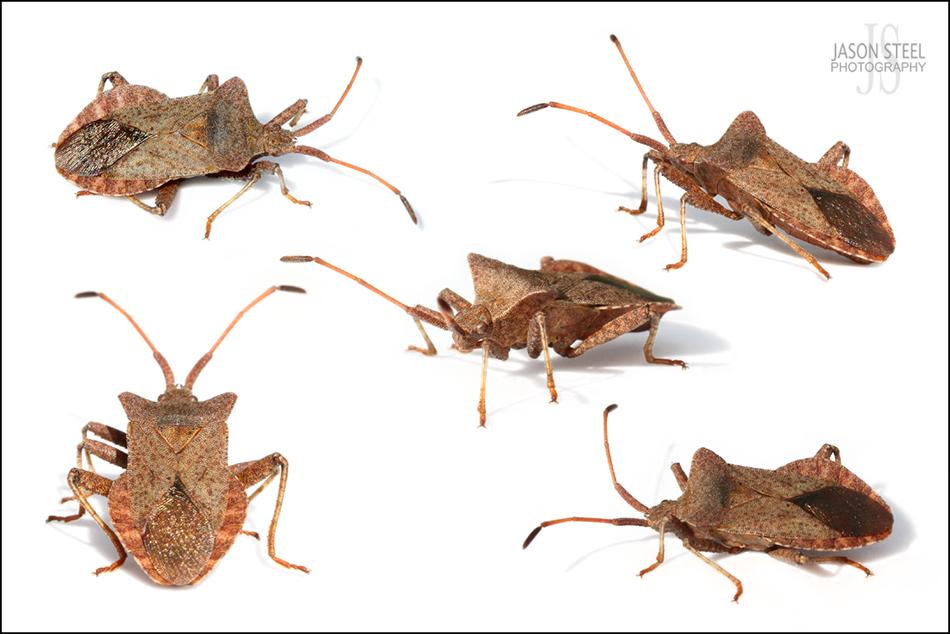
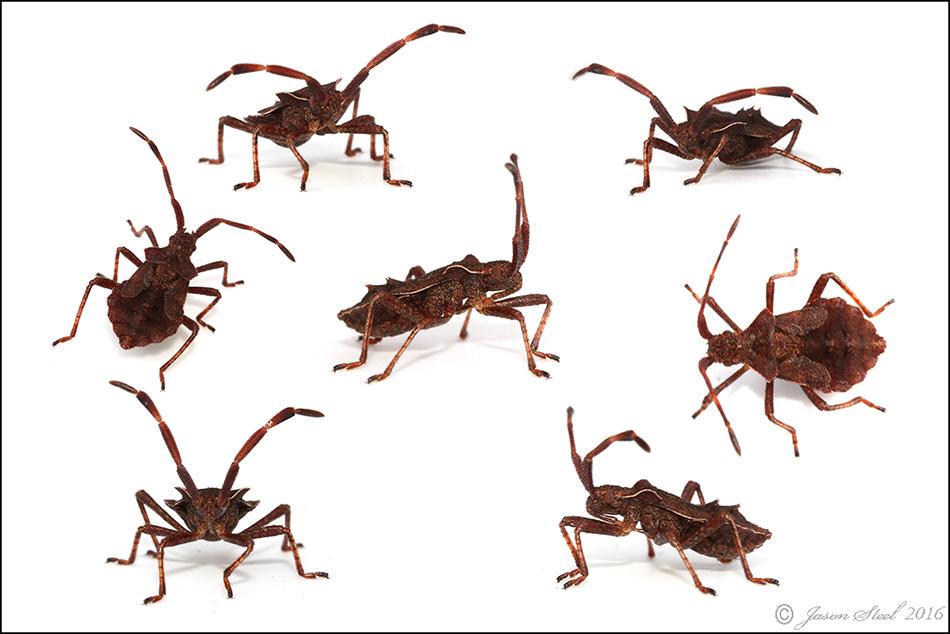
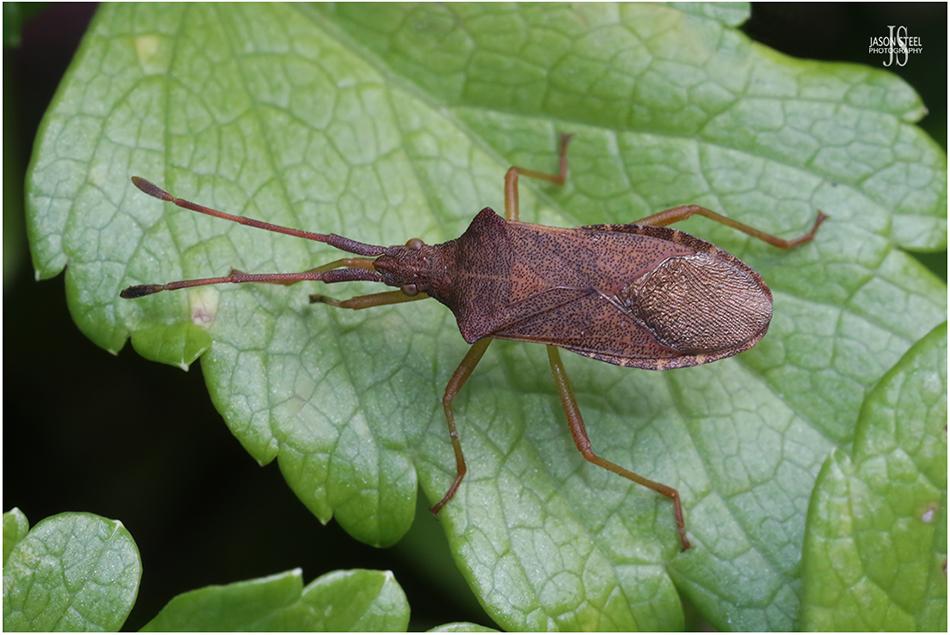
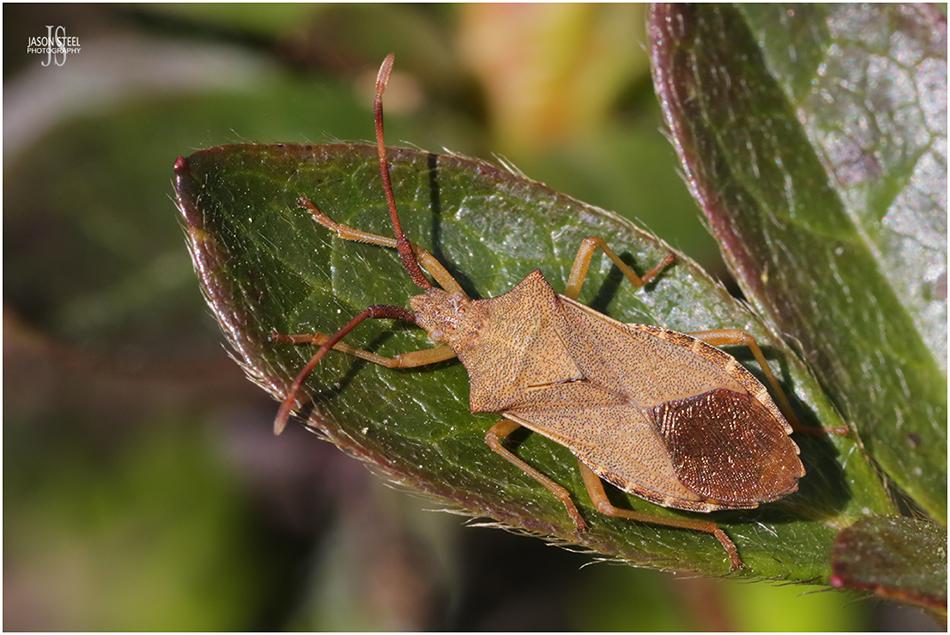
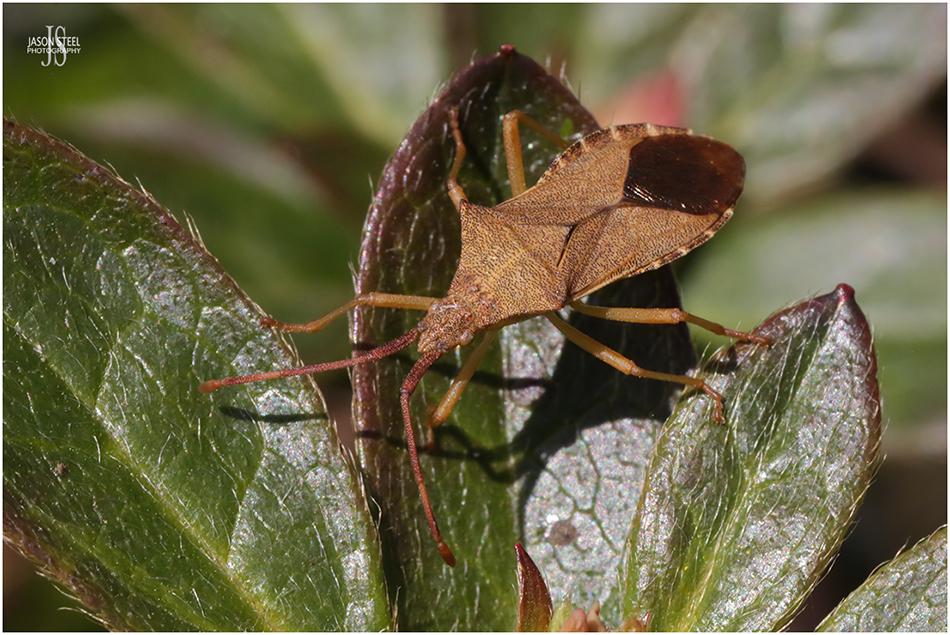
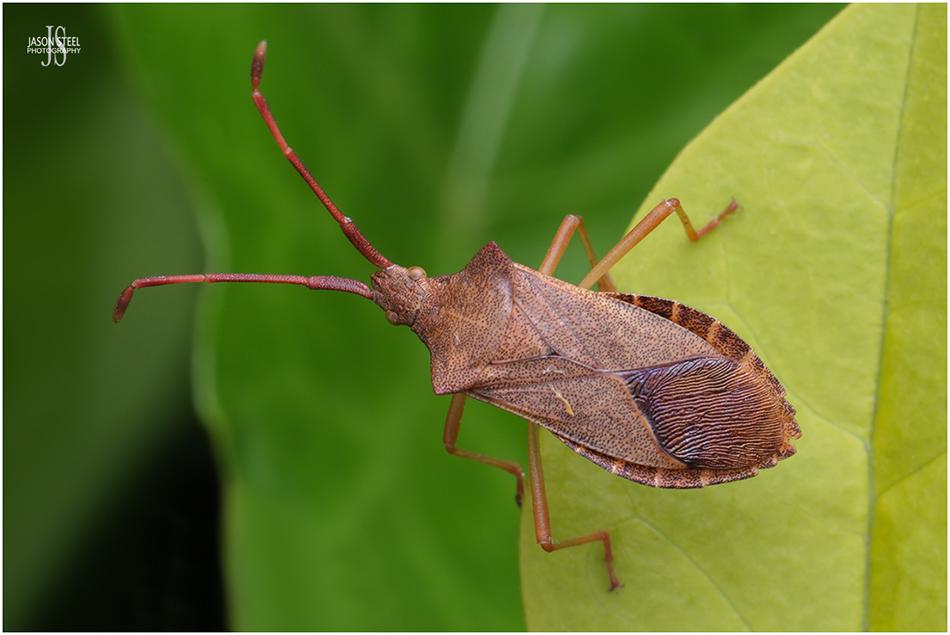
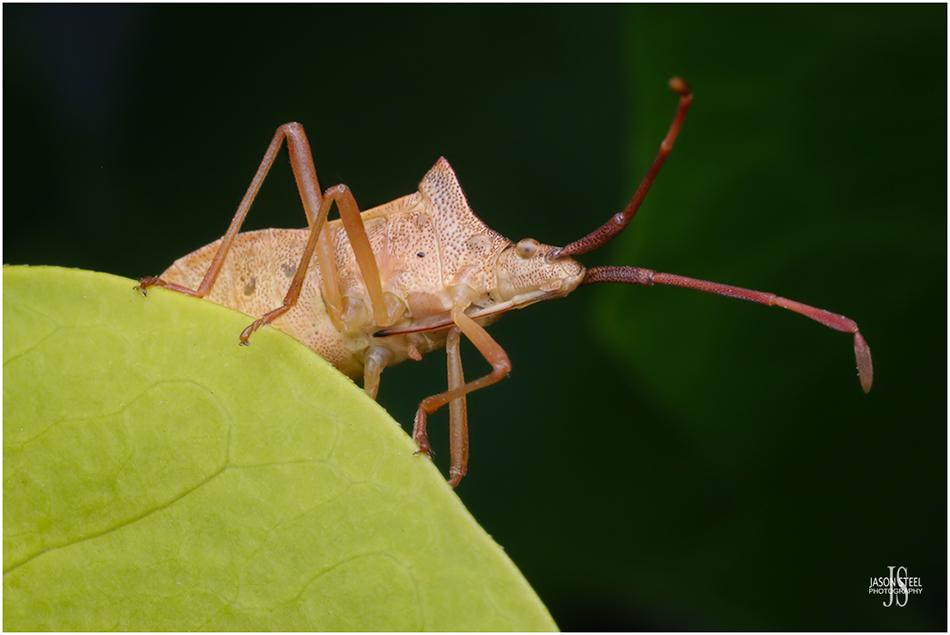
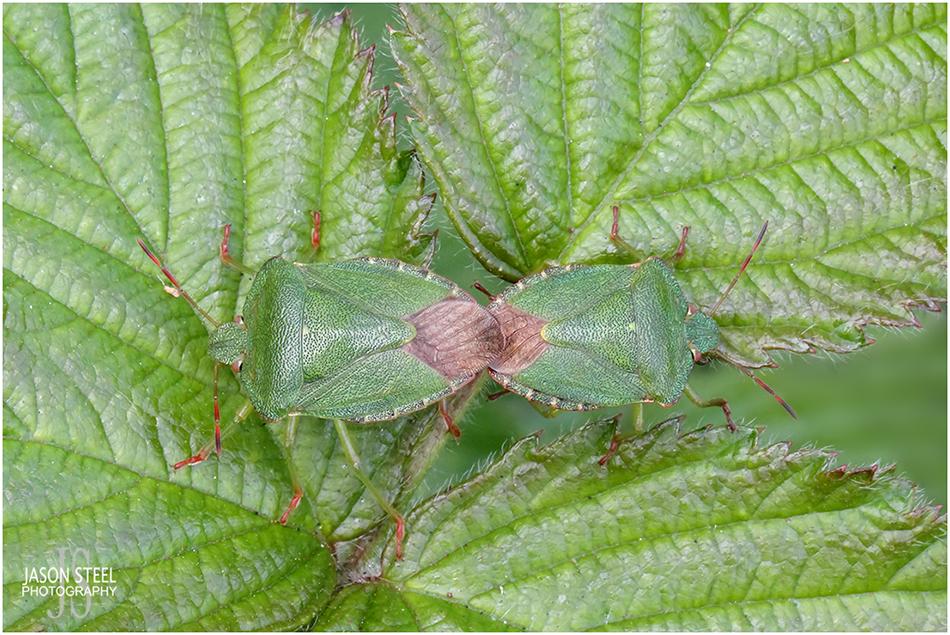
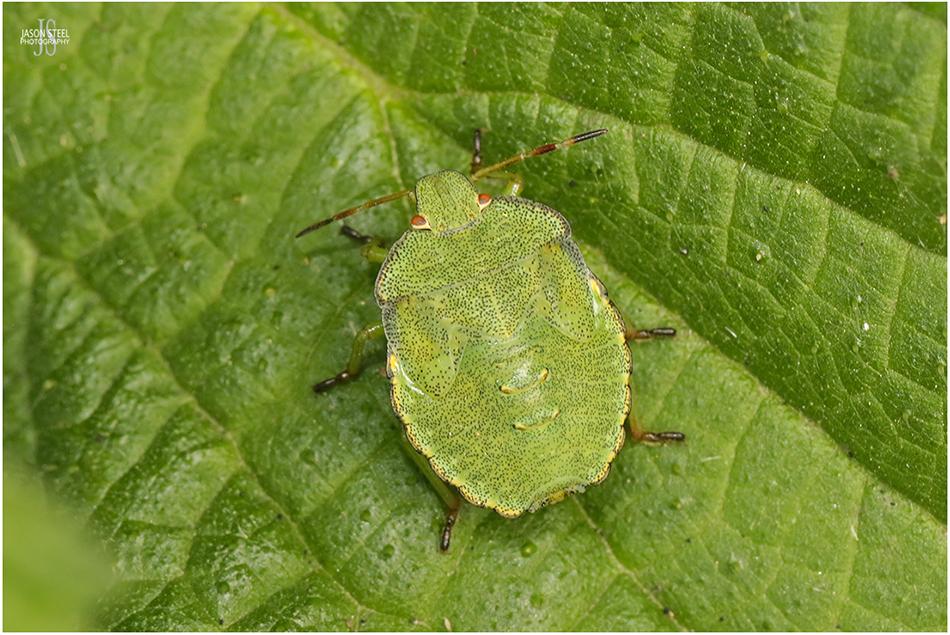
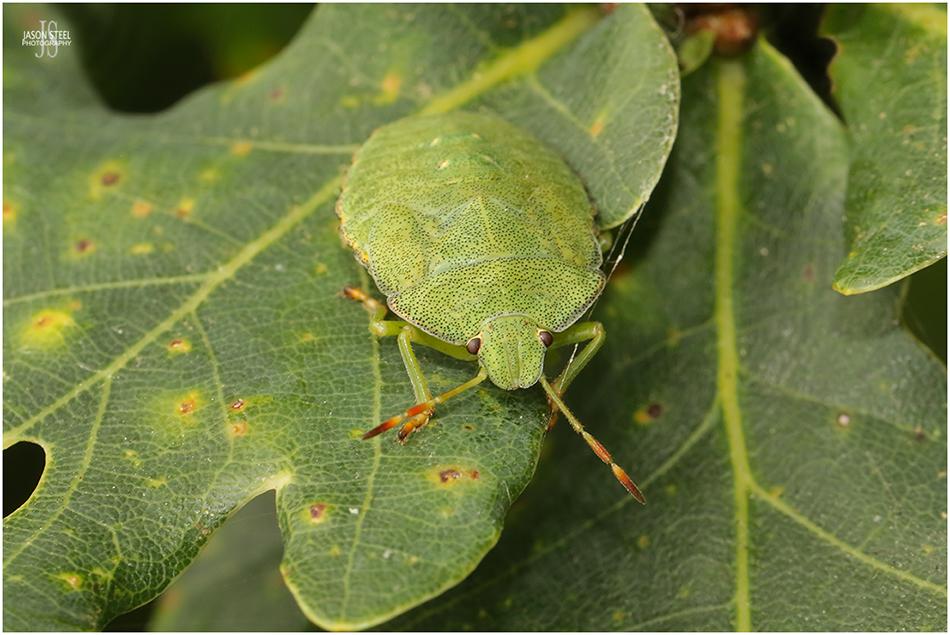
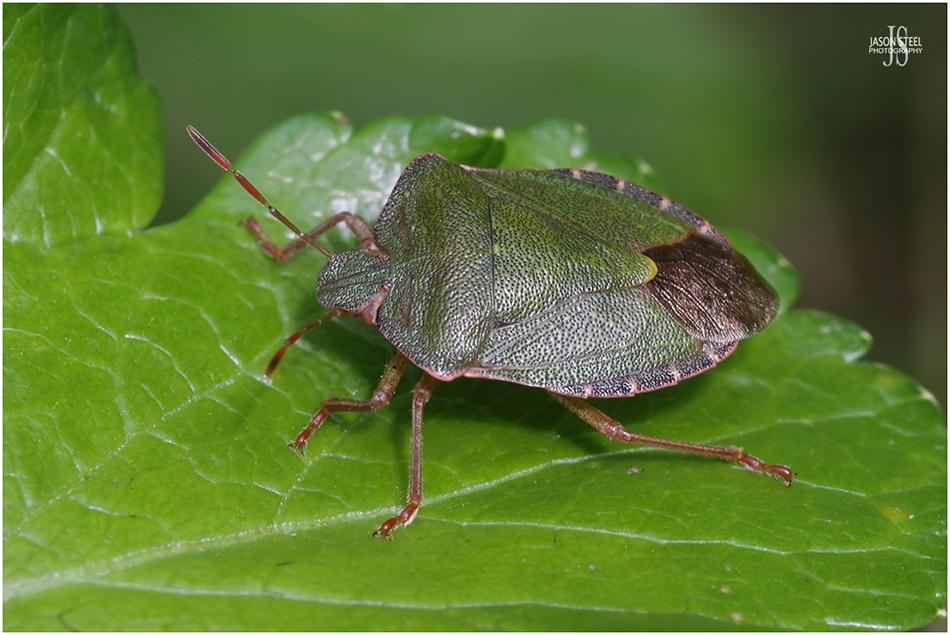
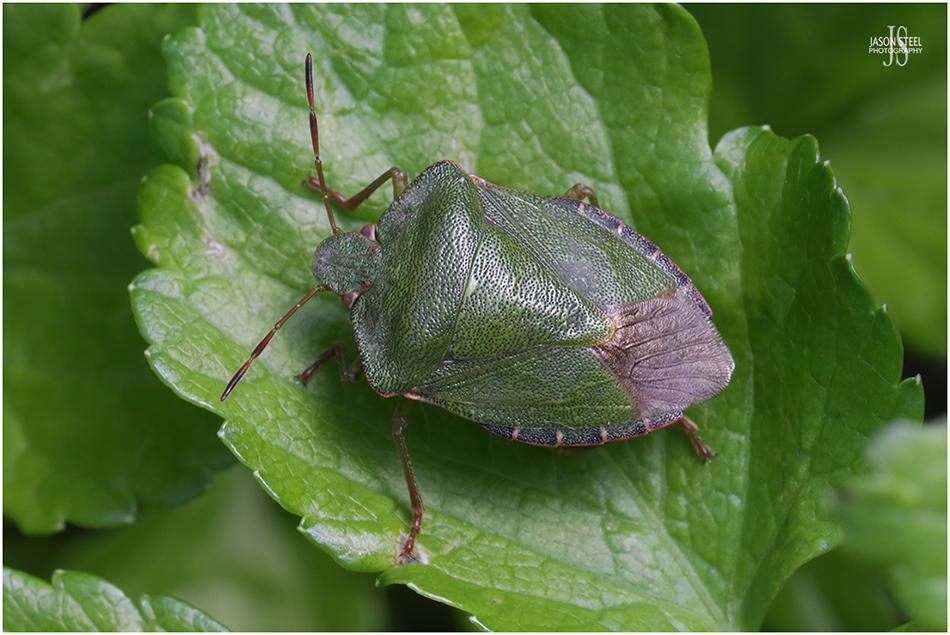
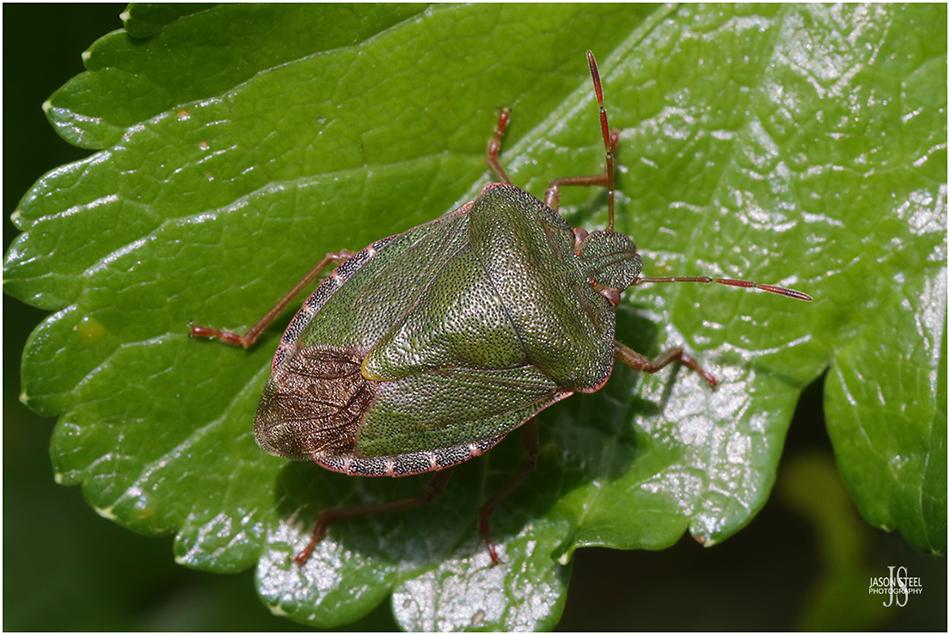
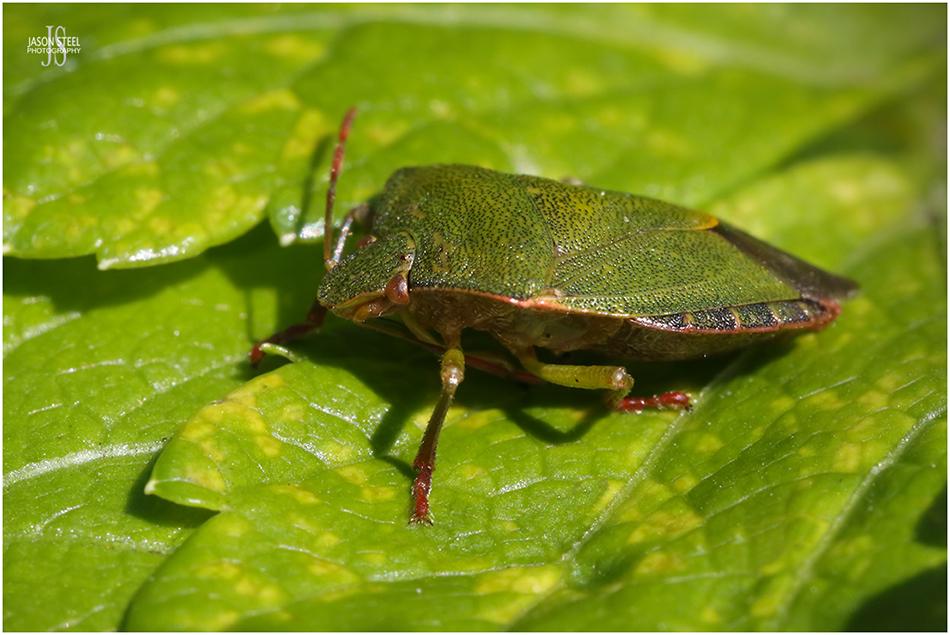
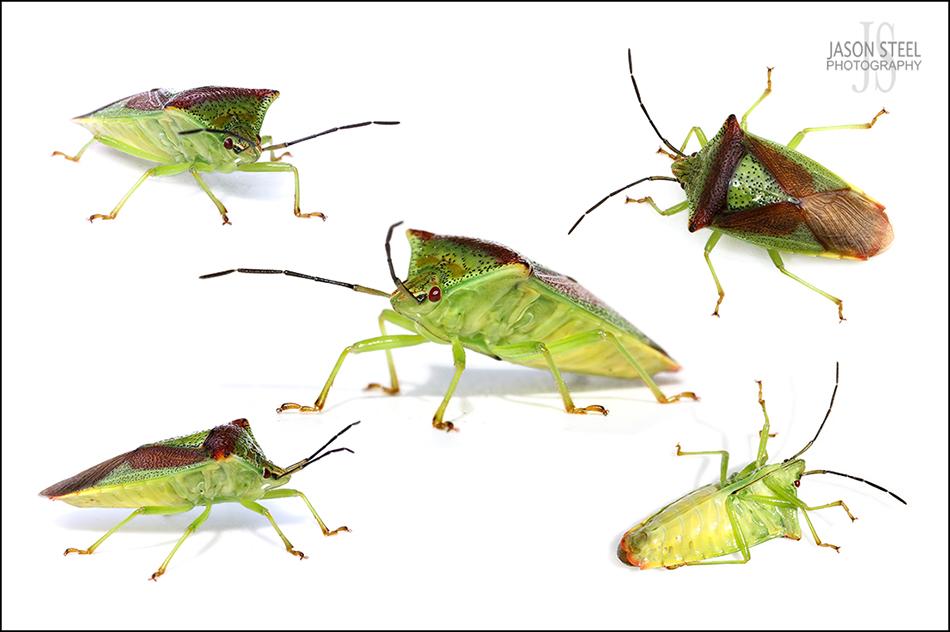
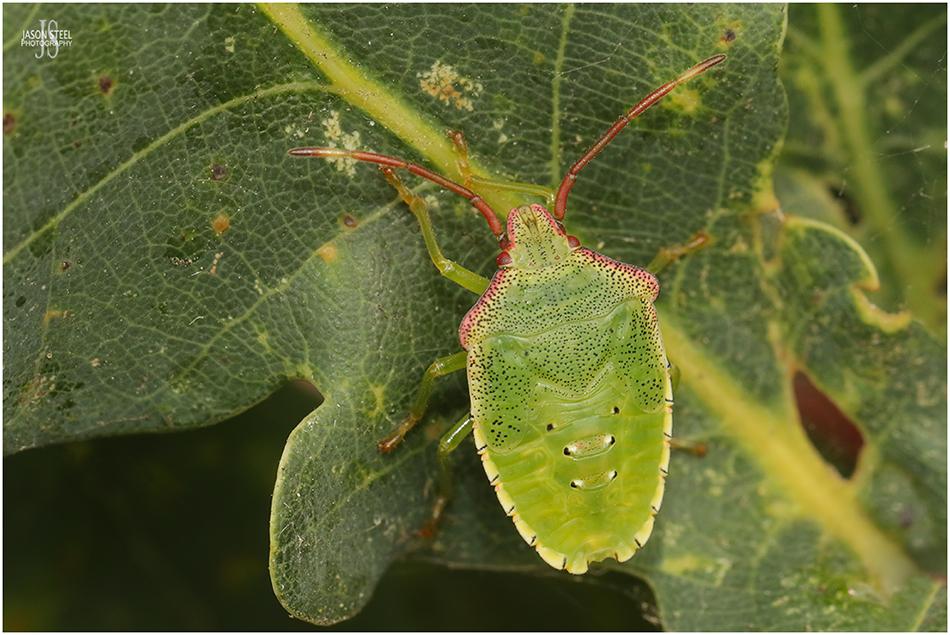
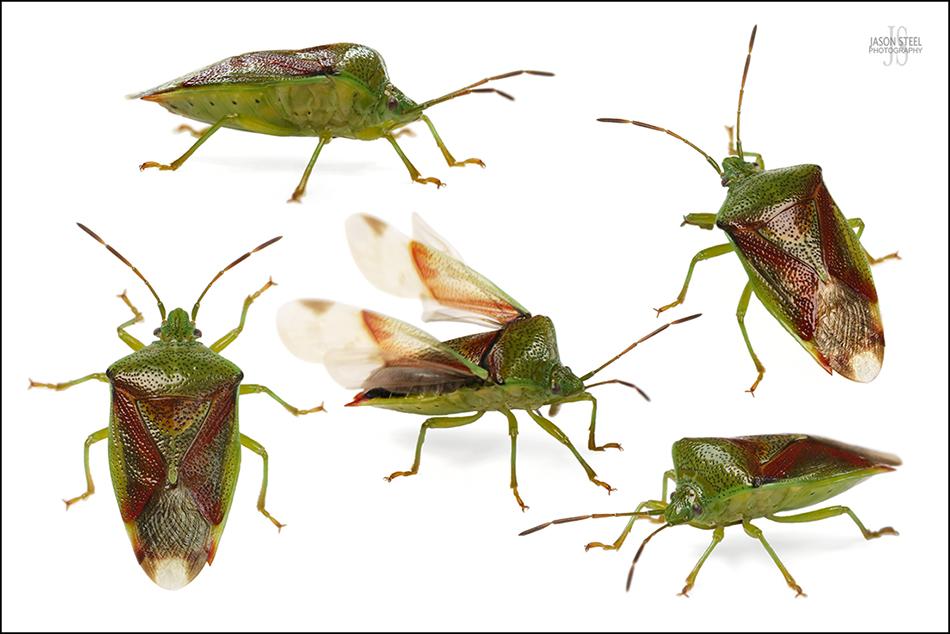
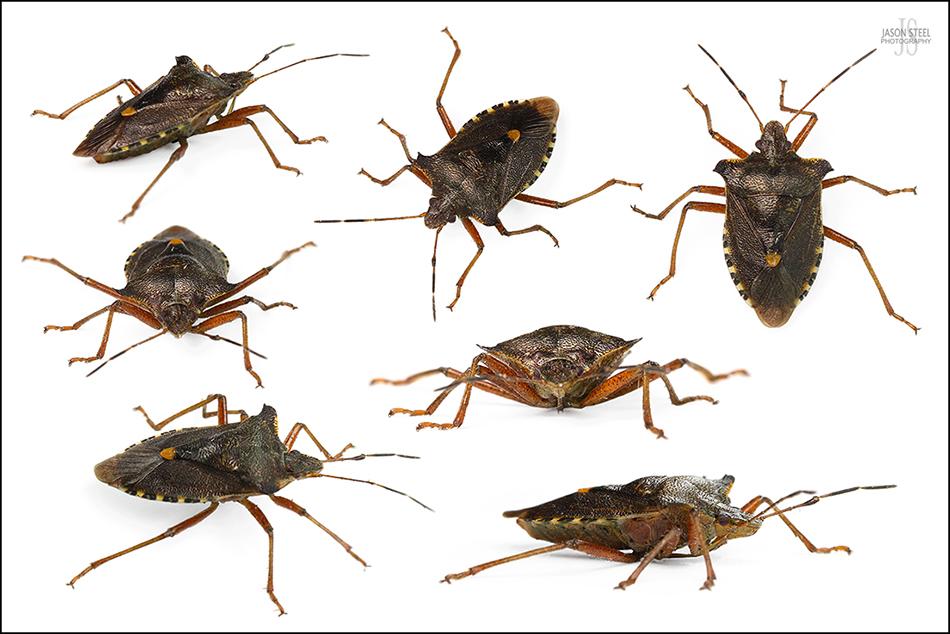
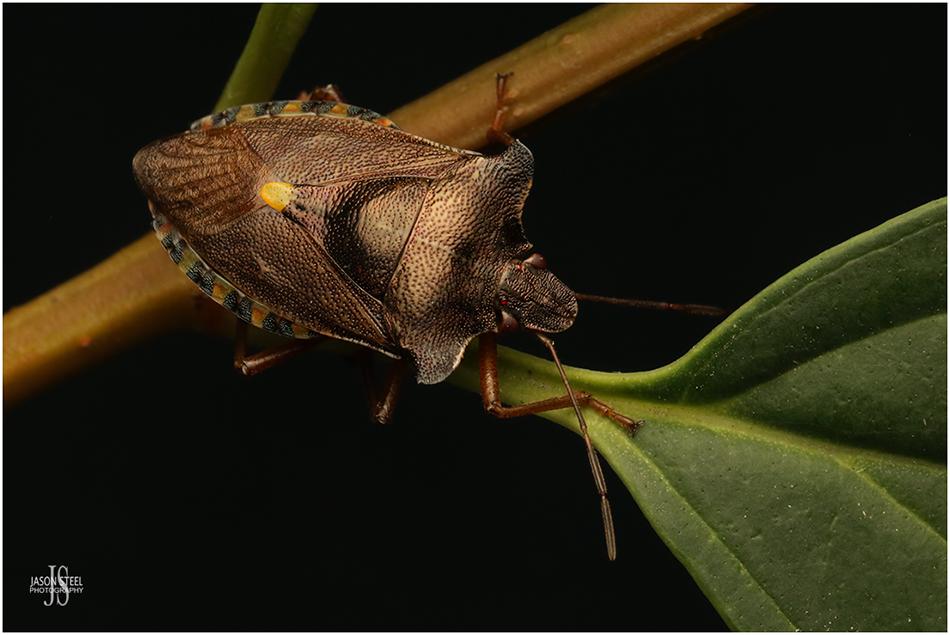
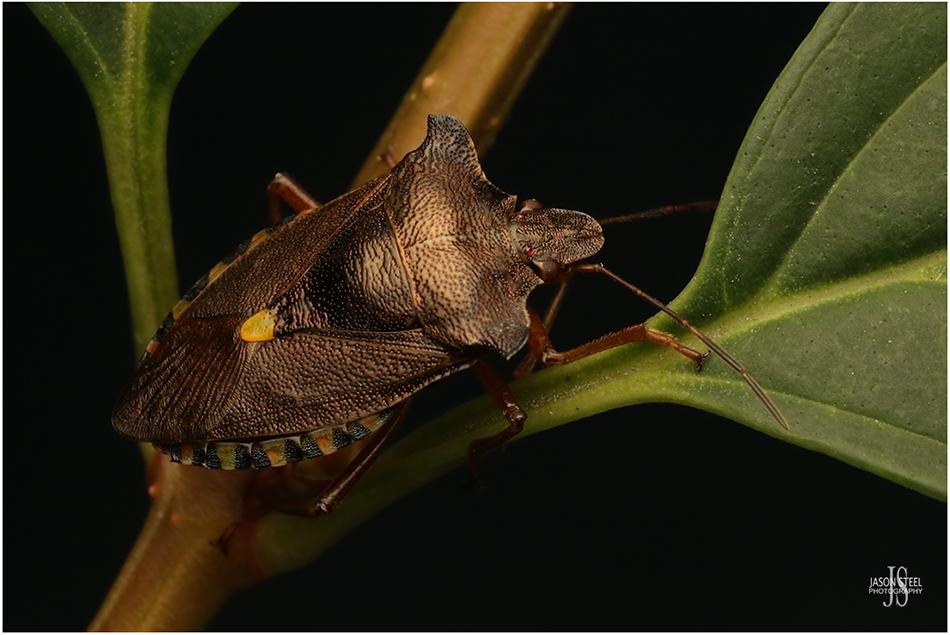
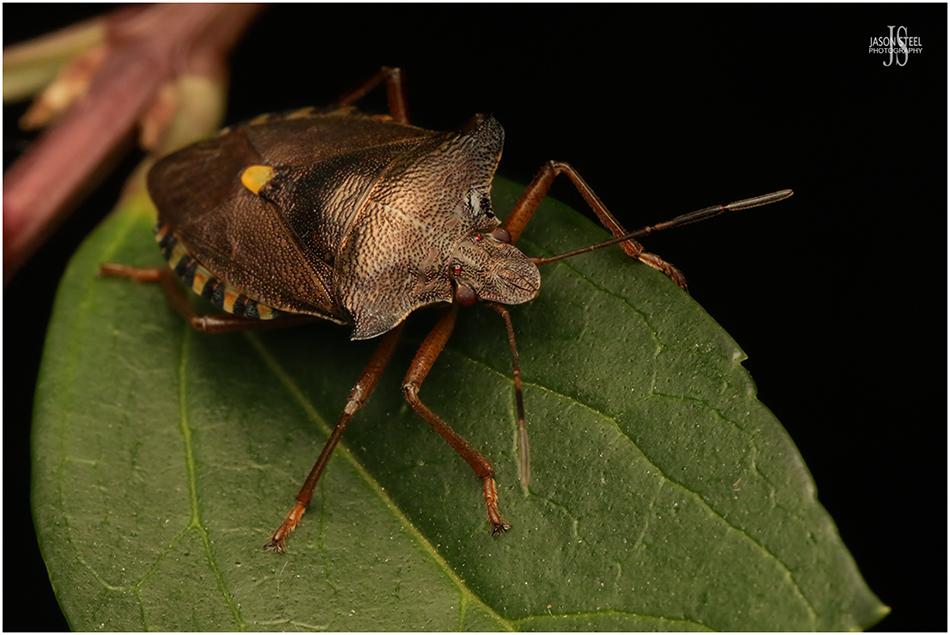
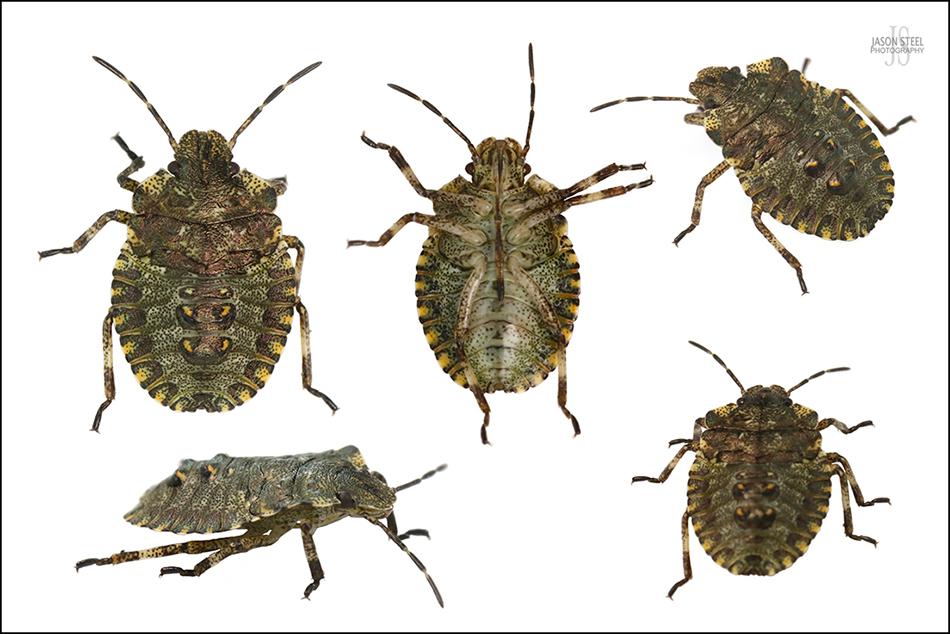
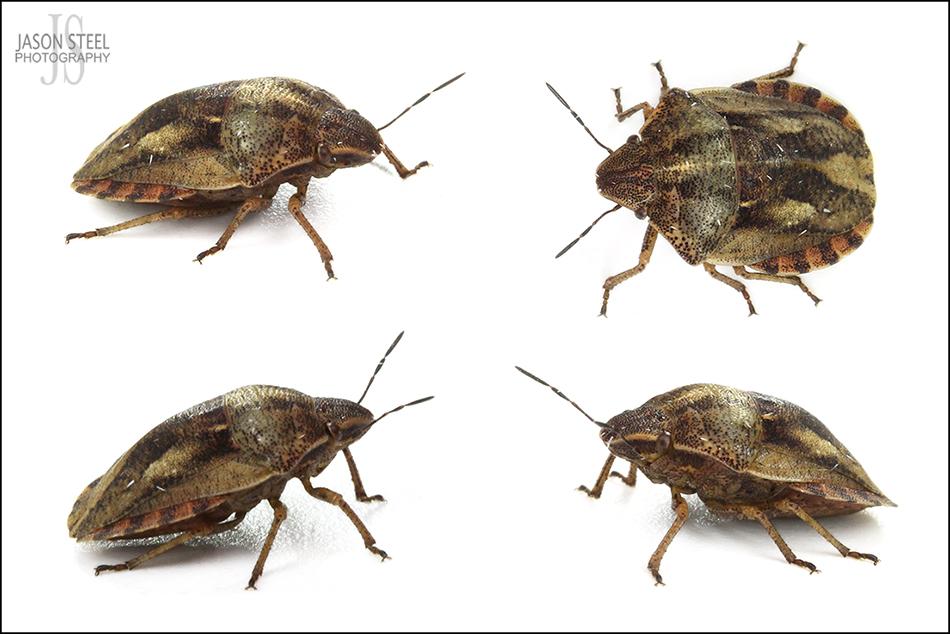
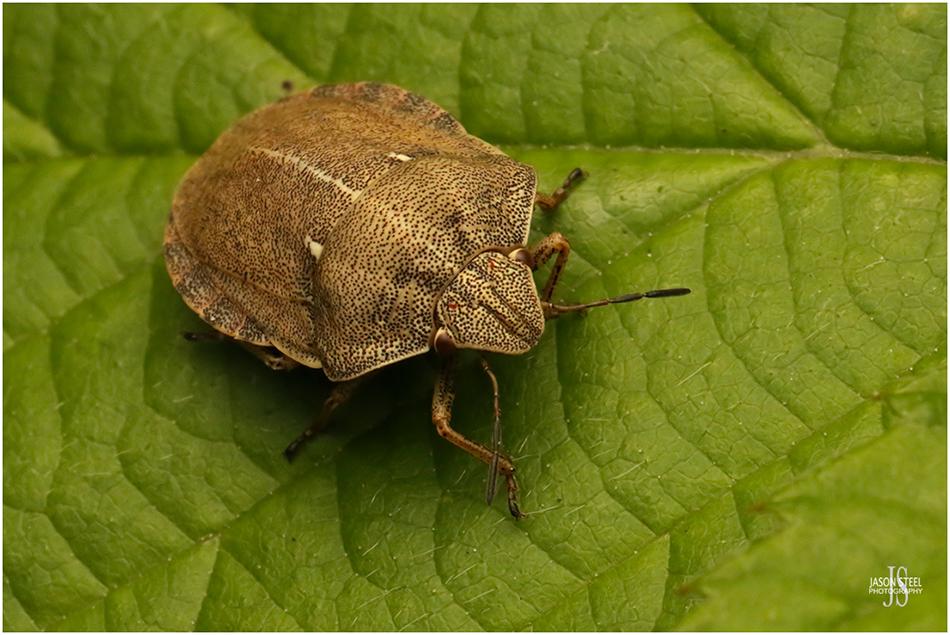
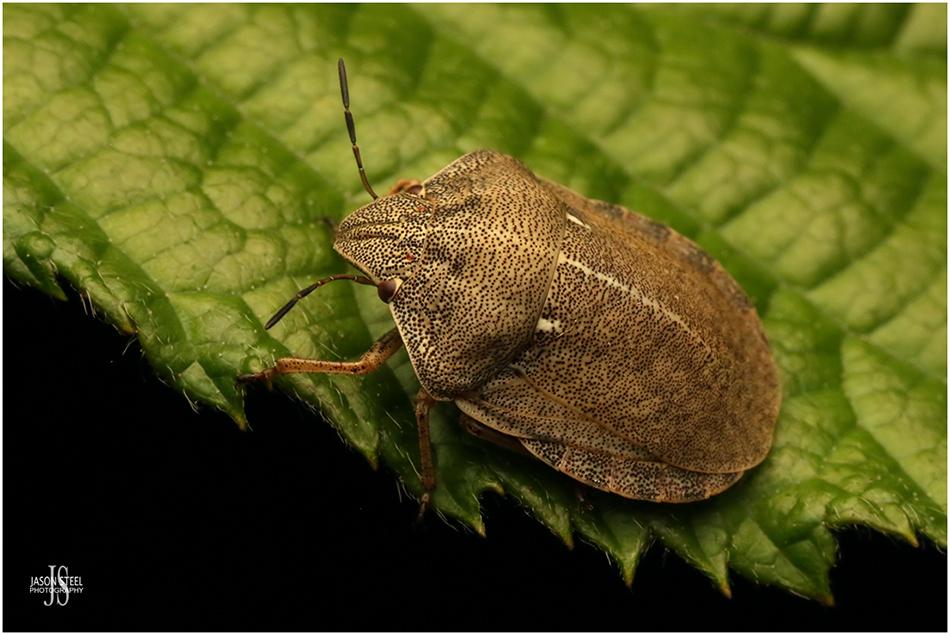
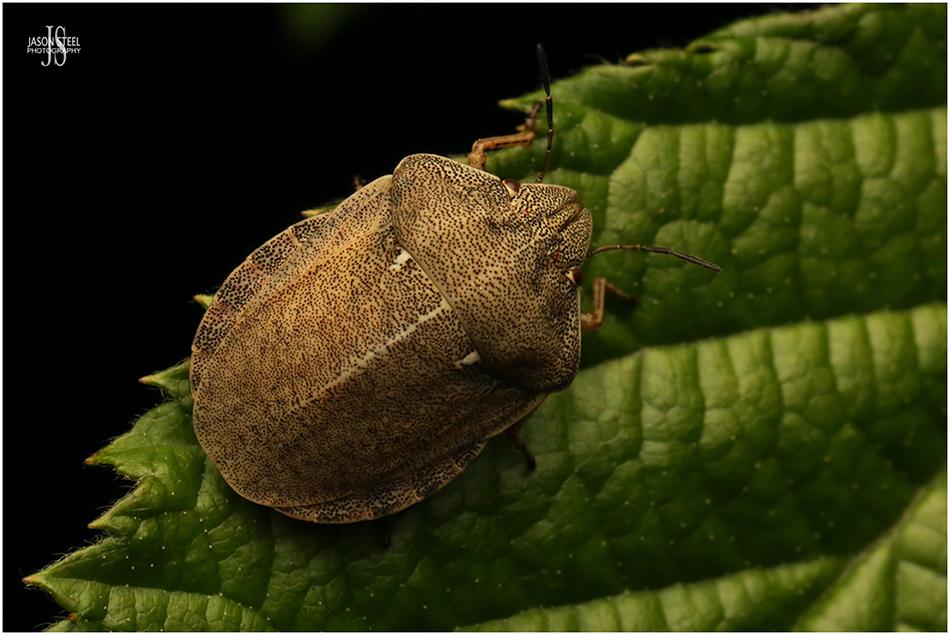
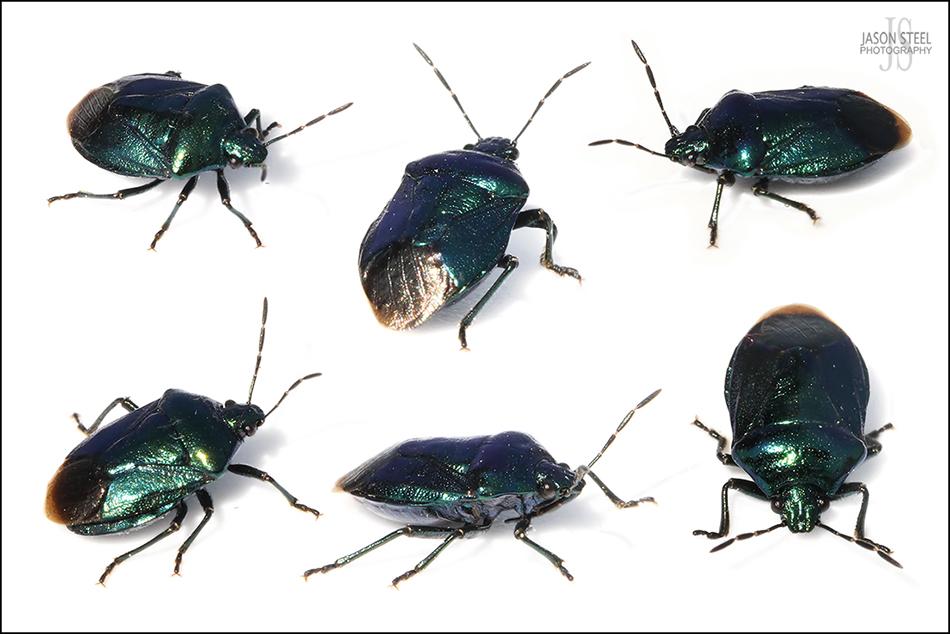
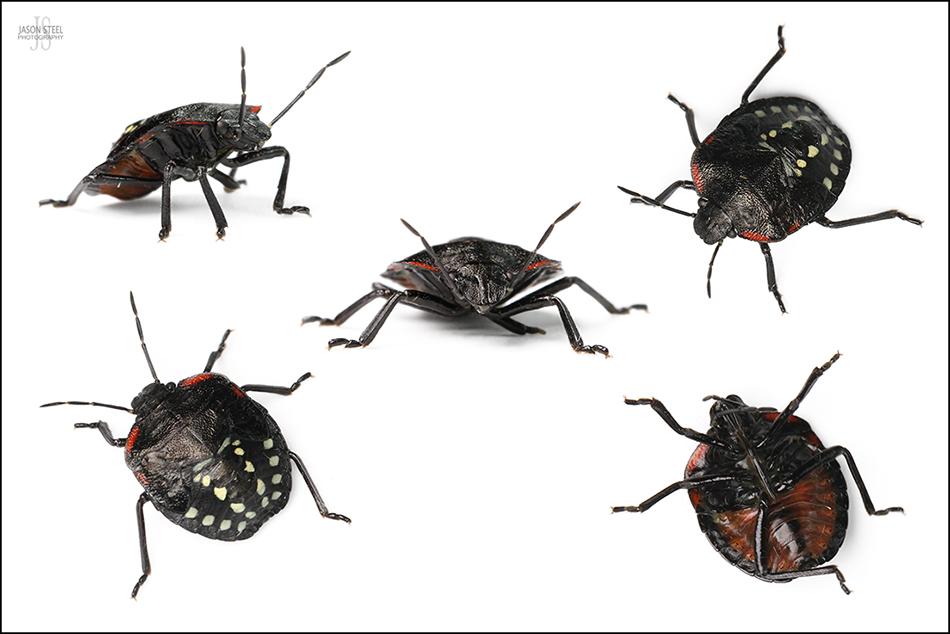
This invasive species is originally from Africa and has been breeding in the UK since 2003 where it was first recorded in London. Whilst easily recognisable as an immature specimen once mature the Southern Green Shieldbug is almost completely green in colour and at first glance identical to our native Common Green Shieldbug, Palomena prasina. The two species can be distinguished by a feint row of 3-5 white spots across the top of the shoulders of the Southern Green Shieldbug, that are not present on the Common Green Shieldbug. The Southern Green Shieldbug also slightly larger that our native Common Green Shieldbug and as an adult grows to a length of around 11-15mm.
The Southern Green Shieldbug is most commonly recorded on allotment sites where despite feeding on a variety of plants it seems to have a preference for runner beans, french beans, raspberries and tomatoes, where it causes distorted bean pods and damaged fruits. Damage is caused as the Shieldbug sucks the sap from fruit, seeds, leaves and stems of the host plants. Instars are black, green, or black & green but adults, as the name suggests, are completely green. Adult specimens can be found all year round but are most common from August - September. Although this species is considered as a pest in other countries the impact it is having in the UK may be limited as adult Southern Green Shieldbugs do not mature here until the end of the summer when vegetable and fruit crops are at the end of their season.
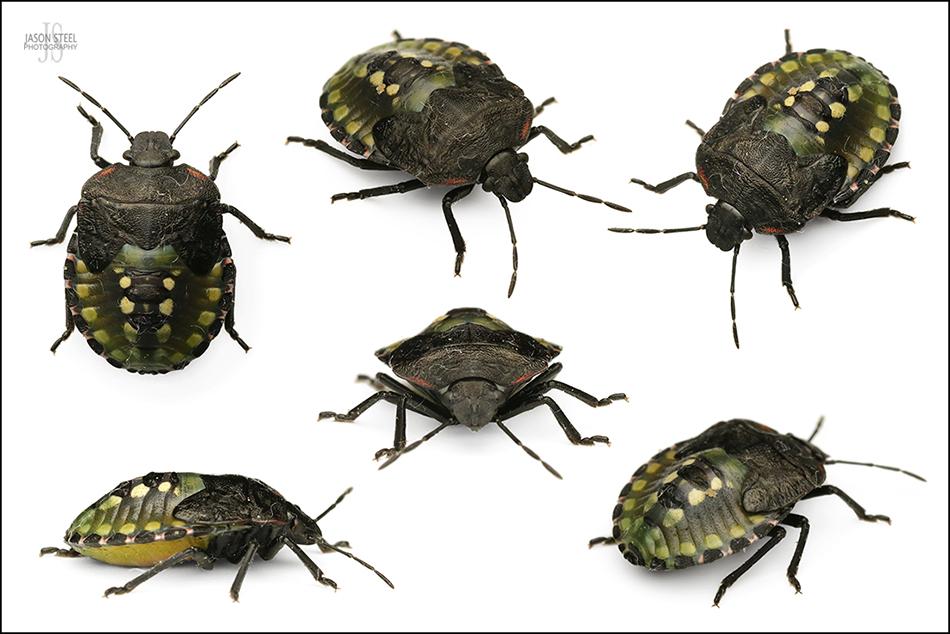
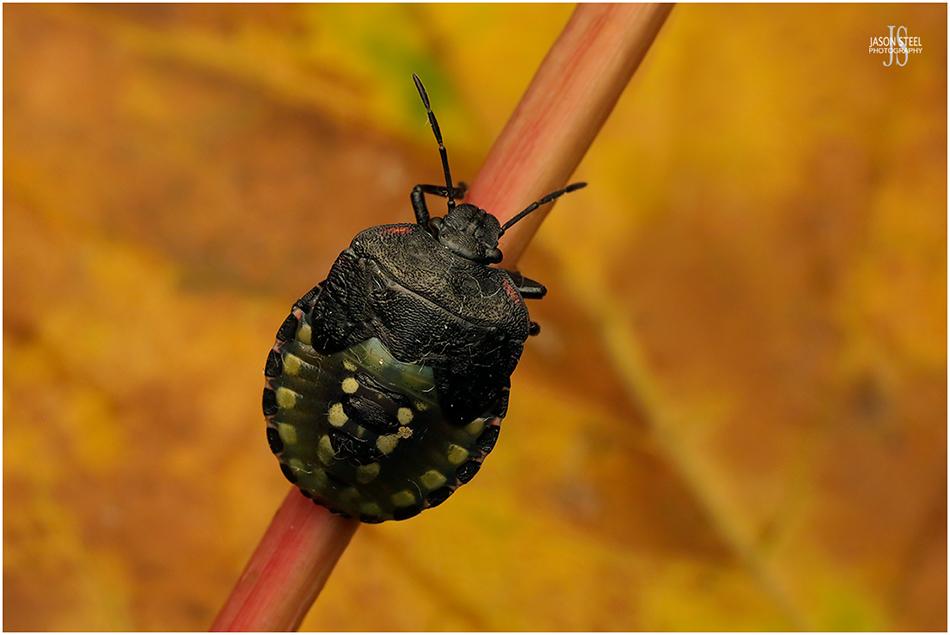
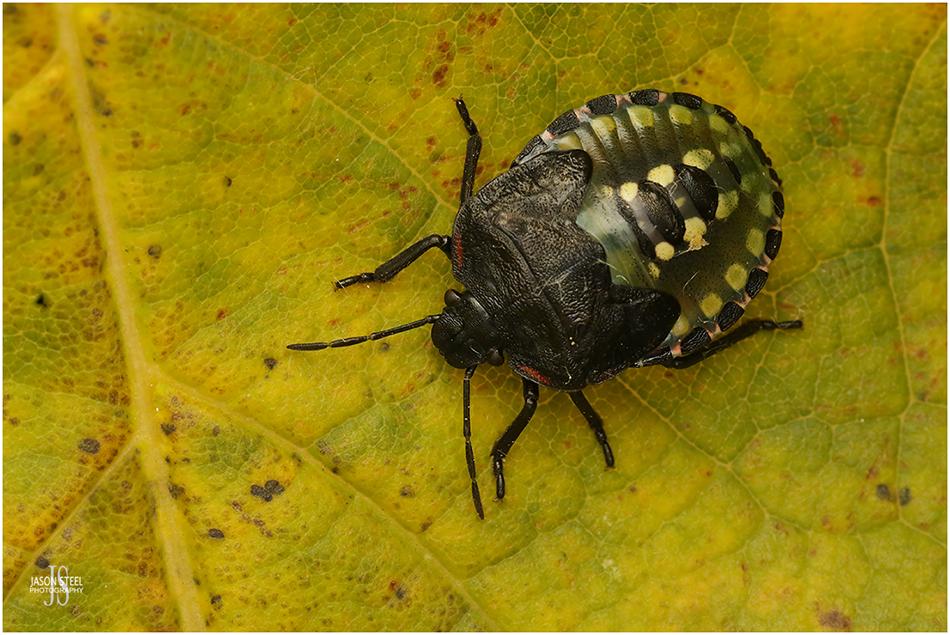
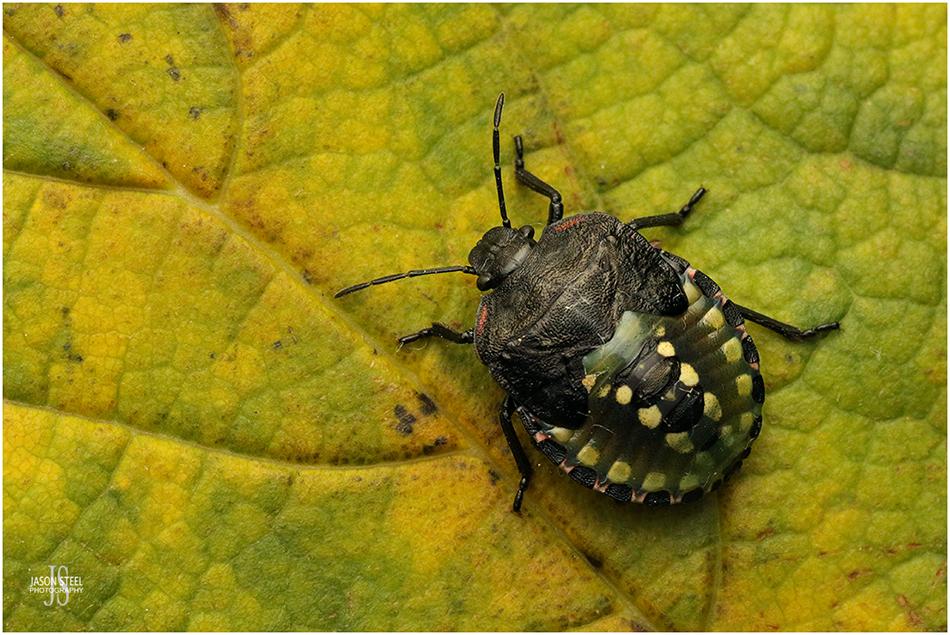
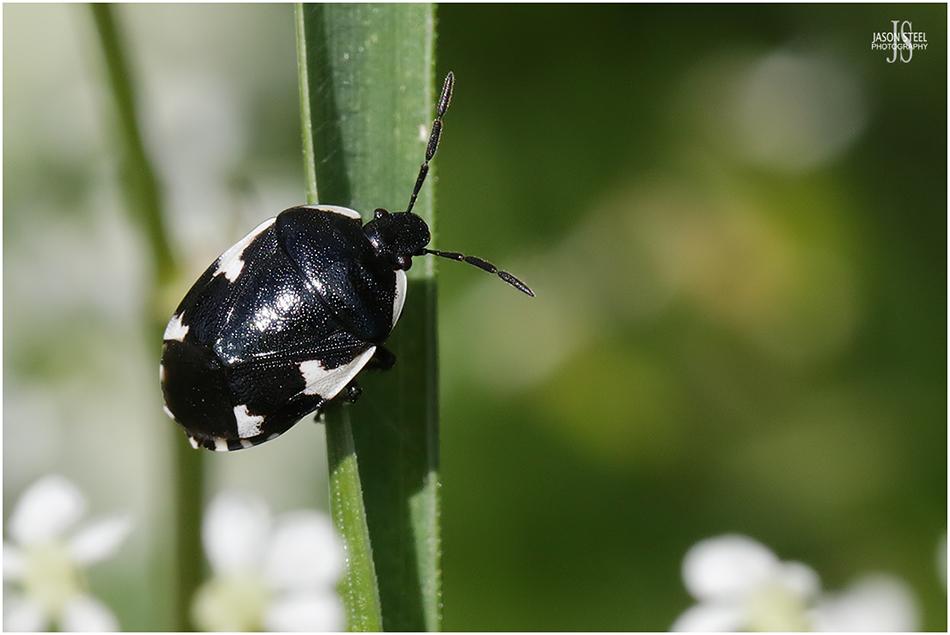
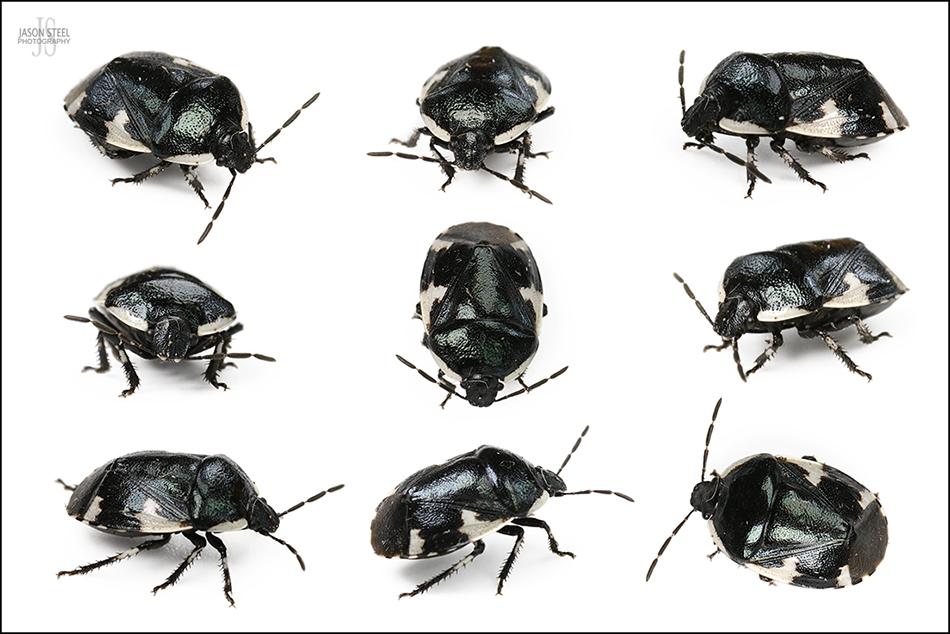
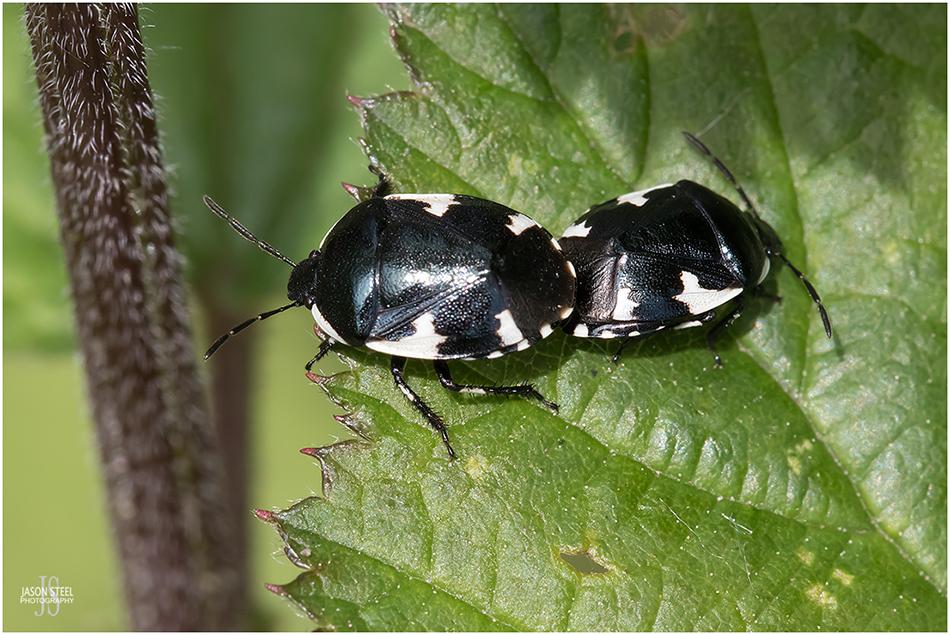
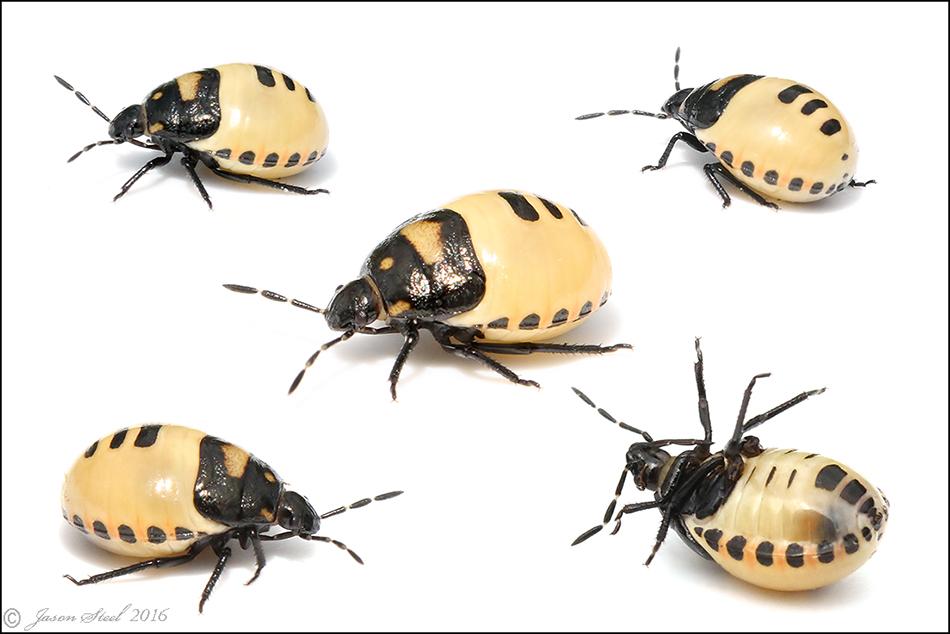
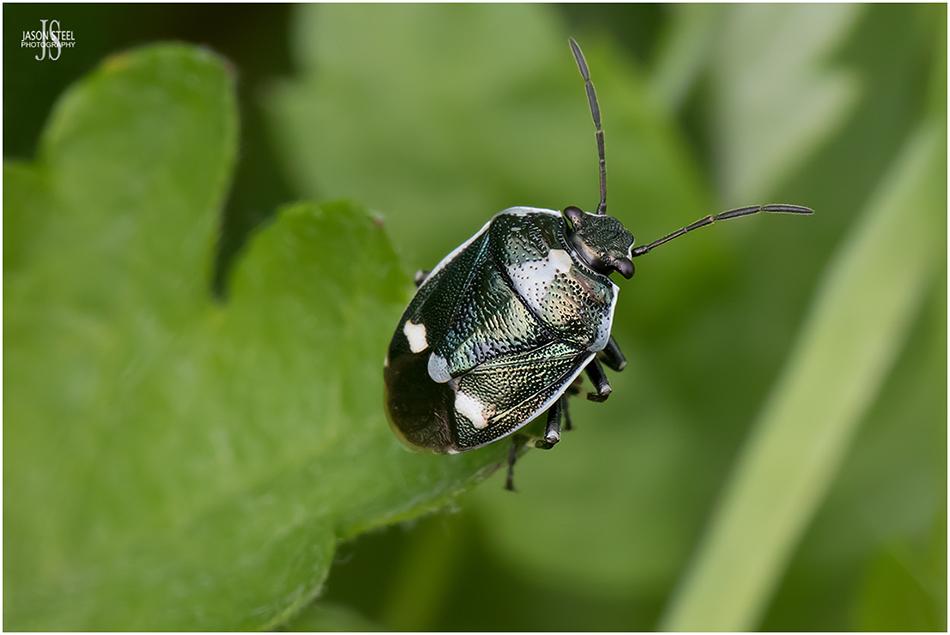
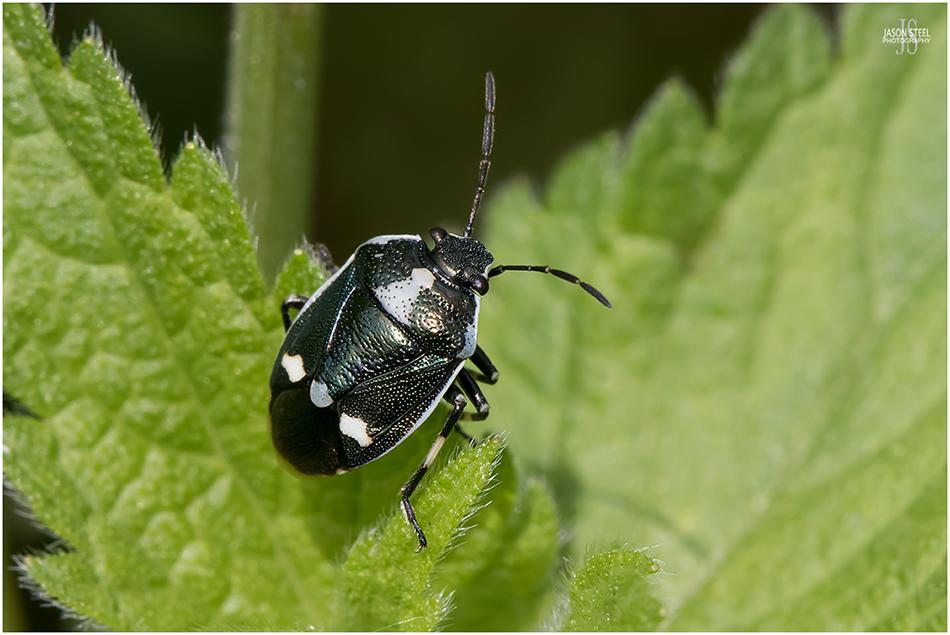
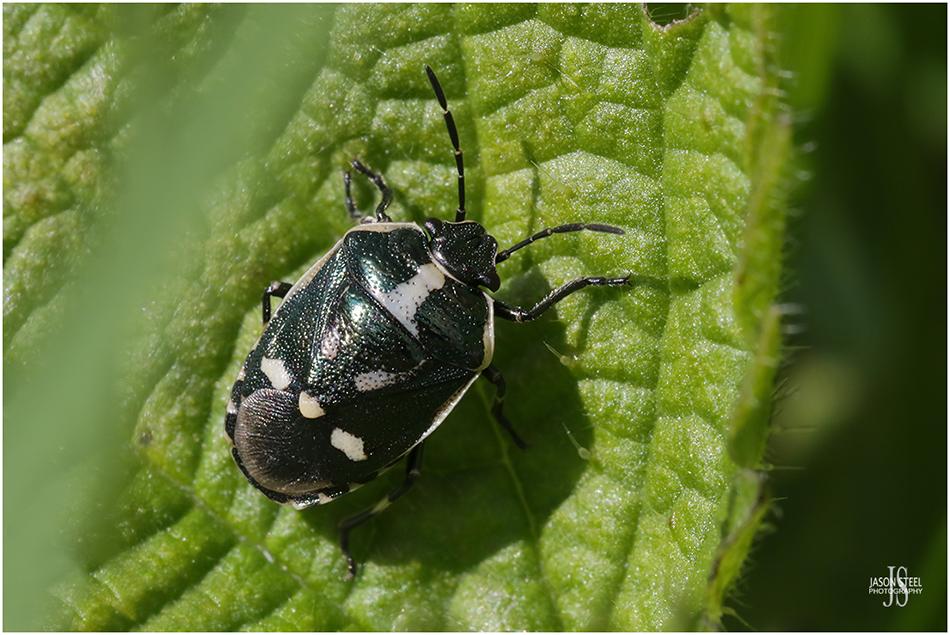
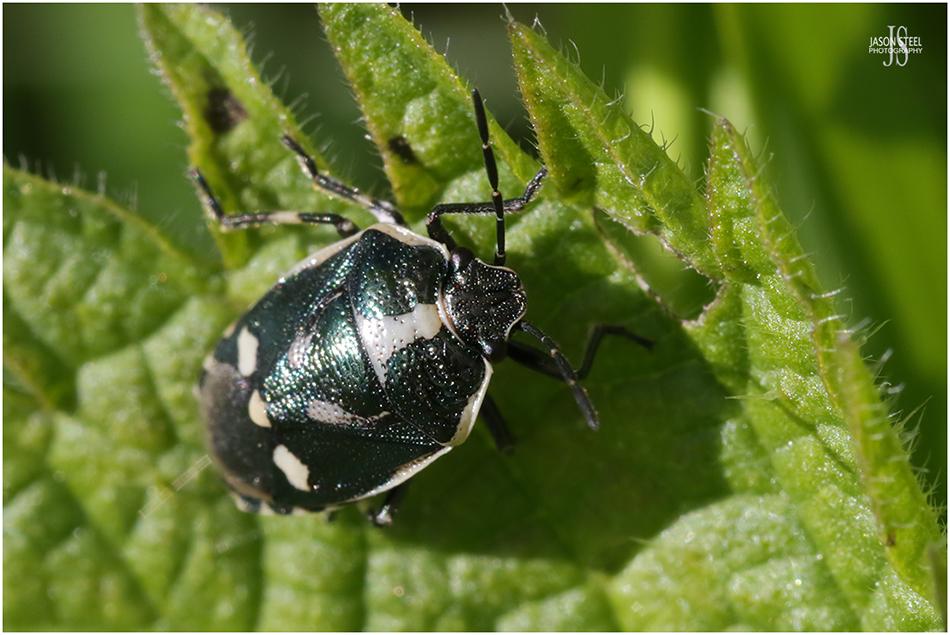
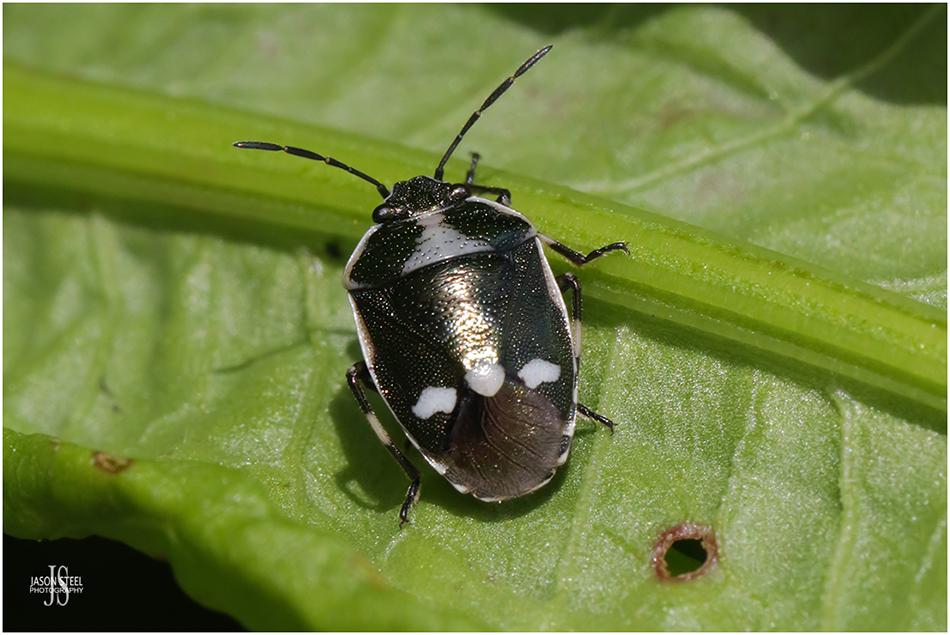
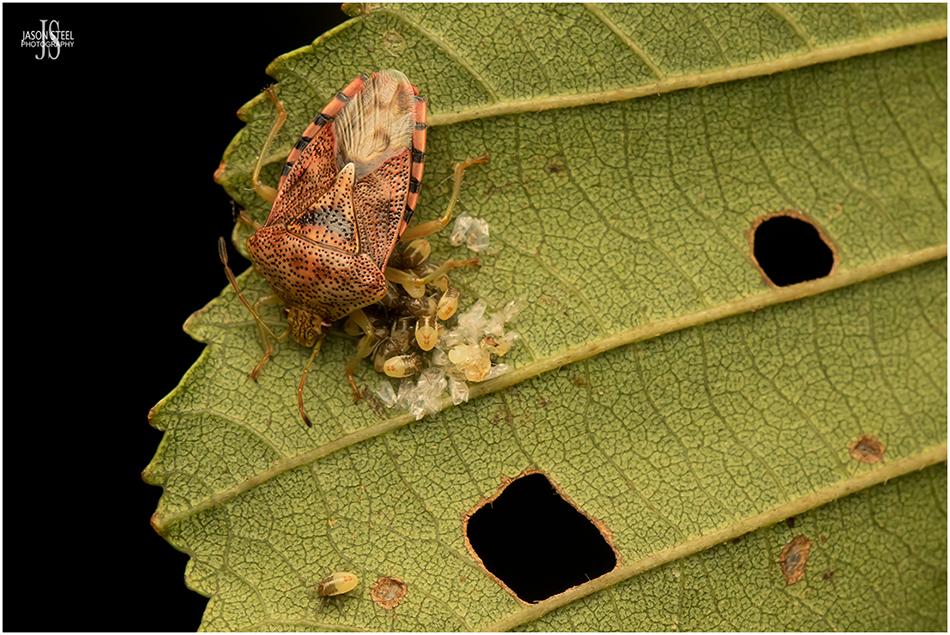
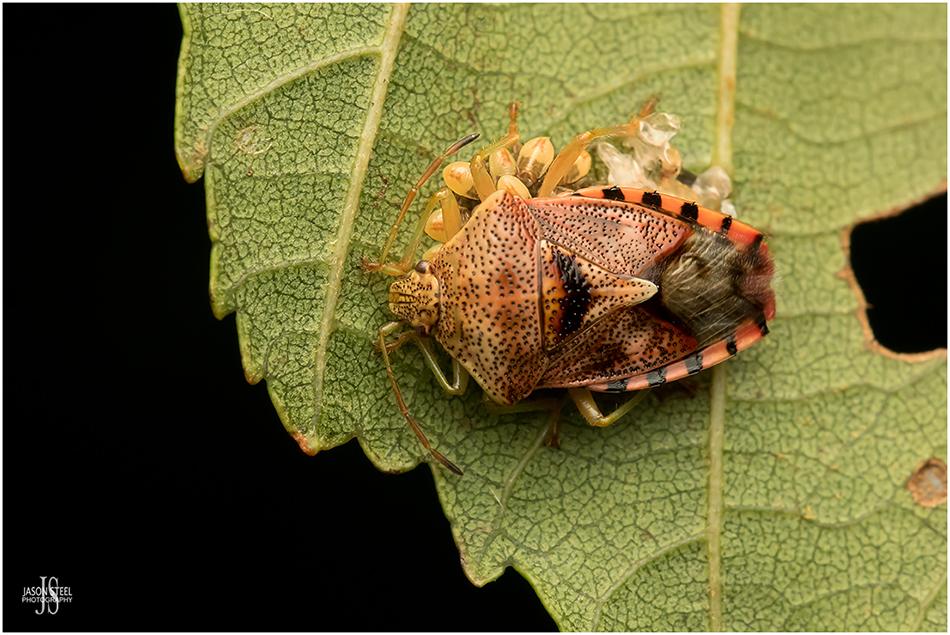
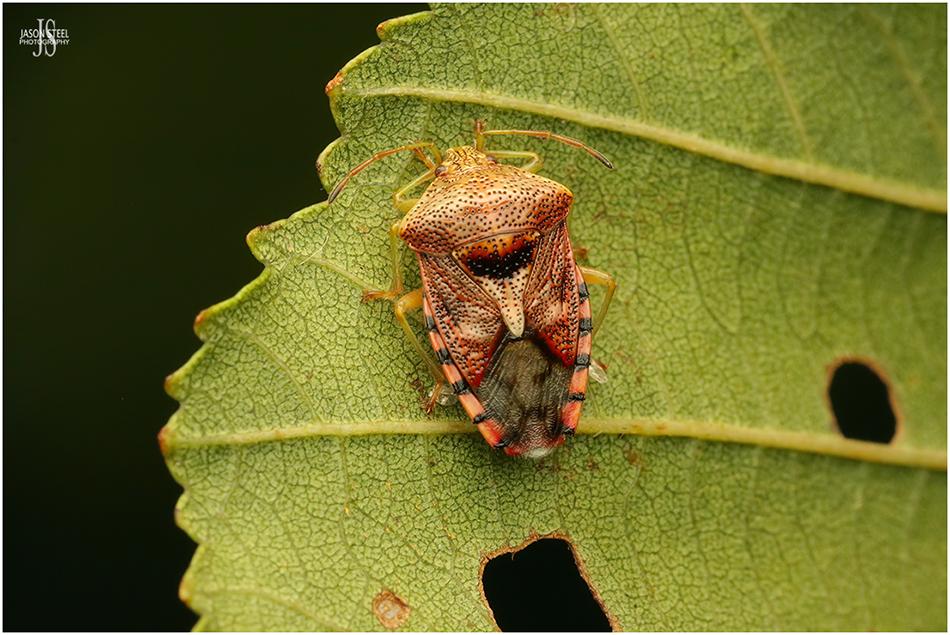
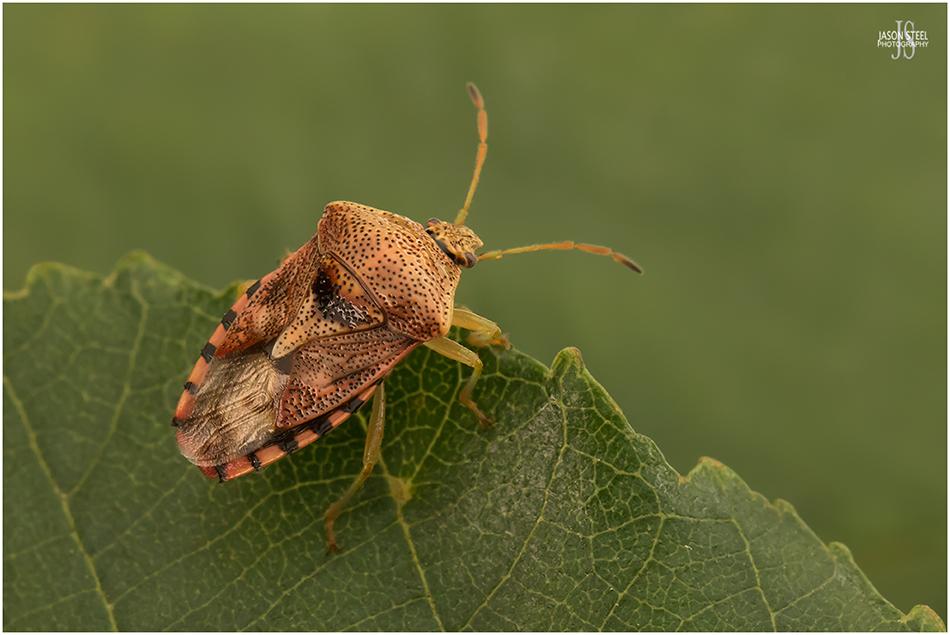
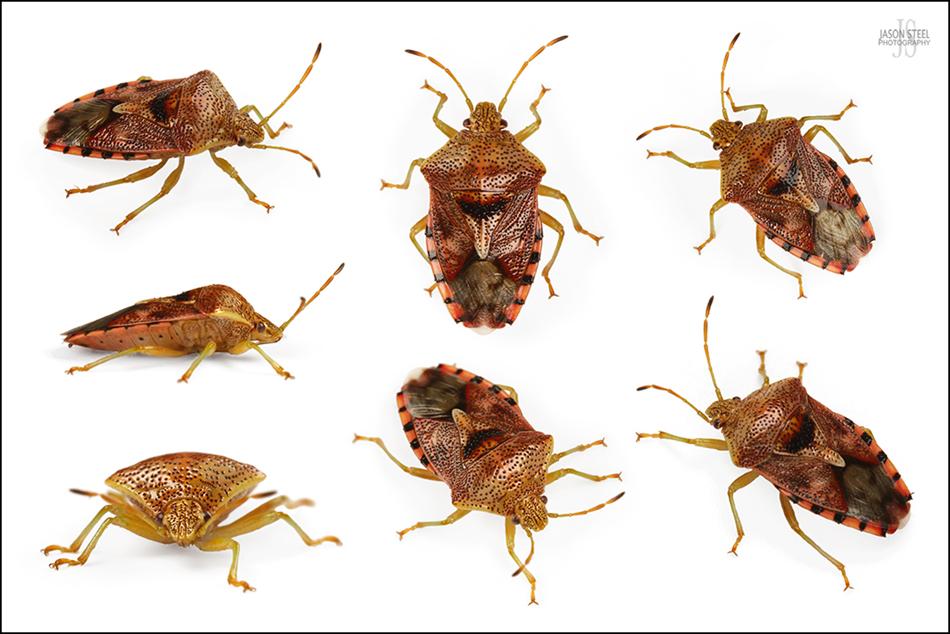
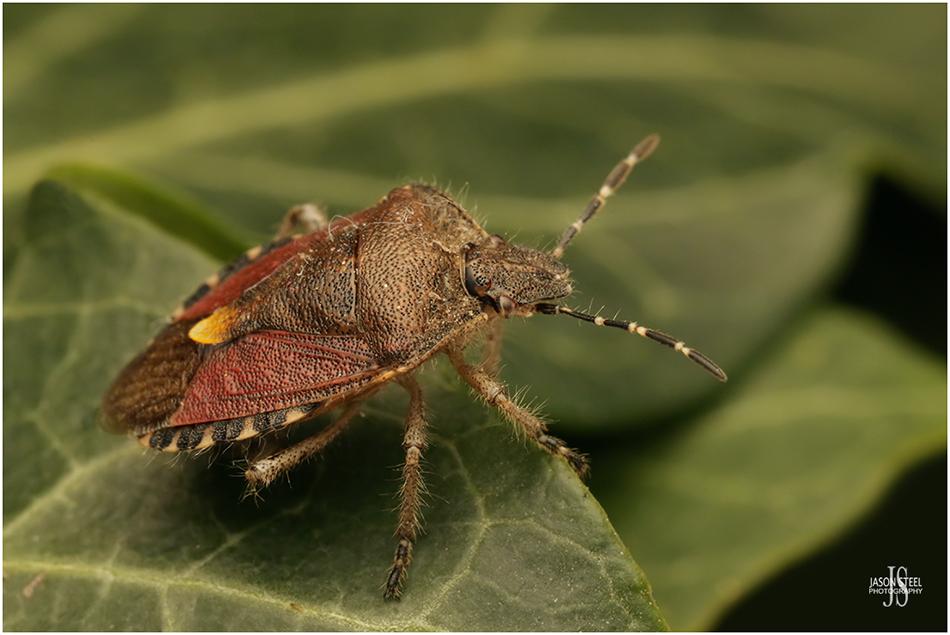
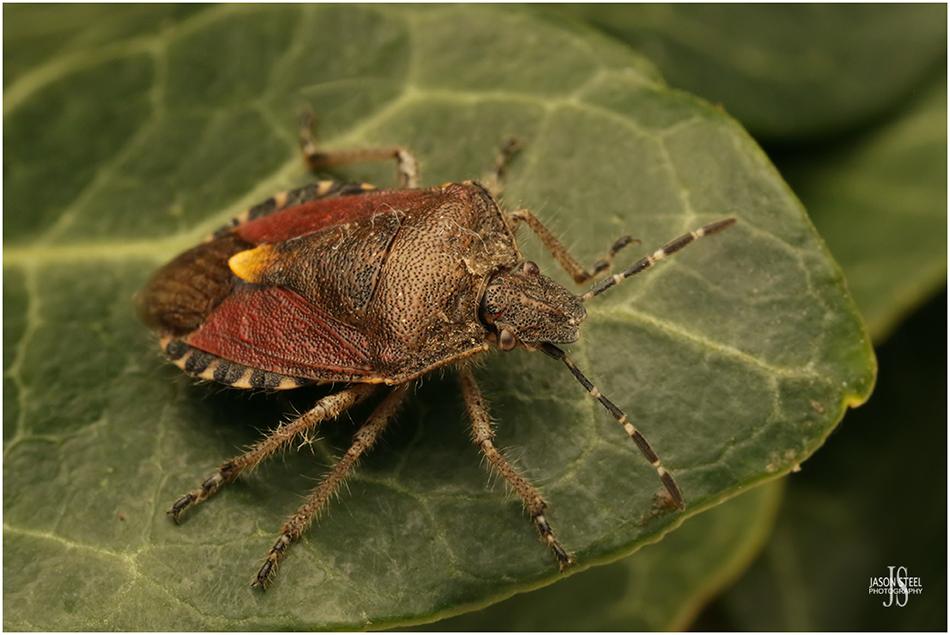
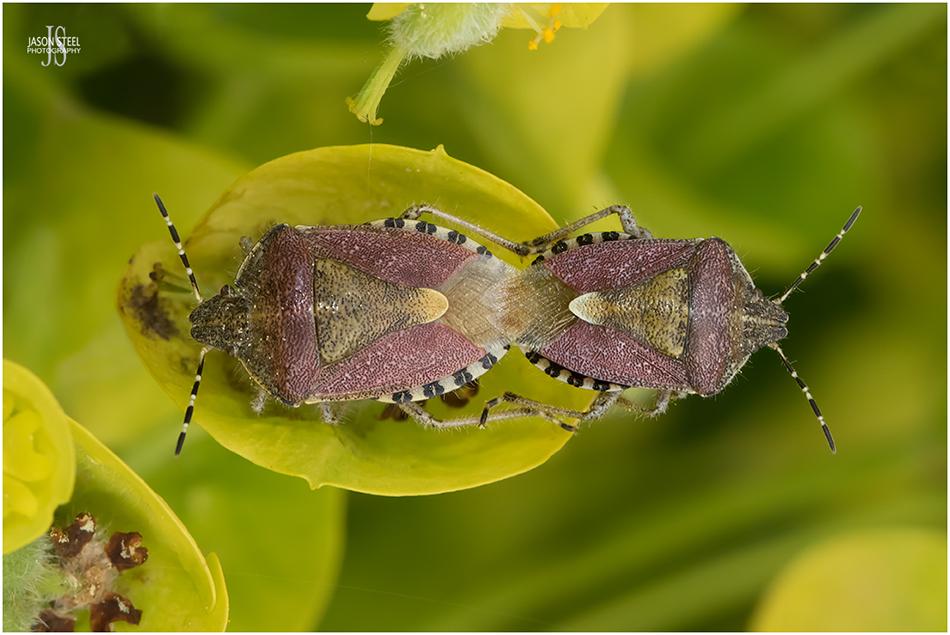
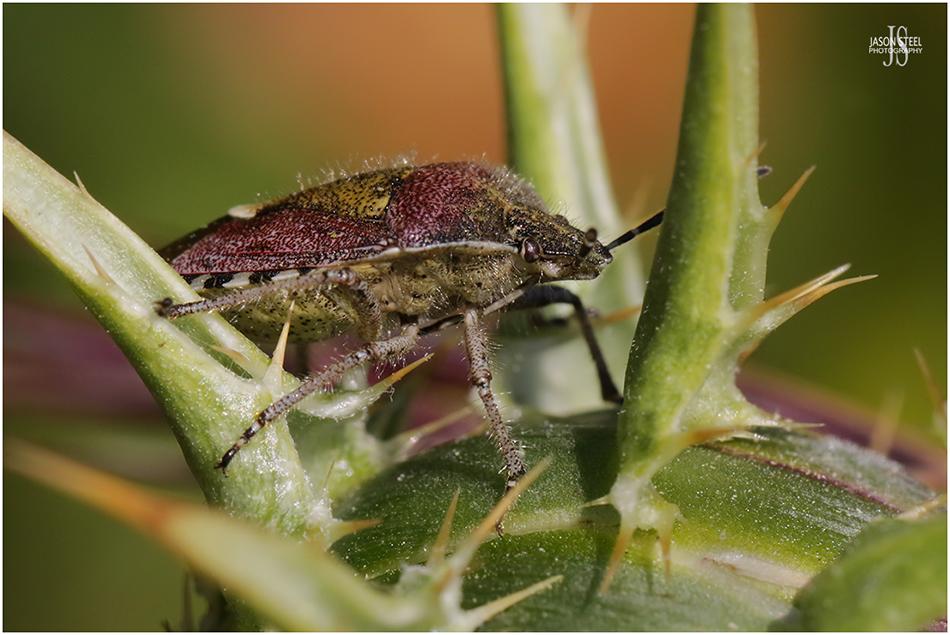
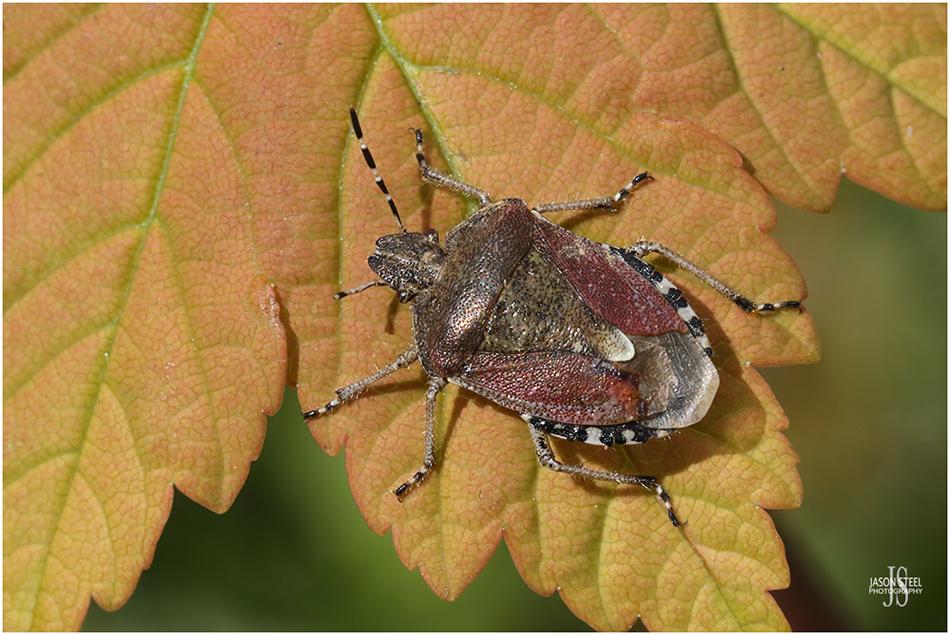
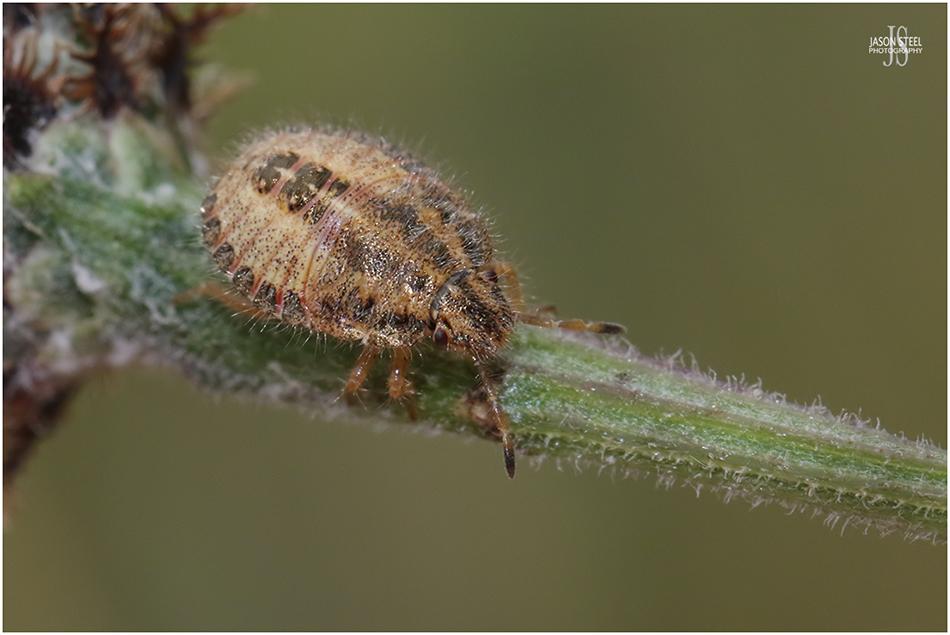
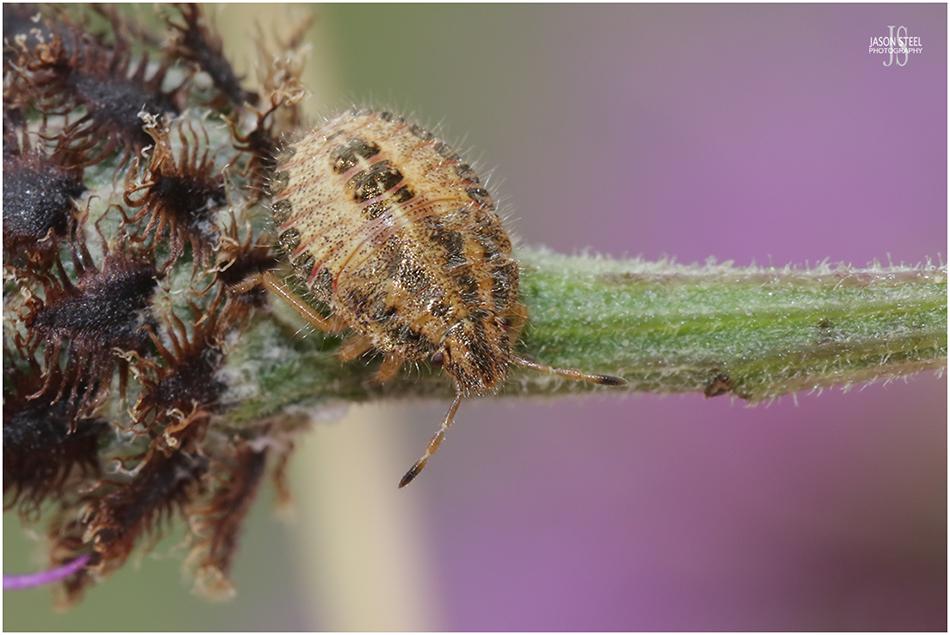
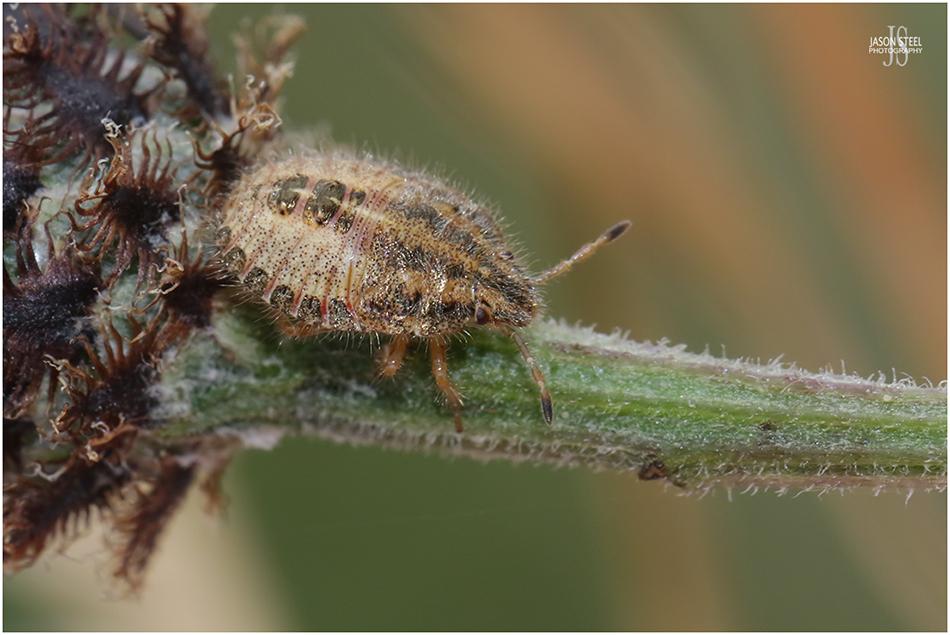
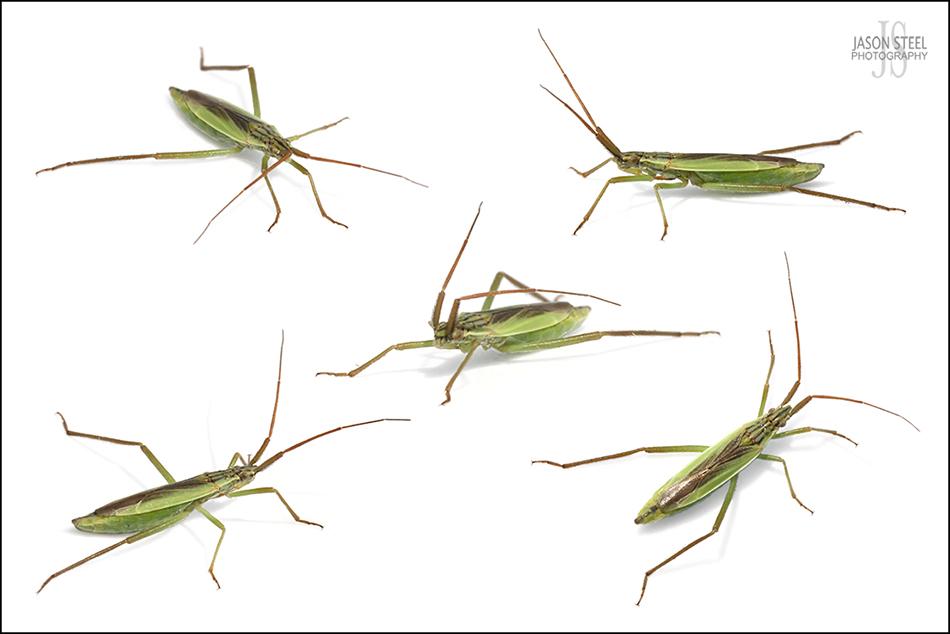
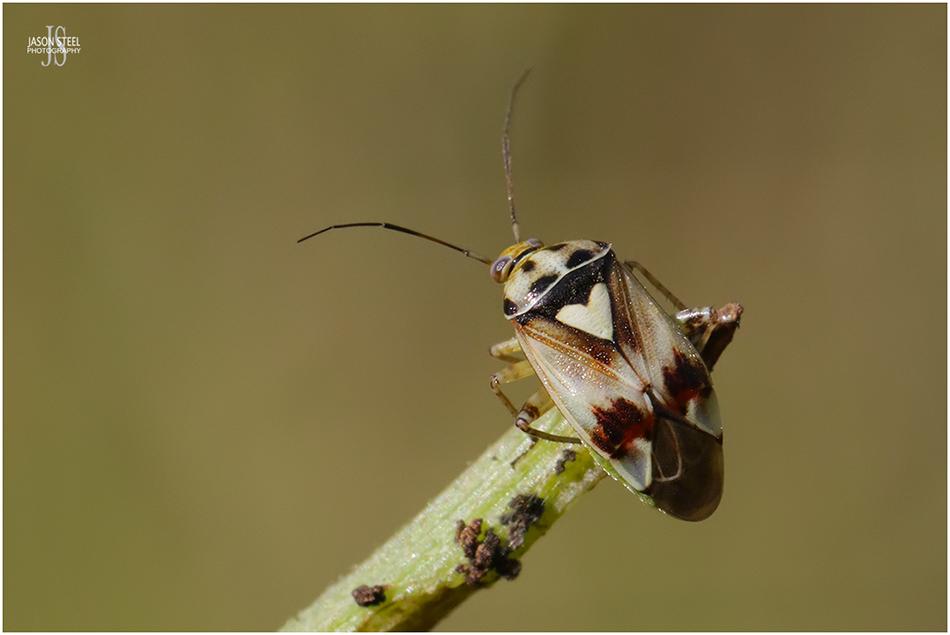
All Photographs on this page were taken using the Canon 40D / Canon 7D / Canon 7D mkII / Canon 5D mkIII cameras and the Canon 100mm 2.8L IS, fully manual Laowa Venus 15mm Wide-angle Macro lens, and the Sigma 14mm f/2.8 Wide-Angle lens.